Rolling Stones "Storm America" - US Tour 1969
The Stones make a claim for the high ground in 1969 with the Beatles broken-up and a new guitarist in the band whose main purpose is to facilitate touring and live performance which would have otherwise been doubtful with founding member Brian Jones whose ability to freely enter the US (drug busts) and play grueling consecutive nights and two shows a day would have been unpredictable at best. The Stones are more or less living together after the Hyde Park free concert on July 5, 1969. They stay at "Oriole House" in LA and are rehearsing at Stephen Stills' basement in Laurel Canyon prior to the tour launch on November 7, 1969. By the time they open in Colorado it's clear that this isn't the nervous unrehearsed line up that debuted in Hyde Park, they are loud and menacing. New guitarist Mick Taylor is blending in and band is coming together as a live force to be reckoned with. This is our journey through America 40 years on with "The Greatest Rock 'n' Roll Band In World"!
Jagger Cruising LA 1969
The Rolling Stones 1969 US Tour
* CD releases of the these shows exist.
"Catch Your Dreams (Before They Slip Away)"
Black Light Records, BL 101
State University, Fort Collins, Colorado, November 7, 1969
Sound Quality: Fair Audience
Jumpin' Jack Flash 4:34/Carol 3:39/Sympathy For The Devil 4:49/Stray Cat Blues 3:39/Midnight Rambler 9:14/Under My Thumb 3:50/Prodigal Son 3:42/Love In Vain 5:13/I'm Free 6:20/Little Queenie 4:45/Gimme Shelter 3:49/(I Can't Get No) Satisfaction 6:15/Honky Tonk Women 3:54/Street Fighting Man 4:06
Comments: A quiet college town 90 minutes drive north of Denver for a warm-up gig prior to West Coast performances. Highlights are the "new" song Midnight Rambler and I'm Free.
"Don't You Wanna Live With Me"
(TTCD-6405 DAC-071-1/2)
Sound Quality: Fair Audience. Kinda boomy.
CD 1: Sam Cutler Introduction 0:56/Jumpin' Jack Flash 3:58/Carol 3:51/Sympathy For The Devil 5:06/Stray Cat Blues 4:25/Midnight Rambler 9:02/Under My Thumb 3:57/Prodigal Son 3:58/Love In Vain 6:09/I'm Free 5:58/Little Queenie 4:57/Gimme Shelter 4:21/(I Can't Get No) Satisfaction 6:37/Honky Tonk Women 4:15/Street Fighting Man 4:37
"Kick Off The US Tour 1969"
One Hundred Club - Idol Mind Production
Introduction: Sam Cutler 0:54/Jumpin' Jack Flash 3:57/Carol 3:49/Sympathy For The Devil 5:05/Stray Cat Blues 4:27/Midnight Rambler 9:02/Under My Thumb 3:57/Prodigal Son 3:57/Love In Vain 6:09/I'm Free 5:55/Little Queenie 5:04/Gimme Shelter 4:18/Satisfaction 6:29/Honky Tonk Women 4:11/Street Fighting Man 4:32
"LA Queenie"
(RISK DISC 002)
LA Forum, California, November 8, 1969 1st Show
Sound Quality: Good Audience
Jumpin' Jack Flash 4:14/Carol 4:01/Sympathy For The Devil 5:19/Stray Cat Blues 4:47/Prodigal Son 4:02/Love In Vain 5:27/I'm Free 6:12/Midnight Rambler 8:13/Live With Me 4:02/Little Queenie 2:33/Satisfaction 6:22/Honky Tonk Women 4:22/Street Fighting Man 4:41
Comment: First release of LA November 8, 1969 (1st Show). Comes with a mini booklet of articles and photos from the '69 tour. Nice cardboard packaging.
"Welcome To The Breakfast Show"
(VGP - 337)
Vinyl Gang Product
LA Forum, November 8, 1969 1st Show
CD 1: Jumpin' Jack Flash 4:05/Carol 3:59/Sympathy For The Devil 5:15/Stray Cat Blues 4:44/Prodigal Son 3:59/Love In Vain 5:22/I'm Free 6:08/Midnight Rambler 8:10/Live With Me 3:58/Little Queenie 2:31/(I Can't Get No) Satisfaction 6:16/Honky Tonk Women 4:21/Street Fighting Man 4:38
"The First L.A. Forum 1969"
Jumpin' Jack Flash 4:06/Carol 3:56/Sympathy For The Devil 5:11/Stray Cat Blues 4:40/Prodigal Son 3:56/Love In Vain 5:18/I'm Free 6:03/Midnight Rambler 8:00/Live With Me 3:54/Little Queenie 2:31/Satisfaction 6:15/Honky Tonk Women 4:19/Street Fighting Man 4:09/Outro Announcer 0:27
Keith & his National Steel Guitar - Live '69
"L.A. 69 - Nov.8, - 2nd show"
(WP-69-1/2)
Outsider Bird Records
LA Forum, California, November 8, 1969 2nd Show
Side 1: Sam Cutler/Jumpin' Jack Flash/Carol/Sympathy For The Devil/Stray Cat Blues/Prodigal Son/You Gotta Move/Love In Vain Side 2: I'm Free/Under My Thumb/Live With Me/Little Queenie/Satisfaction/Honky Tonk Women/Street Fighting Man
Comment: Black & blue vinyl plus 45 rpm on blue wax - Sister Morphine (outtake) b/w Midnight Rambler 5:51
"Special Collector's Series Volume 18"
Comment: Re-issue of "L.A. 69" on black vinyl. Copy 19 of 130 pictured.
"Born In The Crossfire Hurricane"
(IFPI L601)
Jumpin' Jack Flash 4:07/Carol 3:31/Sympathy For The Devil 5:30/Stray Cat Blues 4:50/Prodigal Son 3:40/You Gotta Move 2:56/Love In Vain 5:04/I'm Free 6:01/Under My Thumb 3:11/Midnight Rambler 7:44/Live With Me 2:34/Little Queenie 4:13/(I Can't Get No) Satisfaction 5:51/Honky Tonk Women 3:48/Street Fighting Man 4:02
"Street Hassle In L.A."
Stonehenge 001
Carol 4:18/Sympathy For The Devil 5:32/Stray Cat Blues 4:48/Prodigal Son 3:45/You Got To Move 2:56/Love In Vain 5:20/I'm Free 6:09/Under My Thumb 3:17/Live With Me 3:24/Little Queenie 4:17 /(I Cant't Get No) Satisfaction 5:55/Honky Tonk Women 4:01/Street Fighting Men 4:00
"Lost Satanic Tour '69"
Picaresque Sound
Carol 3:59/Sympathy For The Devil 5:32/Stray Cat Blues 4:53/Prodigal Son 3:42/You Gotta Move 2:53/Love In Vain 5:22/I'm Free 5:35/Under My Thumb 3:04/Live With Me 3:53/Little Queenie 4:12/(I Can't Get No) Satisfaction 5:57/Honky Tonk Women 4:00/Street Fighting Man 4:01
"C0caine On A Dentist Chair"
(VGP-068-1)
CD 1: Intro By Sam Cutler 1:15/Jumpin' Jack Flash 3:45/Carol 3:46/Sympathy For The Devil 5:28/Stray Cat Blues 4:45/Prodigal Son 3:43/You Gotta Move 2:52/Love In Vain 5:16/I'm Free 6:06/Under My Thumb 3:17/Midnight Rambler 7:46/Live With Me 3:20/Little Queenie 4:12/(I Can't Get No) Satisfaction 5:48/Honky Tonk Women 3:55/Street Fighting Man 3:59
"Liver Than They'll Ever Be"
(305 020-1)
Alameda County Coliseum, Oakland, California, November 9, 1969 1st Show
Sound Quality: Very Good Audience
Sam Cutler Explains Being Late - Jumpin' Jack Flash 6:15/Prodigal Son 3:58/You Gotta Move 3:16/Carol 3:28/Sympathy For The Devil 6:49/Stray Cat Blues 4:13/Love In Vain 5:17/I'm Free 5:54/Under My Thumb 3:13/Midnight Rambler 8:07/Live With Me 3:58/Little Queenie 3:53/Satisfaction 6:51/Honky Tonk Women 4:14/Street Fighting Man 4:10
Comments: The amps blow during the Jumpin' Jack Flash opener. Taylor gets as close to the familiar riff as possible in standard tuning until his amp blows too. They switch to the acoustic set while the amps are being replaced. This show was first released about 10-12 years ago by OBR. It's the Trade Mark of Quality tape of the 1st show, so the sound quality is pretty good.
"Bring It Back Aliver"
Gold Standard
Sam Cutler - Jumpin' Jack Flash 5:49/Prodigal Son 4:16/You Gotta Move 3:13/Carol 4:03/Sympathy For The Devil 6:02/Stray Cat Blues 5:10/Love In Vain 5:12/I'm Free 3:58/Under My Thumb 3:37/Midnight Rambler 8:03/Live With Me 4:17/Little Queenie 4:11/(I Can't Get No) Satisfaction 5:32/Honky Tonk Women 5:08/Street Fighting Man 4:36
"Pot Boiler"
Sam Culter Introduction 1:31/Jumpin' Jack Flash 4:51/Prodigal Son 4:02/You Gotta Move 3:19/Carol 3:34/Sympathy For The Devil 6:56/Stray Cat Blues 4:18/Love In Vain 5:49/I'm Free 5:16/Under My Thumb 3:12/Midnight Rambler 8:22/Live With Me 4:01/Little Queenie 3:57/(I Can't Get No) Satisfaction 6:57/Honky Tonk Women 4:18/Street Figthing Man 4:04
"Secret Garden"
Jumpin' Jack Flash 6:24/Prodigal Son 4:02/You Gotta Move 3:19/Carol 3:32/Sympathy For The Devil 6:55/Stray Cat Blues 4:18/Love In Vain 5:19/I'm Free 4:35/Under My Thumb 3:12/Midnight Rambler 8:20/Live With Me 4:00/Little Queenie 3:56/Satisfaction 6:56/Street Fighting Man 4:15/Honky Tonk Woman 4:03
"Stone From The Bay"
(WBRCD 9014)
Wild Bird Records
Alameda County Coliseum, Oakland, California, November 9, 1969 2nd Show
Carol 3:45/Gimme Shelter 3:52/Sympathy For The Devil 6:16/I'm Free 5:22/Live With Me 3:03/Love In Vain 5:19/Midnight Rambler 8:04/Little Queenie 4:55/Honky Tonk Women 4:09/Street Fighting Man 4:04
Comments: Made from a fairly clean "Liver Than You'll Ever Be" LP.
"Have A Beer"
Teddy Bear Records
Comments: A repackaged copy of "Stone From The Bay" right down to the matrix number and running times.
"Vintage But Vigorous"
(WPOCM D052)
World Productions Of Compact Music
Carol 3:49/Gimme Shelter 3:51/Sympathy For The Devil 6:42/I'm Free 5:18/Live With Me 3:30/Love In Vain 5:20/Midnight Rambler 8:03/Little Queenie 5:01/Honky Tonk Women 4:01/Street Fighting Man 3:58
Comments: Made from a fairly clean "Liver Than You'll Ever Be" LP. Both this CD and "Stone From The Bay" have crackles in the same spot during the solo in I'm Free, so one of these may actually be a musical copy of the other.
"Live'r Than You'll Ever Be"
(TSP-CD-043)
The Swingin' Pig
Jumpin' Jack Flash 4:15 (New York, November 28, 1969 2nd)/Carol 3:43/Sympathy For The Devil 6:15/Stray Cat Blues 4:19/Prodigal Son 3:54/You've Gotta Move 3:12/Love In Vain 5:24/I'm Free 5:14/Under My Thumb 3:24 (San Diego, November 10, 1969)/Midnight Rambler 7:43/Live With Me 3:29/Gimme Shelter 4:19/Little Queenie 4:23/(I Can't Get No) Satisfaction 6:04/Honky Tonk Woman 3:59/Street Fighting Man 4:04
Comments: First CD release of this show from the Trade Mark of Quality tape source. Signal level fluctuations in the original recording resulted in the two song substitutions from other show sources as indicated.
"Revolution Sixtinine"
Great Dane Records
Jumpin' Jack Flash 4:13 (New York, November 28, 1969 2nd) /Carol 3:44/Sympathy for the Devil 6:16/Stray Cat Blues 4:19/Prodigal Son 3:51/You Gotta Move 3:14/Love in Vain 5:25/I'm Free 5:15/Under My Thumb 3:24 (San Diego, November 10, 1969) /Midnight Rambler 7:43/Live with Me 3:29/Gimme Shelter 4:19/Little Queenie 4:23/(I Can't Get No) Satisfaction 6:05/Honky Tonk Women 3:59/Street Fighting Man 4:05
Comments: Copy of The Swinging' Pig's "Live'r Than You'll Ever Be" .
"Liver Than You'll Ever Be"
Jumpin' Jack Flash 4:09/Carol 3:43/Sympathy for the Devil 6:27/Stray Cat Blues 4:08/Prodigal Son 3:49/You Gotta Move 3:28/Love in Vain 5:24/I'm Free 5:16/Under my Thumb 3:23/Midnight Rambler 7:42/Live With Me 3:30/Gimme Shelter 4:17/Little Queenie 4:21/(I Can't Get No) Satisfaction 6:01/Honky Tonk Women 4:04/Street Fighting Man 4:04
Comments: Contains original Oakland '69 2nd show versions of Jumpin' Jack Flash with level problems and a spliced Under My Thumb. Note the newer edition of this CD has the "for members only" logo on the disc.
Master Of Sounds
Jumpin' Jack Flash 4:05/Carol 3:43/Sympathy For The Devil 6:27/Stray Cat Blues 4:14/Prodigal Son 4:02/You Gotta Move 3:10/Love In Vain 5:24/I'm Free 5:07/Under My Thumb 2:44/Midnight Rambler 7:42/Live With Me 3:17/Gimme Shelter 4:24/Little Queenie 4:29/(I Can't Get No)Satisfaction 5:59/Honky Tonk Women 4:04/Street Fighting Man 4:03
Comments: All the original Oakland 2nd show songs but also the rawest in terms of the level problems. No attempts made here to smooth out the sound. Cardboard sleeve.
Turd On The Run Records
Jumpin' Jack Flash 4:07/Carol 3:43/Sympathy For The Devil 6:26/Stray Cat Blues 4:14/Prodigal Son 4:00/You Gotta Move 3:12/Love In Vain 5:24/I'm Free 5:07/Under My Thumb 3:24/Midnight Rambler 7:43/Live With Me 3:17/Gimme Shelter 4:25/Little Queenie 4:22/(I Can't Get No) Satisfaction 6:00/Honky Tonk Women 4:04/Street Fighting Man 4:04
Comments: Interestingly enough this CD has the original Jumpin' Jack Flash without the level problems. The thing that is interesting is that it's the TMoQ tape. Audience talking near the taper's microphone is the same as the Trade Mark tape, so this is no new source, maybe just nicely compensated. Best sound of all CD's in my opinion.
"From San Francisco to Paris"
(VGP-276-1)
Jumpin' Jack Flash 4:25/Carol 3:41/Sympathy For The Devil 6:23/Stray Cat Blues 4:15/Prodigal Son 3:52/You Gotta Move 3:14/Love In Vain 5:22/I'm Free 5:06/Under My Thumb 2:45/Midnight Rambler 7:41/Live With Me 3:30/Gimme Shelter 4:16/Little Queenie 4:20/(I Can't Get No) Satisfaction 5:58/Honky Tonk Women 4:02/Street Fighting Man 4:35
Comments: Contains original Oakland '69 2nd show versions of Jumpin' Jack Flash with sound drops and a partial version of Under My Thumb. Cover is a copy of the original Toasted (TMoQ) 2LP.
"The Rolling Stones Vol. 1"
Little Queenie 4:03/Gimme Shelter 3:55/Live With Me 3:05/Sympathy For The Devil 6:12/Carol 3:33
Comments: Five songs included on this compilation CD. Link: Click this Link for LP References of November 9, 1969 2nd Show
"Out Of Joint"
(RSBB-2004/5)
Black n' Blue
CD 1: Jumpin' Jack Flash 6:19/Prodigal Son 3:59/You Gotta Move 3:32/Carol 3:28/Sympathy For The Devil 6:48/Stray Cat Blues 4:17/Love In Vain 5:23/I'm Free 4:24/Under My Thumb 3:07/Midnight Rambler 8:27/Live With Me 3:52/Little Quenie 4:00/Satisfaction 6:54/Honky Tonk Woman 4:20/Street Fighting Man 4:02
CD 2: Jumpin' Jack Flash 4:08/Carol 3:43/Sympathy For The Devil 6:17/Stray Cat Blues 4:21/Prodigal Son 3:55/You Gotta Move 3:09/Love In Vain 5:24/I'm Free 5:09/Under My Thumb 2:44/Midnight Rambler 7:43/Live With Me 3:33/Gimme Shelter 4:19/Little Queenie 4:19/Satisfaction 5:59/Honky Tonk Women 3:54/Street Fighting Man 3:58
Comments: Oakland 2nd show has the original Jumpin' Jack Flash and Under My Thumb with some sound drop-outs.
(TCDRS-1-1/2)
CD 1: Sam Cutler Introduction 1:36/Jumpin' Jack Flash 4:51/Prodigal Son 4:03/You Gotta Move 3:18/Carol 3:33/Sympathy For The Devil 6:55/Stray Cat Blues 4:18/Love In Vain 5:13/I'm Free 5:08/Under My Thumb 3:15/Midnight Rambler 8:17/Live With Me 4:00/Little Queenie 3:56/Satisfaction 6:56/Honky Tonk Women 4:17/Street Fighting Man 4:03
CD 2: Jumpin' Jack Flash 4:04/Carol 3:44/Sympathy For The Devil 6:23/Stray Cat Blues 4:13/Prodigal Son 3:59/You Gotta Move 3:12/Love In Vain 5:24/I'm Free 5:07/Under My Thumb 3:23/Midnight Rambler 7:40/Live With Me 3:33/Gimme Shelter 4:18/Little Queenie 4:13/(I Can't Get No) Satisfaction 6:04/Honky Tonk Women 4:04/Street Fighting Man 4:10
Comments: Released in 2001 with 200 copies made. Oakland 2nd show has the same cleaned-up source for Jumpin' Jack Flash and Under My Thumb as the Turd On The Run Records release.
(SODD-013-R.S-SS)
Singer's Original
CD: Jumpin' Jack Flash 6:24/Prodigal Son 4:02/You Gotta Move 3:20/Carol 3:33/Sympathy For The Devil 6:56/Stray Cat Blues 4:18/Love In Vain 5:49/I'm Free 5:16/Under My Thumb 3:17/Midnight Rambler 8:16/Live With Me 4:03/Little Queenie 3:56/(I Can't Get No) Satisfaction 6:57/Honky Tonk Women 4:18/Street Fighting Man 4:04
CD-R: Jumpin' Jack Flash 4:25/Carol 3:41/Sympathy For The Devil 6:23/Stray Cat Blues 4:13/Prodigal Son 3:58/You Gotta Move 3:11/Love In Vain 5:22/I'm Free 5:04/Under My Thumb 2:45/Midnight Rambler 7:41/Live With Me 3:30/Gimme Shelter 4:22/Little Queenie 4:16/(I Can't Get No) Satisfaction 6:01/Honky Tonk Women 3:57/Street Fighting Man 4:35
Comments: The Oakland '69 2nd show CD-R is a clone copy of VGP-276-1 "From San Francisco to Paris" .
"Hangout"
Sound Quality: Very Good Soundboard (Broadcast). The sound is compressed.
Gimme Shelter 3:37/Sympathy For The Devil 5:53/Stray Cat Blues 3:23/Love In Vain 4:48/Live With Me 2:52/Prodigal Son 3:22/You Gotta Move 2:24/Little Queenie 3:49/Satisfaction 5:07/Honky Tonk Women 3:03/You Can't Always Get What You Want 4:39
Comment: Probably the first CD release of the infamous Oakland '69 soundboard.
"Oakland '69"
Sound Quality: Excellent Soundboard (Broadcast). Upgraded sound compared to "Hangout" .
Sympathy For The Devil 5:58/Stray Cat Blues 3:25/Prodigal Son 3:29/You Gotta Move 2:29/Love In Vain 5:06/Live With Me 2:53/Gimme Shelter 3:46/Little Queenie 3:52/Satisfaction 5:10 Bonus Tracks: Little Queenie 3:11/Whole Lotta Shakin' Going On 3:34 (Keith Richards with Jerry Lee Lewis, US TV July 16, 1983)
Comment: This title incorporates the official 1969 Tour Program artwork into the cover design. Best sound of the Oakland 2nd soundboard sources.
"Oakland Sixty-Nine"
Sound Quality: Very Good Soundboard (Broadcast). Lotsa tape hiss.
CD Run-TIme (36:49): Sympathy For The Devil 6:15/Stray Cat Blues 3:29/Prodigal Son 3:27/You Gotta Move 2:42/Love In Vain 4:49/Live With Me 3:08/Gimme Shelter 3:44/Little Queenie 4:00/(I Can't Get No) Satisfaction 5:20
Comment: Cover artwork is from the classic vinyl release of the same material.
"Oakland Coliseum Arena 1969 FM-SB"
Sound Quality: Very Good Soundboard (Broadcast). Somewhat compressed and bassy.
Sympathy For The Devil 6:04/Stray Cat Blues 3:28/Prodigal Son 3:31/You Gotta Move 2:30/Love In Vain 4:57/Live With Me 2:55/Gimme Shelter 3:48/Little Queenie 3:54/Satisfaction 5:17/Brown Sugar (Hot Rocks Aternate Version) 3:51/Wild Horses (Hot Rocks Aternate Version) 5:45
Keith Richards Live 1969
"Stoneaged"
(RS 545-A/B)
Trade Mark Of Quality
Sports Arena, San Diego, California, November 10, 1969
Side 1: Sam Cutler Introduction/Carol/Sympathy For The DevilProdigal Son/You Gotta Move/Under My Thumb Side 2: Live With Me/Little Queenie/Satisfaction/Honky Tonk Woman/Street Fighting Man
"San Diego '69"
Sound Quality: Very Good to Excellent Audience
Carol 4:04/Sympathy For The Devil 6:32/Prodigal Son 4:00/You Gotta Move 2:45/Under My Thumb 3:09/Live With Me 3:06/Little Queenie 4:00/Satisfaction 6:03/Honky Tonk Woman 4:30/Street Fighting Man 4:02/Leather Jacket 3:21 ("Trident" instrumental outtake)
Comment: This is Rock 'n' Roll baby. By San Diego the "Engine Room" is starting to congeal. This show was taped by the same taper using the same equipment as Oakland, so the same sort of presence and frequency response in this recording. Even though this old CD was made from a very clean LP I like it the best. Raw and gritty. No digital signal processing rework to juice the sound.
"San Diego Sixty-Nine"
TMoQ (Vinyl Gang Product)
Sam Cutler Introduction - Jumpin' Jack Flash 4:13/Carol 3:48/Sympathy For The Devil 5:43/Stray Cat Blues 4:27/Prodigal Son 3:59/You Gotta Move 3:14/Love In Vain 5:28/I'm Free 5:44/Under My Thumb 2:57/Midnight Rambler 6:39/Live With Me 3:05/Little Queenie 4:08/(I Can't Get No) Satisfaction 6:06/Honky Tonk Women 4:30/Street Fighting Man 4:06
Comment: The reason why Jumpin' Jack Flash wasn't on any of the classic Trade Mark of Quality LP releases is because even though the Stones got better by the time they reached San Diego the taper (who shall remain nameless) didn't. He would set the recording levels on the first song thereby rendering it nearly useless. The trick here is to try and get the levels during the warm-up acts, just to get you in the "ball park", then a little careful tweaking when the Stones hit the main PA's. Also note that since this is made from the Trade Mark tape that the complete show is now in circulation.
(TSP CD 214)
Sam Cutler Introduction - Jumpin' Jack Flash 4:19/Carol 3:49/Sympathy For The Devil 5:43/Stray Cat Blues 4:27/Prodigal Son 4:12/You Gotta Move 2:50/Love In Vain 5:33/I'm Free 5:36/Under My Thumb 3:18/Midnight Rambler 7:17/Live With Me 3:05/Little Queenie 4:08/(I Can't Get No) Satisfaction 5:54/Honky Tonk Women 4:30/Street Fighting Man 4:06
Comment: Level problems on Jumpin' Jack Flash spliced and corrected.
"Nasty Habits, Water Rats, & A Woman's Touch"
Sister Morphine
Sam Cutler Introduction 0:42/Jumpin' Jack Flash 3:32/Carol 3:48/Sympathy For The Devil 5:44/Stray Cat Blues 3:44/Prodigal Son 4:42/You Gotta Move 2:43/Love In Vain 5:51/I'm Free 5:20/Under My Thumb 3:20/Midnight Rambler 7:24/Live With Me 3:11/Little Queenie 4:11/(I Can't Get No) Satsifaction 5:26/Honky Tonk Women 4:38/Street Fighting Man 4:24
Comment: Sourced from The Swingin' Pig release.
(RS3-SAN DIEGO)
Jumpin' Jack Flash 4:18/Carol 3:49/Sympathy For The Devil 5:43/Stray Cat Blues 4:27/Prodigal Son 4:12/You Gotta Move 2:50/Love In Vain 5:33/I'm Free 5:36/Under My Thumb 3:18/Midnight Rambler 7:17/Live With Me 3:05/Little Queenie 4:08/Satisfaction 5:54/Honky Tonk Women 4:30/Street Fighting Man 4:06/Jumpin' Jack Flash 3:29 (from the London, Saville Theatre gig on December 14, 1969)
Comment: Same source as The Swingin' Pig. Digipak.
"It's No Hangin Matter"
(VGP-096-1)
CD 1: Jumping Jack Flash 4:14/Carol 3:45/Sympathy For The Devil 5:40/Stray Cat Blues 4:24/Prodigal Son 3:58/You Gotta Move 3:11/Love In Vain 5:27/I'm Free 5:41/Under My Thumb 2:57/Midnight Rambler 6:36/Live With Me 3:03/Little Queenie 4:06/(I Can't Get No) Satisfaction 6:02/Honky Tonk Women 4:28/Street Fighting Man 4:04
"Second Incarnation"
(VGP-369-1)
Sound Quality: Fair to Good Audience
Introduction: Sam Cutler 3:41/Jumpin' Jack Flash 3:34/Carol 3:48/Sympathy For The Devil 5:44/Stray Cat Blues 4:28/Prodigal Son 3:57/You Gotta Move 3:17/Love In Vain 5:30/I'm Free 5:46/Under My Thumb 3:04/Midnight Rambler 7:20/Live With Me 3:09/Little Queenie 4:05/Satisfaction 6:06/Honky Tonk Women 4:31/Street Fighting Man 4:10
Comment: This was made from a different and inferior tape source than the Trade Mark Of Quality release and all other derivatives. It sucks, avoid it like the plague.
Rare "blue omega/Leo" shot of Jagger 1969 Belt on the stage means this was taken during Midnight Rambler...
"Gathering Madness - Phoenix '69"
Phoenix Coliseum, Phoenix, Arizona, November 11, 1969
Sound Quality: Good to Very Good Audience
Jumpin' Jack Flash 4:20/Carol 3:37/Sympathy For The Devil 5:51/Stray Cat Blues 4:01/Prodigal Son 3:41/You Gotta Move 2:29/Love In Vain 5:40/Under My Thumb 3:08/Midnight Rambler 8:02/Live With Me 3:53/Gimme Shelter 4:07/Little Queenie 2:35/Brown Sugar (Altamont 1969) 3:44
Comment: The recording level is pretty saturated, so some distortion overall on the louder numbers. Batteries are loosing their charge by Little Queenie, so the show is also incomplete for this reason.
Mick Jagger Live in '69
"Sky Pilots"
Comment: CD 1 is a reissue of "Gathering Madness"
(VGP-068-2)
(see artwork in LA, November 8th section)
Assembly Hall, University Of Illinois, Champaign, Illinois, November 15, 1969 1st Show
CD 2: Sam Cutler & Mick Jagger Introduction 0:56/Jumpin' Jack Flash 3:49/Carol 3:43/Sympathy For The Devil 5:46/Stray Cat Blues 4:09/Love In Vain 6:01/Prodigal Son 3:39/You Gotta Move 2:27/Under My Thumb 1:28/Midnight Rambler 8:53/Little Queenie 4:24/(I Can't Get No) Satisfaction 6:26/Honky Tonk Women 4:31/Street Fighting Man 3:52
Comment: Jagger is having way too much fun being in the heartland of America. Sound problems at the beginning of Jumpin' Jack Flash are from the digital age. VGP jacking with the noise reduction and EQ on the recorded tape. Really lazy to use this.
"Vintage Champaign"
(TTCD-7682 DAC-081-1/TTCD-7683 DAC-081-2)
Dog n Cat Records
Assembly Hall, University of Illinois, Champaign, November 15, 1969 1st Show
CD 1: Sam Cutler & Mick Jagger Introduction 0:55/Jumpin' Jack Flash 3:46/Carol 3:41/Sympathy For The Devil 5:42/Stray Cat Blues 4:07/Love In Vain 5:59/Prodigal Son 3:37/You Gotta Move 2:25/Under My Thumb 1:18 (Tape Change) /Midnight Rambler 9:00/Little Queenie 4:23/(I Can't Get No) Satisfaction 6:25/Honky Tonk Women 4:33/Street Fighting Man 3:48
Palaido Palazzo Dello Sport, Milan, Italy, October 1, 1970 2nd Show
Sound Quality: Good To Very Good Audience
CD 2: Jumpin' Jack Flash 3:45/Roll Over Beethoven 2:32/Stray Cat Blues 4:11/Prodigal Son 1:31/Dead Flowers 4:04/Midnight Rambler 10:10
Assembly Hall, University of Illinois, Champaign, November 15, 1969 2nd Show (Partial)
Midnight Rambler 8:28 (In Progress)/Little Queenie 4:19/Satisfaction 6:13/Honky Tonk Women 4:15/Street Fighting Man 4:00
Comment: CD 1 also issued as "C0cain On A Dentist Chair" on VGP-068. Sound problems with Jumpin' Jack Flash corrected on this release. First six tracks CD 2 are from the audio track of a 1970 Super 8 video.
"We Didn't Really Get It On Until Detroit"
(Side 1/-4/-2/-3)
Olympia Stadium, Detroit, Michigan, November 24, 1969
Side 1: Jumpin' Jack Flash/Carol/Sympathy For The Devil Stray Cat Blues/Love In Vain/Prodigal Son/You Gotta Move/Under My Thumb Side 3: Midnight Rambler/Live With Me/Little Queenie Side 4: Satisfaction/Honky Tonk Women/Street Fighting Man
Comment: This LP is rare.
"Live From Detroit"
(3-1/2/3/4)
Bash Records
Comment: Copy of 2LP "We Didn't Really Get It On Until Detroit" .
"R.S."
(S-1/S2/S4A/S4-B)
"We Never Really Got It On Till Detroit"
Contra Band Music
Side 1: Jumpin' Jack Flash/Carol/Sympathy For The Devil/Stray Cat Blues/Love In Vain/Prodigal Son/You Gotta Move/Under My Thumb Side 2: Little Queenie / Satisfaction/Honky Tonk Women/Street Fighting Man
Comment: This is a single LP release, so it's a partial show. Midnight Rambler and Live With Me are missing.
"Mick Taylor We Thank You"
Tongue-In-Cheek
Side 2: Sympathy For The Devil/Stray Cat Blues/Little Queenie
Comment: Three sound board tracks from Detroit included on Side 2.
The Space Monkey Records
Comment: Repackage of the above title and LP.
"Live From Detroit 1969"
Minotauro Records
Jumpin' Jack Flash 4:16/Carol 3:56/Sympathy For The Devil 7:07/Stray Cat Blues 3:46/Love In Vain 5:27/Prodigal Son 3:41/You Got To Move 2:23/Under My Thumb 3:31/Midnight Rambler 10:17/Live With Me 3:09/Little Queenie 4:06/Satisfaction 6:28/Honky Tonk Woman 4:08/Street Fighting Man 3:54
"Hawaiian Top"
Weeping Goat
CD 2: Sympathy For The Devil 7:12/Stray Cat Blues 3:46/Little Queenie 4:08
Comment: Three sound board tracks from Detroit included on CD 2.
(VGP-369-2)
(see artwork in San Diego, November 10th section)
Spectrum Sports Arena, Philadelphia, Pennsylvania, November 25, 1969
Sound Quality: Fair Audience. Distant.
Jumpin' Jack Flash 3:53/Carol 4:03/Sympathy For The Devil 7:55/Stray Cat Blues 3:39/Love In Vain 4:54/Prodigal Son 3:19/Under My Thumb 4:02/Midnight Rambler 7:48/Live With Me 3:05/Little Queenie 4:03/Satisfaction 7:18/Honky Tonk Women 3:52/Street Fighting Man 3:41
"Devil's Disciple"
Raring Records
Baltimore Civic Center, Baltimore, Maryland, November 26, 1969
Side 1: Carol/Sympathy For The Devil/Love In Vain/Under My Thumb-I'm Free Side 2: Stray Cat Blues/Midnight Rambler/Live With Me/Satisfaction/Honky Tonk Women
"Baltimore 1969"
Digger Productions
Performance: Excellent
Jumpin' Jack Flash 3:51/Carol 3:49/Sympathy For The Devil 10:52/Stray Cat Blues 4:03/Love In Vain 5:40/You Gotta Move 1:58/Under My Thumb-I'm Free 6:49/Midnight Rambler 8:53/Live With Me 3:54/(I Can't Get No) Satisfaction 6:01/Honky Tonk Women 3:14
Comment: Probably the first release of this show on CD. Note that it is a partial recording of the show. Interestingly enough, Jagger does a "Hey Jude" verse at the outro of Sympathy For The Devil!
"A Shot of Salvation"
(OM90-64-17)
Scorpio Records
Sound Quality: Excellent Soundboard
Love In Vain 5:10
"Live In Washington 1969 & More"
Moonlight Records
Jumpin' Jack Flash 4:34/Carol 3:37/Sympathy For The Devil 10:38/Stray Cat Blues 3:56/Love In Vain 4:54/Jumping Jack Flash 4:31/Satisfaction 5:32/Love In Vain 4:07/Honky Tonk Women 4:17/Sympathy For The Devil 10:55/Under My Thumb 4:27/Gimme Shelter (Gimme Shelter Movie Mix) 2:05
Jumpin' Jack Flash 3:56/Carol 3:39/Sympathy For The Devil 10:40/Stray Cat Blues 4:00/Love In Vain 5:27/You Gotta Move 2:00/Under My Thumb-I'm Free 7:05/Midnight Rambler 8:20/Live With Me 3:32/(I Can't Get No) Satisfaction 5:51/Honky Tonk Women 3:10/Little Queenie 4:09
"Stoned-M.S.G."
(102 - A/B)
Head Records
Madison Square Garden, New York, New York, November 27, 1969
Side 1: Jumpin' Jack Flash/Carol/Sympathy for the Devil/Under My Thumb-I'mFree (medley)
Side 2: Midnight Rambler/Love In Vain/Satisfaction/Honky Tonk Women
Comment; "Stoned-M.S.G." provided the earliest look at the level of overdubbing that took place on "Ya-Ya's". There are at least two variations of the disc; one with a plain white jacket, and the other with a dark (TMoQ) green jacket.
"Play With Fire"
Trade Mark of Quality
Side 2: Under My Thumb-I'm Free(medley)/Satisfaction/Honky Tonk Women
Comment: The TMoQ matrix is scratched out and replaced with (HHCER108-A/B). This matrix is indicative of the TMoQ front label Highway Hi-Fi.
"Who Killed Brian"
(HHCER108-A/B)
Dreamlab Records
Comment: A reissue of "Play With Fire" using a reworked "Reggae 'n' Roll" cover as its artwork. 100 numbered copies were made.
"Stoned-M.S.G. 1969"
Jumpin' Jack Flash 4:28/Carol 3:33/Sympathy for the Devil 7:52/Stray Cat Blues 4:04/Love In Vain 5:02/Prodical Son 2:48/You Gotta Move 2:27/Under My Thumb-I'm Free 6:40/Midnight Rambler 9:29/Live With Me 3:05/Little Queenie 4:12/(I Can't Get No) Satisfaction 6:03/Honky Tonk Women 3:14/Street Fighting Man 4:36
"M.S.G. 69"
(HLRR 5010)
Hot Lips Records
Jumpin' Jack Flash 4:07/Carol 4:02/Sympathy For The Devil 7:57/Stray Cat Blues 3:57/Love In Vain 5:29/Prodigal Son 3:10/You Gotta Move 2:43/Under My Thumb 4:02/I'm Free 2:46/Midnight Rambler 9:30/Live With Me 3:32/Little Queenie 4:27/Satisfaction 5:40/Honky Tonk Women 3:58/Street Fighting Man 7:27
(VGP-096-02)
CD 2: Jumpin' Jack Flash 4:26/Carol 3:32/Sympathy For The Devil 7:50/Stray Cat Blues 4:03/Love In Vain 5:09/Prodigal Son 3:02/You Gotta Move 2:13/Under My Thumb - I'm Free 6:39/Midnight Rambler 9:30/Live With Me 3:10/Little Queenie 4:07/(I Can't Get No) Satisfaction 6:03/Honky Tonk Women 3:20/Street Fighting Man 4:28
"New York City - The Big Apple - 1969"
Concert Introduction_ 0:44/Jumping Jack Flash 3:42/Carol 3:31/Sympathy For The Devil 7:44/Stray Cat Blues 3:38/Love In Vain 5:17/Prodigal Son 3:20/You Gotta Move 2:22/Under My Thumb 3:36-I'm Free 3:05 (Medley)/Midnight Rambler 8:52/Live With Me 3:43/Little Queenie 4:12/(I Can't Get No) Satisfaction 5:40/Honky Tonk Women 3:32/Street Fighting Man 4:35
"Madison Square Garden New York- November 27, 1969"
Penetration Records
Jumpin' Jack Flash 4:30/Carol 3:30/Sympathy For The Devil 7:51/Stray Cat Blues 3:56/Love In Vain 4:43/Prodigal Son/You Gotta Move 5:41/Under My Thumb 3:44/I'm Free 3:26/Midnight Rambler 8:42/Live With Me 3:09/Little Queenie 4:06/(I Can't Get No) Satisfaction 6:02/Honky Tonk Women 3:20/Street Fighting Man 4:01
"Live In New York"
Idol Mind Productions
CD 1: Jumpin' Jack Flash 4:21/Carol 3:26/Sympathy For The Devil 7:41/Stray Cat Blues 3:57/Love In Vain 4:34/Prodigal Son 3:17/You Gotta Move 2:19/Under My Thumb-I'm Free 6:31/Midnight Rambler 8:39/Live With Me 3:43/Little Queenie 4:07/Satisfaction 5:55/Honky Tonk Women 3:10/Street Fighting Man 4:29
Madison Square Garden, New York, New York, November 28, 1969 2nd Show
CD 2: Jumpin' Jack Flash 3:31/Carol 3:26/Sympathy For The Devil 7:45/Stray Cat Blues 3:19/Love In Vain 5:21/Prodigal Son 3:27/You Gotta Move 2:18/Under My Thumb 3:37/Midnight Rambler 9:00/Live With Me 2:52/Little Quennie 4:01/Satisfaction 6:13/Honky Tonk Women 2:56/Street Fighting Man 3:34
Link: Check this web site for complete analysis of the New York "Get Yer Ya-Ya's Out!" & "Gimme Shelter" shows
"That's No Way To Get Along"
Morganfield
Boston Garden, Boston, Massachusetts, November 29, 1969
Jumping Jack Flash 4:01/Carol 3:26/Sympathy For The Devil 7:30/Stray Cat Blues 3:36/Love In Vain 5:12/Prodigal Son 3:29/You Gotta Move 2:05/Under My Thumb 4:02/Midnight Rambler 9:03/Live With Me 4:01/Little Queenie 4:00/(I Can't Get No) Satisfaction 5:51/Honky Tonk Women 3:29/Street Fighting Man 3:32
"Some Satanic Tour"
(DAC-015-1/2)
Civic Center, Baltimore, Maryland, November 26, 1969
CD 1: Sam Cutler Intro - (Audience marker: Girl - "Can you see his t-shirt?; Guy - ...his uncle sam hat") Jumpin' Jack Flash 4:32/Carol 3:34/Sympathy For The Devil 10:34/Stray Cat Blues 3:58/Love In Vain 5:26/You Gotta Move 1:56/Under My Thumb-I'm Free 6:52/Midnight Rambler 8:43/Live With Me 3:32/Satisfaction 5:51/Honky Tonk Women 3:23/Street Fighting Man 4:16 (Audience marker: The girl speaking at the end of the tape is the same voice as the beginning, so no splice on SFM. It's the missing song!)
The Boston Garden, Boston, Massachusetts, November 29, 1969, 2nd show
Sound Quality: Good Audience. You can even hear piano in spots, but the drums are nearly lost in an otherwise balanced audience mix.
CD 2: Sam Cutler Intro-Jumpin' Jack Flash 4:19/Carol 3:33/Sympathy For The Devil 7:54/Stray Cat Blues 3:49/Love In Vain 5:38/Prodigal Son 3:39/You Gotta Move 2:09 (missing opening chords, must be a tape change)/Under My Thumb 3:49/Midnight Rambler 10:26/Live With Me 3:42/Little Queenie 4:16/Satisfaction 6:16/Honky Tonk Women 3:32/Street Fighting Man 3:42
Comments: The cover shot is taken from an early 70's poster. This release uses different tape sources than both "Baltimore 1969" and VGP's "Devil's Disciple" which have tape stops at the end of show (the taper is clearly running out of tape as Street Fighting Man is also missing). This release is from the same (better) tape source as "Live In Washington 1969 & More" except that it includes the last song Street Fighting Man. In addition to the audience "marker" noted above, I checked SFM against the New York audience sources just to be sure, and they are different. This is really the missing SFM. See "Well You Heard About The Boston...Live 1969" on the Exile label for comments on the Boston '69 recording.
"Well You Heard About The Boston...Live 1969"
(EXCD - 038)
Exile Original Masters
(No Sam Cutler Intro) Jumpin' Jack Flash 4:11/Carol 3:28/Sympathy For The Devil 7:42/Stray Cat Blues 3:44/Love In Vain 5:35/Prodigal Son 3:28/You Gotta Move 2:07 (missing opening chords, must be a tape change)/Under My Thumb 3:41/Midnight Rambler 10:11/Live With Me 3:36/Little Queenie 4:09/Satisfaction 6:07/Honky Tonk Women 3:27/Street Fighting Man 3:36
Comment: This is a the same tape source as the release "That's No Way To Get Along" on the Morgonfield label (MG-004) and also by Dog n Cat Records on the release "Some Satanic Tour" (DAC-015). It has been sonically enhanced in a rather remarkable way with a limited amount of added hiss.
"Have You Heard About The Boston..."
(TOURING HI)
Bad Wizard (Touring History Vol. 7)
Boston Garden, Boston, Massachusetts, November 29, 1969, 2nd Show
Jumpin' Jack Flash 4:12/Carol 3:27/Sympathy For The Devil 7:42/Stray Cat Blues 3:44/Love In Vain 5:35/Prodigal Son 3:28/You Gotta Move 2:09/Under My Thumb 4:37/Midnight Rambler 9:13/Live With Me 3:37/Little Queenie 4:10/(I Can't Get No) Satisfaction 6:07/Honky Tonk Women 3:27/Street Fighting Man 3:36
Comment: Also released from the same (Bit-Torrent) source as "Well You Heard About The Boston...Live 1969" on Exile Records, and "Some Satanic Tour" DAC-15. This show originaly released as "That's No Way To Get Along" on Morganfield MG-004 on an inferior source (Fair to Good Audience).
"Palm Beach 1969"
International Raceway, West Palm Beach, Florida, November 30, 1969
Sound Quality: Fair to Very Good Audience. Tape speed problems.
Sam Cutler Diatribe 1:53/Jumpin' Jack Flash 3:42/Carol 3:55/Sympathy For The Devil 7:58/Stray Cat Blues 4:37/Love In Vain 5:13/Under My Thumb 3:33/Midnight Rambler 10:28/Gimme Shelter 5:09/Live With Me 3:27/Little Queenie 4:44/Satisfaction 6:18/Honky Tonk Women 3:19/Street Fighting Man 3:37
Comment: It was billed as "Woodstock South". The Stones arrived late in the night due to airport delays. It was freezing cold. Note that the acoustic set was omitted from this festival performance.
"One Day Before From Altermont!!"
Shaved Disc
Sam Cutler Diatribe 1:20/Jumpin' Jack Flash 4:13/Carol 3:55/Sympathy For The Devil 7:46/Stray Cat Blues 4:32/Love In Vain 5:08/Under My Thumb 4:52/Midnight Rambler 9:01/Gimme Shelter 4:58/Live With Me 3:21/Little Queenie 4:37/Satisfaction 6:17/Honky Tonk Women 3:22/Street Fighting Man 3:43
"Miami Pop Festival"
Sam Cultler Introduction 1:51/Jumpin' Jack Flash 3:51/Carol 4:04/Sympathy For The Devil 8:16/Stray Cat Blues 4:47/Love In Vain 5:29/Under My Thumb 5:01/Midnight Rambler 9:27/Gimme Shelter 5:19/Live With Me 3:35/Little Queenie 4:55/(I Can't Get No) Satisfaction 6:33/Honky Tonk Women 3:39/Street Fighting Man 3:31
Comment: Newer "For Members Only Not For Sale" edition is on a gold CD.
"Altamont"
Altamont Motor Speedway, Livermore, California, December 6, 1969
Side 1: Jumpin' Jack Flash/Carol/Sympathy For The Devil I/Sympathy For The Devil II/The Sun Is Shining Side 2: Stray Cat Blues/Love In Vain/Under My Thumb I/Under My Thumb II/Brown Sugar
"Altamont '69"
Side 1: Carol/Sympathy For The Devil I/Sympathy For The Devil II/Stray Cat Blues/Love In Vain Side 2: Under My Thumb I/Under My Thumb II/Midnight Rambler/Live With Me/Gimme Shelter/Little Queenie
Comment: LP on red splash vinyl.
CD 1: Jumpin' Jack Flash 3:58/Carol 3:43/Sympathy For The Devil 12:33/The Sun Is Shining 4:23/Stray Cat Blues 3:40/Love In Vain 5:28/Under My Thumb I & II 7:43/Brown Sugar 3:17
CD 2: Midnight Rambler 10:35/Live With Me 3:19/Gimme Shelter 4:39/Little Queenie 4:29/(I Can't Get No) Satisfaction 7:14/Honky Tonk Women/Street Fighting Man 3:54/Gimme Shelter (Studio Outtake) 4:23
Comment: This was released in the early 90's as a small and large 12" box set. It was the first time the complete concert had been released and was really pretty amazing to have at the time.
"Altamont Speed Way"
Carol 4:28/Sympathy For The Devil 12:40/The Sun Is Shining 4:26/Stray Cat Blues 3:42/Love In Vain 5:30/Under My Thumb 6:46/Midnight Rambler 10:35/Live With Me 3:20/Gimmie Shelter 4:45/Little Queenie 4:15
Comment: Single CD, so a partial show.
"(The Killer Festival) Altamont 1969"
CD 1: Jumpin' Jack Flash 4:10/Carol 3:49/Sympathy For The Devil I 2:53/Sympathy For The Devil II 10:44/The Sun Is Shining 3:54/Stray Cat Blues 3:48/Love In Vain 5:42/Under My Thumb I 3:17/Under My Thumb II 3:41
CD 2: Brown Sugar 4:31/Midnight Rambler 9:12/Live With Me 3:23/Gimme Shelter 4:45/Little Queenie 4:16/Satisfaction 7:26/Honky Tonk Women 3:59/Street Fighting Man 4:13
Altamont Speedway, Livermore, California, December 6, 1969
Sound Quality: Very Good Audience & Fair to Good Broadcast
Jumpin' Jack Flash 4:08/Carol 3:48/Sympathy For The Devil 12:57/The Sun Is Shining 4:31/Stray Cat Blues 3:47/Love In Vain 5:40/Under My Thumb 7:58/Brown Sugar 3:22/Midnight Rambler 3:48/Live With Me 3:56/Gimme Shelter 5:40/Little Quennie 4:12/Satisfaction 6:33/Honky Tonk Women 2:53/Street Fighting Man 3:31
Comments: The first part of this recording uses the familiar audience source, but cuts-in at the mid-point of Midnight Rambler with a previously unknown French broadcast of the show. It's the strangest thing! Complete with French speaking announcer talking over the music just like the mid-60's live French broadcasts. The cover is from a rare Japanese LP that was issued on red vinyl (M3/A/B) which is the audience source that ends on side 2 with Brown Sugar.
"The Sun So Dark And The Hour So Late"
Palladium Records
Altamont Motor Speedway, Livermore, CA, December 6, 1969
Sound Quality: Very Good Audience.
Jumpin' Jack Flash 4:08/Carol 3:48/The Sun Is Shining 3:53/Stray Cat Blues 3:46/Love In Vain 5:39/Under My Thumb 1 3:15/Brown Sugar 3:24/Midnight Rambler Introduction 1:31/Midnight Rambler 9:14/Live With Me 3:24/Little Quennie 4:18/Satisfaction 7:26/Honky Tonk Women 3:59 (There was a sound problem at 2:00 during this song, power or mixing board screw up)
Comment: Same old tape source. The following songs were omitted in order to make this a single CD release: Sympathy For The Devil 1 & 2, Under My Thumb 2 (restarted), Gimme Shelter, & Street Fighting Man.
"Altamont Speedway Free Festival"
(TCD-001-1 DISC 1/TCD-001-2 DISC 2)
CD 1: Jumpin' Jack Flash 4:10/Carol 3:49/Sympathy For The Devil #1 2:58/Sympathy For The Devil #2 10:28/The Sun Is Shining 4:06/Stray Cat Blues 3:46/Love In Vain 5:42/Under My Thumb #1 3:16/Under My Thumb #2 4:42/Brown Sugar 3:27
CD 2: Midnight Rambler 10:56/Live With Me 3:27/Gimme Shelter 4:51/Little Queenie 4:22/(I Can't Get No) Satisfaction 7:32/Honky Tonk Women 4:03/Street Fighting Man 4:17
Comment: Same old tape source. Entire audience show .
"Altamont Free Concert 1969"
(IMP-N-030-1, 2, 3 + DVD-R)
CD 1: Sound Check - Moog Synth 1:14/Opening Announcement - Sam Cutler "Greatest Party of 1969" 1:12/Savor 3:34/Jingo 3:41/Evil Ways (Partial) 0:51(Santana)/Sam Cutler - Annoucement 0:25/The Other Side Of This Life 5:38/3/5th Of A Mile 5:43/Fat Angel 3:48/White Rabbit 2:16/Free Bird (Partial) 1:27/Ballad Of You, Me, & Pooneil 10:22 (Jefferson Airplane)/Introduction - Six Days On The Road 2:54/High Fashion Queen 1:47/Cody Cody 2:53/Lazy Day 3:39 (The Flying Burrito Brothers)/Black Queen 4:58/Pre-Road Downs 2:40/Long Time Gone 4:51/Down By The River (Partial) 2:09 (Crosby, Stills, Nash, & Young)/Pre-Announcement for The Rolling Stones 0:22
CD 2: Sam Cutler - Introduction* 1:30/Jumpin' Jack Flash* 4:18/Carol 3:51/Sympathy For The Devil 13:01/The Sun Is Shining 4:39/Stray Cat Blues* 3:54/Love In Vain 5:41/Under My Thumb 8:42/Brown Sugar 3:26/Midnight Rambler 10:53/Live With Me 3:24/Gimme Shelter (Soundboard from "A Shot Of Salvation") 4:30 *Spliced from previously uncirculated soundboard source.
CD 3: Little Queenie 4:35/(I Can't Get No) Satisfaction 7:26/Honky Tonk Women 4:00/Street Fighting Man 4:15 Bonus Tracks: MC by The Taper on Radio 0:35/Introduction 1:38/Jumping Jack Flash 4:18/Carol 3:48/MC by The Taper on Radio 0:21/Sympathy For The Devil 10:19/Evil Ways 2:23/Jumpin' Jack Flash 0:20/Carol 1:52/Mick Jagger Live MC 1:14/Sympathy For The Devil 0:27
"Altamont Was The Nightmare" - Silent 8mm film segment with sound overdubbing. CSNY & Stones footage.
" Altamont Weekend" - "Newswatch" report KRON-TV, San Francisco, December 8, 1969 telecast.
Introduction/Jumpin' Jack Flash/Carol/Let's Get Together/Report & Interviews/Evil Ways/Carol/Jagger/Sympathy For The Devil/Report & Interviews/Outro/Let's Get Together
Comment: A different audience source than previous releases in similar sound quality.
Link: The Legend of Altamont 1969
"Broadway"
(SMR-101-A/B)
Codger Records - Old 153
Side A: No introductions/Jumpin' Jack Flash (Contains the lost Richards solo overdubs)/ Carol/ Stray Cat Blues/ Love In Vain/ Midnight Rambler (Part 1: Fades at 7:26)
Side B: Midnight Rambler (Part 2)/ Sympathy for the Devil (Verses #2 & #3 edited out. Add lost verse #4)/ Live With Me/ Little Queenie/ Honky Tonk Women/ Street Fighting Man (Fades early at 3:01)
Comment: The very rare "Broadway" LP is the first glimpse given to fans of the alternate mixes, in-between Jagger chatter, and missing verses contained on the released version of "Get Yer Ya-Ya's Out!". The disc was made by the same people who put out the rare "Happy Birthday, Mick!! " on "Wizardo" as evidenced by the same fonts and artwork being used for both covers. This recording is from a different acetate than those used on both CD versions. There are differences in the edits made on the in-between words. Information on the songs is the same. Also note that this recording is in mono where CD versions are in stereo.
"GET YOUR YA-YAS OUT"
( RS 1 Sapromo )
The alternate cover shot of "Charlie and the Donkey" that was also used on the rare CD "Live in New York 1969" is used on the cover inlay for this title. Probably a still shot taken from the opening sequence of the "Gimme Shelter" movie.
Intro 0:55/Jumpin' Jack Flash 3:17/Carol 3:41/Stray Cat Blues 3:49/Love In Vain 5:50/Midnight Rambler 8:38/Live With Me 3:07/Little Queenie 4:52/Honky Tonk Women 3:21/Sympathy For The Devil 6:06/Street Fighting Man 4:04 Bonus Tracks: From the "Original Reels" Intro 0:27/Jumpin' Jack Flash 3:33/Carol 3:45/Stray Cat Blues 3:47/Love In Vain 5:10/Midnight Rambler 8:43
I was very skeptical about the bonus tracks from the original reels claim especially since "Reels" is mis-spelled as "Reers" on the CD inlay. I did an A-B sound comparison using an original Decca LP as a reference. The sound on these CD tracks is incredibly clear and distinct. The best quality sound source for "side one" of "Get Yer Ya-Ya's Out!" in existence.
Comment: First CD release of the Glyn Johns Apple acetate version of "Get Yer Ya-Ya's Out!" . The running order of with Live With Me starting at the equivalent of "Side 2" differs from "Ya-Ya's". This is possibly an experiment in the running order of the side. Ultimately, a strong opener is needed for the "side" of any LP, and this may have been the reason why Sympathy for the Devil ended-up leading off side 2 of "Ya-Ya's".
"F_ck Yer Ya Ya's Out!"
Paint It Black Girl - Sam Cutler Introduction "Collage"- Jumpin' Jack Flash 4:12/Carol 3:40/Stray Cat Blues 3:48/Love In Vain 4:55/Midnight Rambler 9:40/Sympathy For The Devil 5:52/Live With Me 3:03/Little Queenie 4:43/Honky Tonk Women 3:17/Street Fighting Man 4:04 Bonus Track from "Gimme Shelter" movie soundtrack: Jumping Jack Flash 5:14/(I Can't Get No) Satisfaction 5:49/Honky Tonk Women 3:47
"In The Park 1969"
(Bonus CD-R)
Glyn Johns Apple acetate version of "Get Yer Ya-Ya's Out!"
Paint It Black Girl - Sam Cutler Introduction "Collage"- Jumpin' Jack Flash 4:10/Carol 3:39/Stray Cat Blues 3:48/Love In Vain 4:56/Midnight Rambler 9:40/Sympathy For The Devil 5:52/Live With Me 3:06/Little Queenie 4:39/Honky Tonk Women 3:25/Street Fighting Man 4:01
"Get Yer Alternate Ya-Ya's Out 1969"
(IMP-N-020)
MSG, New York November 27 & 28, 1969 1st-2nd shows and Baltimore, November 26, 1969.
Opening 0:59/Jumpin' Jack Flash 3:18/Carol 3:41/Stray Cat Blues 3:50/Love In Vain 4:58/Midnight Rambler 9:45/Sympathy For The Devil 5:57/Live With Me 3:09/Little Queenie 4:43/Honky Tonk Women 3:25/Street Fighting Man 4:07
Channels Reversed - Acetate versions as above.
Stray Cat Blues 3:53/Love In Vain 5:06/Sympathy For The Devil 5:58
Comment: This all comes down to whether this a cleaner acetate than the one that has already been released since the musical takes and mixes are all the same as previously released versions. And the answer is: Yes, overall this is a cleaner disc although not perfect. You're gonna hear a little surface noise and crackles in places, but hey, as acetates go this is cleaner than the previous disc. And as far as the Glyn Johns mix goes you get more guitar and more Keith back-up vocals. Previously released as "Get Your Ya-Yas Out" (RS 1 Sapromo) and "F**k Your Ya Ya's Out!" VGP-160 released with two editions and cover versions, but both of these titles are from a different acetate than this one used for this release.
(TCI-1264 DAC-91-1/TCI-1265 DAC-92-2/TCI-1266 DAC-92-3)
CD 1: Jumpin' Jack Flash 4:28/Carol 3:34/Sympathy For The Devil 7:50/Stray Cat Blues 4:04/Love In Vain 5:08/Prodigal Son 3:06/You Gotta Move 2:11/Under My Thumb - I'm Free 6:38/Midnight Rambler 9:27/Live With Me 3:10/Little Queenie 4:07/(I Can't Get No) Satisfaction 6:03/Honky Tonk Women 3:20/Street Fighting Man 4:29
CD 2: Jumpin' Jack Flash 3:38/Carol 3:34/Sympathy For The Devil 8:05/Stray Cat Blues 3:26/Love In Vain 5:35/Prodigal Son 3:34/You Gotta Move 2:27/Under My Thumb 3:48/Midnight Rambler 9:22/Live With Me 2:59/Little Quennie 4:12/Satisfaction 6:29/Honky Tonk Women 3:04/Street Fighting Man 3:42
Ya-Ya's "Upgraded" Acetate
Sound Quality: Very Good to Excellent Soundboard
CD 3: Jumpin' Jack Flash 4:16/Carol 3:40/Stray Cat Blues 3:49/Love In Vain 4:54/Midnight Rambler 9:34/Sympathy For The Devil 6:07/Live With Me 3:08/Little Queenie 4:40/Honky Tonk Women 3:23/Street Fighting Man 3:57
Comment: These shows and acetate upgrade previously released as "Live In New York 1969" Idol Mind & "Get Yer Alternate Yer Ya-Ya's Out 1969" (New) Idol Mind, but in case you missed them here they are again.
"Gimme Shelter"
(RS 550-A/B/C/D)
Comment: " Gimme Shelter" Movie soundtrack. Deluxe printed cover version.
"Some Satanic Tour '69"
(RSSST 1969-A/B)
"Gimme Shelter" Movie soundtrack excerpts
Side 1: Jumpin' Jack Flash/(I Can't Get No) Satisfaction/You Gotta Move/Wild Horses/Brown Sugar/Love In Vain/Honky Tonk Women Side 2: Street Fighting Man/Sympathy For The Devil I/Sympathy For The Devil II/Under My Thumb/Street Fighting Man (Reprise)/Gimme Shelter
Comment: LP is on clear vinyl.
"The Breakfast Show"
(SBBS-GS-1/2/3/4)
Stereo Master
"Gimme Shelter" Movie soundtrack
Side 1: Jumpin' Jack Flash/(I Can't Get No) Satisfaction/You Gotta Move/Wild Horses Side 2: Brown Sugar/Love In Vain/I've Been Loving You Too Long/Honky Tonk Women Side 3: Six Days On The Road ( The Flying Burrito Brothers) /The Other Side Of This Life ( Jefferson Airplane) Side 4: Sympathy For The Devil I & II/Under My Thumb/ Street Fighting Man (Reprise)/Gimme Shelter
"There's No Angel Born In Hell..."
(TSP-CD-028)
Jumpin' Jack Flash 4:34/(I Can't Get No) Satisfaction 5:42/Love In Vain 4:08/Honky Tonk Woman 4:19 Altamont, December 6, 1969: Sympathy For The Devil I 2:21/Sympathy For The Devil II 8:27/Under My Thumb 4:35/Gimme Shelter 2:06
Comment: One of the first CD releases of the "Gimme Shelter" movie soundtrack.
"Sympathy for the Devil"
Jumpin' Jack Flash 3:31/(I Can't Get No) Satisfaction 5:26/Love In Vain 4:07/Honky Tonk Woman 3:16/Sympathy For The Devil 6:11/Under My Thumb 3:46/Gimme Shelter 2:08
Philadelphia, Ft. Worth, & Houston 1972 sources
You Can't Always Get What You Want 7:57/Midnight Rambler 10:12/Sweet Virgina 4:04/Brown Sugar 3:33/Bitch 4:29
"Rock and Roll Circus"
(LLR CD 036 01)
Living Legend
Rock 'n' Roll Circus December, 1968
Introduction To Rock 'n' Roll Circus 0:50/Dirty Mac Jam (Richards, Clapton, Lennon) 3:45/Yer Blues 4:02
Madison Square Garden, New York, 1969
Jumping Jack Flash 4:57/Satisfaction 5:25/Love In Vain 4:31/Honky Tonk Women 3:05/Street Fighting Man 4:28
Sympathy For The Devil 9:24/Under My Thumb 3:42/Gimme Shelter 2:06
Comment: Sources are the Rock 'n' Roll Circus TV Special and "Gimme Shelter" Movie soundtrack.
"Gimme Shelter The Movie"
Save The Earth
Jumping Jack Flash 4:50/I Can't Get No Satisfaction 5:32/Love In Vain 4:06/Honky Tonk Women 3:58/Sympathy For The Devil 10:42/Under My Thumb 3:43/Gimme Shelter 2:05/I've Been Loving You Too Long 3:21/Six Days On The Road 2:34/The Other Side Of Life 4:14/Street Fighting Man 3:41
Comment: Made from LP, probably "The Breakfast Show" .
Sam Cutler Introduction 0:54/Jumpin' Jack Flash 3:59/Satisfaction 5:31/Honky Tonk Women 3:24/Carol (MSG 69-GS DVD) 3:29/Little Queenie (Vocal Overdub-GS DVD) 0:22/Little Queenie (MSG 69-GS DVD) 4:09/Prodigal Son (MSG 69-GS DVD) 2:43/I've Been Loving You Too Long (Ike & Tina Turner) 2:58/You Gotta Move (Muscle Shoals 12/69) 0:47/Wild Horses (Muscle Shoals 12/69) 2:47/Brown Sugar (Muscle Shoals 12/69) 1:22/Love In Vain 4:04/Street Fighting Man (Movie Edit) 3:20/Six Days On The Road (The Flying Burrito Brothers) 2:34/The Other Side Of Life (The Jefferson Airplane) 4:14/Sympathy For The Devil I & II 8:44/Under My Thumb 3:38/Gimme Shelter 2:03/Backstage Jam-Little Queen Of Spades (Jagger-Ike & Tina Turner-GS DVD) 4:56
Das Rolling Stones - USA 1969
Back To The Classics
Back To Home Page

Chaos, Violence and Rock and Roll: the Story of the Rolling Stones' 1969 U.S. Tour
The shows were bigger, louder and more spectacular than ever. But success came with a body count.
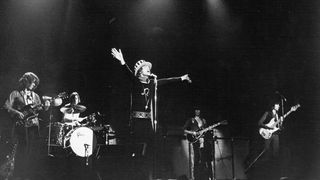
It might have been the first rock and roll tour of any real consequence. Today, if it’s remembered at all, it’s usually for the body count left in its wake.
But Bill Wyman recalls the Rolling Stones’ 1969 American tour for a different reason. “In 1969, they listened,” the former Stones bassist says. “It was the first time that the audiences had actually listened to us.”
Woodstock may be the musical event of 1969 that defined a generation, but the Rolling Stones’ 1969 American tour set the standard for the future of rock and roll concerts. Launched in November of that year, a little more than two months after Woodstock, the cross-country jaunt isn’t regarded with the same reverence as the festival.
Fans know it as the tour captured on the 1970 release Get Yer Ya-Ya’s Out! , the Stones’ second live album and a favorite concert album among those who have sunk a needle into its grooves.
But the group’s U.S. hitch not only changed how rock and roll shows were presented – it also showed a new way to finance them and make a profit, opening the door to the barnstorming extravaganzas launched by artists like Led Zeppelin, Yes, Elton John and others in the 1970s and the decades that followed.
It was, as Wyman notes, the start of a new time, when the fans stopped screaming and began to listen, as well as turn on and become immersed in the live-music experience.
Anyone who witnessed the British Invasion first-hand knows all too well how awful rock and roll concerts could be in the mid 1960s, when primitive sound systems were unable to project a band’s music above the noise of the crowd.
As a budding guitarist looking forward to a show from your favorite players, you’d have strained to hear their instruments, whose frequency range was well matched to that of the screaming girls.
You’d probably have trouble seeing the band too. Under the glare of stage lights or spots, acts played with little to no staging – no set, no props, no lighting effects. As performances went, it was as rudimentary as it could be.
After sitting through three or four opening acts, the band you’d shelled out your hard-earned allowance to see came onstage and played its hits for 20 to 30 minutes before abruptly departing. The Rolling Stones certainly knew the drill.
Their previous U.S. tour, in 1966, in support of their album Aftermath , opened in Lynn, Massachusetts, where 17,000 fans packed the Manning Bowl for the evening’s entertainment.
The outdoor show opened with the Mods, a local act who had won their spot through the promoter of a battle of the bands contest. They were followed by the McCoys, then riding high on their hit “Hang on Sloopy” and the Standells, the L.A. act whose breakthrough hit, “Dirty Water,” celebrated Boston, Lynn’s neighbor to the south.
Things got a little blurry in the ’60s. Tear gas – that was the other continuous smell of the ’60s. I can’t say I miss it Keith Richards
The Stones’ set, consisting of a mere 10 songs, lasted just over 30 minutes. That was short enough, but the Manning Bowl show ended early when a rainstorm broke out. Teens stormed the stage, and the police responded with tear gas.
The Stones escaped to their limos and fled. “It was a bit of an outdoor crazy,” Mick Jagger recalls. ”It wasn’t well secured. A few people got a bit drunk. There were a few cops, and that was the end of it.”
“Things got a little blurry in the ’60s,” Keith Richards says. “Tear gas – that was the other continuous smell of the ’60s. I can’t say I miss it.”
But by the decade’s end, much had changed in music and the youth movement. Those screaming teens had grown up. Many were now out on their own, burning their draft cards, marching to protest the Vietnam War, experimenting with drugs and defining their own place in society.
Rock and roll had evolved as well, with bands like the Beatles introducing elements of spirituality in their music, while groups like the Stones met social and political issues head on.
Their 1968 hit “Street Fighting Man” had been embraced by youths in France, who fought in the streets of Paris that May for social reforms, and by young Americans protesting the Vietnam War at the Democratic National Convention in Chicago that August. Older and radicalized, rock and roll fans went to shows, smoked weed, or took something stronger, and actually listened to the music.
Unfortunately, the new arenas and civic auditoriums that began dotting the U.S. landscape in the latter half of the 1960s weren’t suited to rock shows. Vast, with seating for 10 to 20 thousand attendees, they were ill-equipped to handle musical events, their underpowered public-address systems designed for sporting events rather than sold-out concerts.
Fans furthest from the stage weren’t only deprived of the music – the performance itself looked like a distant skirmish under the floodlights.
Remarkably, England’s Rolling Stones would provide the solution to this uniquely American problem. By 1969, nearly three years had passed since the group’s 1966 tour, their last in the United States. At that time, they, along with the Beatles and Bob Dylan, made up pop music’s Big Three.
But the Beatles had stopped performing and were in the midst of breaking up, while Dylan was a recluse in Woodstock. Somehow, the Rolling Stones were still standing, and with a new guitarist in tow – John Mayall’s young blues protégé Mick Taylor – they were ready to claim the field for themselves.
This time they wanted a spectacle – a show that was bigger and louder than before, with proper sound reinforcement and set design.
They hired lighting designer Chip Monck – who lit Monterey Pop and as Woodstock’s emcee warned the festival’s flower children away from the “brown acid” – to create a set that they would haul from stage to stage. They brought their own P.A. system and mixing board, and drafted recording engineer Glyn Johns to run sound and record the shows.
They didn’t trust local promoters, so they chose their own opening acts, bringing along English guitarist and vocalist Terry Reid, and booking a trio of show-stopping American acts: the Ike & Tina Turner Revue, B.B. King and, a guitarist who was like a god to them, Chuck Berry. Significantly, the Stones booked every show themselves, eliminating middlemen and ensuring themselves maximum profits.
The jaunt itself would see Jagger and Richards slip further into hard-drug use. And when it was over in early December, a cloud of death hung over what should have been a celebration
Above all, they wanted to perform. No more 30 minutes of hits. The 1969 American tour saw the Rolling Stones play for an average of 75 minutes each show, with many concerts lasting past midnight.
Everything was designed to draw the audience into the act. Monck designed a proscenium stage backlit with lights that changed color to suit the songs’ moods, and concealed the speaker towers by draping them in grey cloth.
At the center of it all, on a purple carpet with a white starburst center, Mick Jagger led the Rolling Stones – Richards, Taylor, Wyman and drummer Charlie Watts – through the set like a ringmaster, dressed in black trousers with silver buttons down the legs, a metal-studded belt, a black scoop-necked jersey with a white Leo glyph on the chest, a flowing red scarf, and a red, white and blue Uncle Sam top hat.
The 1969 American tour didn’t just reassert the Rolling Stones as a powerhouse rock and roll band – it also changed expectations of what a rock and roll show should be, how it should be run, and the production standards required.
It’s here that the modern music concert tour began. And it’s here that the Rolling Stones’ legend as “the greatest rock and roll band in the world” – as tour manager Sam Cutler introduced them each night – begins.
But getting to this point wasn’t easy. By the time the tour launched on November 7, in Fort Collins, Colorado, one of the Stones’ own would be in the grave. The jaunt itself would see Jagger and Richards slip further into hard-drug use. And when it was over in early December, a cloud of death hung over what should have been a celebration.
The Rolling Stones had always been one of rock and roll’s most exciting live acts, but by 1969, they were rarely seen onstage anymore. Since the group’s 1967 European tour, they had made one public appearance, at the 1968 NME Poll Winners Concert, not including their own Rock and Roll Circus concert from December 1968 before an invitation-only audience. The reason was down to drugs.
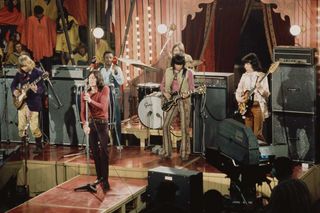
Jagger, Richards and Stones co-founder Brian Jones had all been charged with offenses. But whereas Jagger’s three-month sentence for possession of amphetamine tablets was reduced to a conditional discharge – essentially an order to “keep your nose clean” – and Richards’ conviction for allowing pot to be smoked on his property was overturned on appeal, Jones was not nearly so lucky.
Police had discovered cannabis and hard drugs at the multi-instrumentalist’s home during a raid in May 1967.
The following May, while still on probation, he was arrested again after a second raid at his flat turned up hash. Jones was found guilty, but the judge, believing the jury prejudiced, refused to jail the guitarist and instead fined him £50, about $890 today.
Brian and Keith had this guitar thing like you wouldn’t believe. There was never any suggestion of a lead and a rhythm guitar player. They were two guitar players that were like somebody’s right and left hands Ian “Stu” Stewart
Though Jones had avoided jail, his second drug bust made it impossible for him to get a U.S. work visa, dashing the Stones’ hopes of touring in America. But his days with the group were already numbered.
Though he had been the band’s original leader, Jones’ authority diminished once Jagger and Richards became a successful songwriting duo. As his drug use increased and his mental state became more fragile, Jones missed gigs and recording dates.
A few years earlier, he and Richards had been among the tightest of guitar tandems.
“Brian and Keith had this guitar thing like you wouldn’t believe,” Ian “Stu” Stewart, the band’s co-founder and behind-the-scenes keyboardist, told Stanley Booth, author of The True Adventures of the Rolling Stones . “There was never any suggestion of a lead and a rhythm guitar player. They were two guitar players that were like somebody’s right and left hands.”
But at least since the Stones’ psychedelic-rock opus, 1967’s Their Satanic Majesties Request , Jones had played guitar less frequently.
On the group’s followup, 1968’s Beggar’s Banquet , he contributed slide and acoustic guitar, Mellotron, tambura and sitar, leaving Richards to perform all the other guitar parts. By the time the Stones began recording 1969’s Let It Bleed , they didn’t even expect Jones to attend the sessions.
He showed up for the recording of “You Can’t Always Get What You Want,” asking Jagger, “What can I play?” “I don’t know, Brian,” Jagger replied. “What can you play?” “I enjoyed his company, and I tried incredibly hard, in 1966, to pull him back into the group,” Richards told Rolling Stone in 2010. “He was flying off. But my attempts to bring Brian back into focus were a total failure.”
While the Stones could work around Jones in the studio, they couldn’t do without a second guitarist onstage. They briefly considered replacing him for the U.S. tour with Eric Clapton, but in the end, the Stones faced up to the inevitable.
Mick and I didn’t fancy the gig. But we drove down together and said, ‘Hey, Brian… It’s all over, pal’ Keith Richards
On June 8, Jagger, Richards and Watts drove to Jones’ home, Cotchford Farm, the former estate of Winnie the Pooh author A.A. Milne, to deliver the news. “Mick and I didn’t fancy the gig,” Richards wrote in his 2010 memoir, Life . “But we drove down together and said, ‘Hey, Brian… It’s all over, pal.’”
By then, the Stones had found his replacement: 20-year-old Mick Taylor. Despite his youth, Taylor had already distinguished himself in John Mayall’s Bluesbreakers, taking over from Peter Green, Clapton’s successor, in 1967, at the tender age of 18. A fine blues guitarist, Taylor was blessed with a jazzman’s sensibilities, his remarkably melodic lead work streaked with shades of modal playing.
It was Mayall and Ian Stewart who suggested Taylor to Jagger and Richards. Certainly, Richards knew Taylor – he’d sold him his 1959 Les Paul Standard back in 1967 when Taylor had joined the Bluesbreakers.
The Stones had taken the young guitarist onboard even before they let Jones go: Though many sources pin the date to June 1969, Taylor’s first recording with the Stones was on “Live With Me,” which was recorded May 24, two weeks before Jones was fired.
The Stones actually hadn’t played together for a long time, so when I joined them it was like a new beginning. It was a new phase in their career. A new chapter Mick Taylor
“‘Live With Me’ was the very first track I ever played on,” Taylor recalls, “when they were putting the finishing touches to Let It Bleed . We actually recorded that the night I went for my audition at Olympic Studios, or maybe the night after.
“I remember [producer] Jimmy Miller jumping up and down in the control room and getting all excited about how good it sounded, having two guitars playing off each other. Because I think they’d missed that with Brian Jones in the two-year hiatus since their last live performance.
“The Stones actually hadn’t played together for a long time, so when I joined them it was like a new beginning. It was a new phase in their career. A new chapter.”
To kick it off, the Stones had agreed to play a free concert in London’s Hyde Park on July 5. The timing was good: Their new single, “Honky Tonk Women,” featuring the lead guitar work of both Richards and Taylor, was scheduled to be released the day before.
The Hyde Park concert would be an opportunity to show off their new lineup and put some publicity behind the song. But the Stones’ previous chapter was still being written.
Sometime around midnight on July 2-3, Brian Jones was found dead in the swimming pool at Cotchford Farm. Before the sun had risen, the news made its way through the Stones’ camp and into the morning news. Richards recalls that the band members were in the studio when they heard about it.
“There exists one minute and 30 seconds of us recording ‘I Don’t Know Why,’ a Stevie Wonder song, interrupted by the phone call telling us of Brian’s death,” he wrote.
Mick Taylor’s arrival in the Stones marked the start of a new era and sound for the Rolling Stones. Though Jones was a talented guitarist, soloist and multi-instrumentalist, Taylor was in a different league.
Ry was using open G for slide. I saw him and thought, That’s a really nice tuning. It restricts you so much: five strings, three notes, two fingers… one asshole! Keith Richards
His muscular lead-guitar style fit their new blues-rock direction and brought a level of bravura to their ranks at a time when guitar virtuosity was on the rise in rock and roll.
“I was in awe sometimes, listening to Mick Taylor,” Richards wrote. “Everything was there in his playing – the melodic touch, a beautiful sustain and a way of reading a song.” Taylor’s melodicism proved a perfect counterpoint to Richards’ own recently adopted style.
In March 1969, during the making of Let It Bleed , the group had recorded “Sister Morphine,” a track destined for 1971’s Sticky Fingers , with Ry Cooder playing slide. Richards was taken with Cooder’s use of open-G tuning and adopted it as standard for his guitar work, eliminating his low E string in the process.
“I met Ry in 1968, when he was hanging around with Taj Mahal and Jesse Ed Davis,” Richards told Guitar . “Ry was using open G for slide. I saw him and thought, That’s a really nice tuning. It restricts you so much: five strings, three notes, two fingers… one asshole!”
With their reconstituted lineup and tough new guitar sound, the Stones were eager to get back onstage. The fans were clamoring for it. Seven years into their career, the Stones sounded better than ever. Just as important, they were still relevant.

As rock and roll’s bad boys, they had always had an element of danger about them, but it was more overt on their newer material, like “Sympathy for the Devil,” the Beggars Banquet opener, on which Jagger adopted Satan’s persona to implicate humanity in the world’s sins, placing the weight of social responsibility on the shoulders of the Stones’ young radicalized listeners.
On the album’s flipside, “Street Fighting Man” offered a model for how to effect the change necessary to liberate a world stuck in the ways of the past and running headlong to its own destruction.
Teenagers are not screaming over pop music anymore. They’re screaming for much deeper reasons Mick Jagger
The Stones had won the love of politically minded youths with those songs, but Jagger glimpsed what was to come as early as 1967, when they played Warsaw, Poland, bringing rock and roll to Communist Eastern Europe.
“Teenagers are not screaming over pop music anymore,” he told Stanley Booth. “They’re screaming for much deeper reasons. When I’m onstage, I sense that the teenagers are trying to communicate to me, like by telepathy, a message of some urgency. Not about me or about our music, but about the world and the way they live. And I see a lot of trouble coming in the dawn.”
In September, the Stones began making plans for their month-long jaunt across America. Following an off-circuit gig on November 7 at Colorado State University’s 8,745-seat Moby Gymnasium, the tour would commence in earnest.
The itinerary would take the show from Los Angeles up to Oakland, across to Phoenix, down to Dallas and over to Alabama, before heading north to Chicago and east to Detroit, Philadelphia, Baltimore, New York City and Boston, the final stop.
As shows sold out in the larger cities, the Stones added second shows, though Mick Jagger, ever cautious about the cost, warned, “We won’t play if there’s a single empty seat.”
The Rolling Stones wanted to control everything, from signing up and paying the opening acts to designing the production. “There was one minor problem, though,” said Ronnie Schneider, the tour’s manager. “We had no money, nothing.”

The William Morris Agency had signed on to book the tour, but the Stones’ preeminence made its role moot. In the end, William Morris put up just $15,000 “to finance a half-million-dollar tour,” Schneider says. “To pay for the construction of the set, the stage, the lights, to guarantee the acts, to do everything. It was a very funny moment.”
But Schneider came up with a solution that was revolutionary. In his scheme, the Stones – or rather, their new company, Rolling Stones Promotions – would receive, upfront, 50 percent of each venue’s gross box-office receipts, which would be used to fund the tour.
Any problem with any of them and the shit was hitting the fan Ronnie Schneider, tour manager
Jagger’s insistence on sold-out shows wasn’t about ego but to generate demand for future shows to keep the tour running. For the scheme to work, they’d need to sell out the first five dates. “Any problem with any of them and the shit was hitting the fan,” Schneider said.
Not only did the gambit work – it changed how bands financed tours, allowing them to launch ever-greater spectacles. Schneider also led the way by taking over managing rights related to all aspects of the tour, including posters, T-shirts and programs, eliminating freelance merchandisers and greatly improving the Stones’ finances.
But all was not well in this new world of mega shows. Soon after the tour was announced, fans began to complain about the size of the venues and ticket prices. Rolling Stone noted that tickets for the Los Angeles Forum show ranged in price from $5.50 to $8.50, whereas the same arena had charged $3.50 to $7.50 for Blind Faith and $3.50 to $6.50 for the Doors.
Writing in The San Francisco Chronicle , Rolling Stone founding editor Ralph Gleason took the Stones to task for asking fans to pay more to see them perform in less-intimate settings.
“Paying five, six and seven dollars for a Stones concert at the Oakland Coliseum for, say, an hour of the Stones seen a quarter of a mile away...says a very bad thing to me about the artists’ attitude towards the public,” Gleason wrote. “It says they despise their own audience.”
Gleason’s words stung the band. Confronted about the matter at the tour’s first U.S. press conference, Jagger left the door open to playing a free concert when the jaunt was over.
Weeks later, in New York City, he confirmed the group would headline a free show in the San Francisco area. Why San Francisco?
“Because there’s a scene there,” Jagger replied. “And the weather’s nice.”
From London, the group flew to Los Angeles in October to begin rehearsing and preparing for the tour. Immediately, the members split into different residences.
Bill Wyman and his wife rented a home, while Charlie Watts, with his wife and child in tow, stayed in a large hotel-like home on Oriole Street – dubbed Oriole House – where the group’s entourage of staff members and handlers oversaw preparations for the tour. Jagger, Richards and Taylor found privacy at Stephen Stills’ house in Laurel Canyon.
The abode gave Jagger and Richards a place to work on tunes for the group’s next album, and afforded Richards and Taylor a chance to work out their arrangements for the songs selected for the tour. The home’s cramped coffin-shaped basement also doubled as the band’s practice space.
“We did some rehearsals,” Wyman recalls. “We didn’t do a lot. You know what the Stones are like. It was mostly party time.” Mick Taylor, new to this world, was shocked to find the Stones’ sound so “ragged.”
“I thought, How do these guys make such great records when they’re so sloppy and spontaneous? But it was because they had this great chemistry.”
I thought, How do these guys make such great records when they’re so sloppy and spontaneous? But it was because they had this great chemistry Mick Taylor
Developing the set list proved more difficult than they’d imagined. While the stylistic differences between the new guitar duo made for some great interplay – Richard’s jagged double-stop riffing against Taylor’s sinewy blues lines – it made playing most of the old hits impossible without some degree of reinterpretation.
From the Stones’ deep back catalog, only three songs – “Under My Thumb,” “I’m Free” and “(I Can’t Get No) Satisfaction” – were dusted off and recalibrated for the new lineup. Mostly, the band focused on their latest hit singles – “Jumpin’ Jack Flash” and “Honky Tonk Women” – and cuts from Beggar’s Banquet and the still-unreleased Let It Bleed .
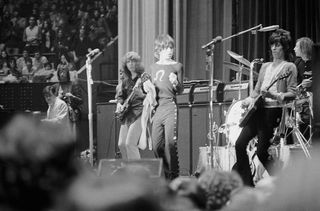
The bluesier country stylings of those albums gave Taylor plenty of room to stretch out and play bottleneck slide, something Jones was also adept at, though not with the same burning intensity.
For good measure, they tossed in a couple of Chuck Berry standards – “Carol” and “Little Queenie” – to showcase Keith’s driving double-stop riffs. Unfortunately, Stills’ basement was too small to hold rehearsals with full gear.
Through their connections, the Stones secured an unused soundstage at Warner Bros. studio lot. The building chosen for them had served as the main set for director Sydney Pollack’s 1969 Depression-era drama They Shoot Horses, Don’t They?, starring Jane Fonda and Michael Sarrazin as a couple who compete in a grueling dance marathon for the chance to win $1,500.
Though filming had been completed, the film’s elegant 1930s-style ballroom set was still up when the Stones arrived. Above it hung a large scoreboard that, in the film, shows how many hours have elapsed in the marathon and the number of couples still standing.
“How Long Will They Last?” read a legend at the top of the board. For the Stones, binging on drugs and rushing headlong into a tour for which they were unprepared, the question was perversely appropriate.
Prototype SVTs hadn’t been field tested, making Richards and Taylor unwitting guinea pigs in the amp’s development. Ampeg sent a pair of techs to maintain them, along with five additional backup units
For the short tour, Richards and Taylor were well equipped with guitars and amps. According to gear expert Andy Babiuk, Richards’ main guitars were his prototype Ampeg Dan Armstrong Plexiglas and a 1958 Gibson Les Paul Custom he’d purchased earlier that year. His other guitars on the tour included his 1969 Gibson ES-355TD-SV stereo electric and the 1959 Les Paul Standard he’d sold to Mick Taylor in early 1967.
In addition, Richards brought a 1930s National Style O resonator, which he used when performing “Prodigal Son” and “You Gotta Move” with Jagger in the show’s short acoustic set, and a Martin D12-20, a dreadnought-sized 12-string, fitted with a DeArmond soundhole pickup.
As for Taylor, he mainly used his Cherry Red 1961 Gibson Les Paul SG, whose “sideways” tremolo unit he’d replaced with a Bigsby B-5. He also occasionally used the ES-355TD-SV and his ’59 ’Burst for slide, as well as his 1958 Les Paul Standard. For amps, both guitarists were provided an arsenal of Ampeg’s new prototype SVT – Solid Vacuum Tube – amps.
The Stones had shipped their Hiwatts from England, but the amps were damaged after they arrived stateside. Ian Stewart, who recalled that the group had used an Ampeg B-15 Porta-flex “flip-top” amp in its early recording sessions, contacted the manufacturer in New Jersey, and the company quickly sent along a truckfull of SVT prototypes, along with some ST-42 4x12 guitar cabinets from Ampeg’s solid-state line.
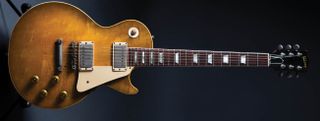
Designed as bass amps, the SVTs put out a whopping 300 watts, prompting Ampeg to place a warning label on early models. A dozen prototypes were built, most of which were loaned to the Stones.
The Ampegs were first used when the group moved to the Warner Bros. soundstage, although photos from those sessions show Taylor using several Fender Twin Reverbs. On tour, he, like Richards, performed before an impressive wall of SVTs.
Unfortunately, the prototype SVTs hadn’t been field tested, making Richards and Taylor unwitting guinea pigs in the amp’s development. Ampeg sent a pair of techs to maintain them, along with five additional backup units.
Not only were the amps not designed for electric guitar but Richards and Taylor were using two or three simultaneously. The techs would sit onstage, behind the amps, and watch the tube plates for signs of overheating, then swap out an amp before it blew. They weren’t always successful.
At the Oakland Coliseum on November 9, the second date of the tour, Richards’ amp failed during the intro to “Jumpin’ Jack Flash,” the second song of the show.
He and Jagger quickly switched to the acoustic portion of the set while the situation was remedied, but when Richards plugged back into the amp, it blew again, causing him to smash his Les Paul Custom in anger.
The Grateful Dead, who were working with the Stones on arranging the free concert in San Francisco, came to the rescue by loaning their amps for the remainder of the show.
The tour was well received by fans and the press throughout its run, although critics noted early on that the opening acts – particularly B.B. King and the Ike & Tina Turner Revue – were remarkably more polished than the Stones.
“At the beginning of the tour, the band was rusty,” Sam Cutler told photographer Ethan Russell for Let It Bleed , Russell’s photobook of the tour. “When I first called them ‘the greatest rock and roll band in the world,’ I meant it sarcastically. In a way, the slogan made them work harder right from the start.”
By the time the circus rolled into New York City’s Madison Square Garden for the November 27 and 28 dates, the Stones were deadly. It’s from these performances that the group culled the tracks for Get Yer Ya-Ya’s Out! , with one song – their affecting cover of Robert Johnson’s “Love in Vain” – taken from the November 26 show at Baltimore’s Civic Center.
The Stones’ tough new sound and attitude are evident right from the album’s opening cut. “Jumpin’ Jack Flash” was the hot hit the band would have toured on had they been on the road when it was released in the summer of 1968. More than a year later, it was a hard-wearing fan favorite.
When I first called them ‘the greatest rock and roll band in the world,’ I meant it sarcastically. In a way, the slogan made them work harder right from the start Sam Cutler
The band plays it faster on the live album, and in the key of B, whereas the single sounds slightly flat of the key of B flat. And while, on the studio version, Bill Wyman holds down a pedal point on the verses, he plays along with the guitar riff on the live cut, eliminating the single’s hip-swinging groove and making the song a foot-stomping blues-rock number, a genre shift underscored by Taylor’s delicious climbing lead lines on the song’s chorus.
Taylor mostly lays back on the next track, Berry’s “Carol,” giving Richards room to display his classic rock and roll chops. Though he mostly shadows Richards’ rhythm work, the young guitarist steps out on the song’s signature riff, playing bluesy descending lead lines that add interest.
He gets a chance to show his stuff on “Stray Cat Blues,” squeezing fast, stinging lead lines from his guitar during the song’s numerous instrumental breaks. This funky Beggar’s Banquet cut gets new life here.
Taken at a slower and bluesier pace, and with a less busy arrangement, the live version draws much of its power from Jagger’s sexually charged vocals. His singing on the studio version is loose and strung out, but on the live album he taunts, pleads, threatens and reprimands as he expounds on his proposition, imbuing it with a menacing authenticity the studio version lacks.
The fact that the song is about seducing a child – 15 years old on Beggar’s Banquet , reduced to 13 in concert – makes his aggressive performance all the more disturbing. Taylor’s first big moment in the spotlight comes on “Love in Vain,” where he switches to his 1959 ’Burst and takes up his slide.
The Stones recorded this Robert Johnson track for Let It Bleed earlier that year, adapting it as a country blues, complete with mandolin, but here it takes on a worn-in urban melancholy, demonstrating how far they’d already progressed as interpreters of classic blues.
The sessions for that album were not far behind them, but on this November 26 evening in Baltimore, they sound like they’ve endured miles of hard road.
The next night, backstage at Madison Square Garden, Jagger would learn that his girlfriend was leaving him and his lover was pregnant with his child, but in Baltimore he sings the tune as if he’s had a vision of the trouble ahead.
Richards’ lovely, arpeggiating guitar work sets the mood for the singer’s lament, but it’s Taylor who expresses the song’s loss and anguish in his slide work, each perfectly chosen and articulated note dancing along its nerve. Simply stellar, “Love in Vain” is one of the best representations of the Rolling Stones’ power as a live act at this stage in their career.
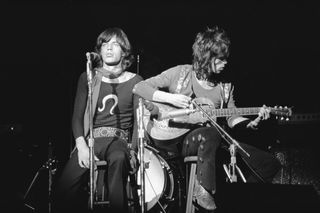
From there, it’s on to what has to be the definitive version of “Midnight Rambler.” The song was unknown to audiences at the time, but at Madison Square Garden they responded reflexively to its shifting moods and momentum, demonstrating how completely the Stones had them in their hands.
Mid-song, the band breaks down the beat, giving Richards and Taylor an opportunity to trade-off licks while Jagger scats. The crowd is amped up, howling, needing an outlet for its agitation.
And it comes: “Well, you’ve heard about the Boston,” Jagger snarls, and the band slams the downbeat, prompting one amazed fan to cry out, “God-damn!”
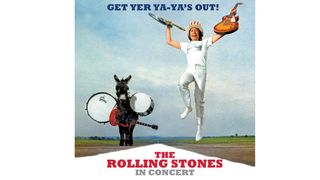
During the song, Jagger would take off his studded belt and use it to whip the stage, “The moment you saw the belt fall, you could actually hear the crowd go, ‘Ahhh!’” Chip Monck recalls. “That’s when you know you got it. That’s when it’s real.” The song rides out on Taylor’s insistent riffing, and by the time it’s over, nine minutes after it began, the exhausted audience is roaring for more.
As with “Midnight Rambler,” a crowd member gets a cameo on “Sympathy for the Devil,” with a stoned female fan calling insistently for an oldie but goodie. “‘Paint It Black’! ‘Paint It Black,’ you devil!” she demands in vain as the Stones kick into their Beggar’s Banquet hit.
The sinewy Latin feel of the original is abandoned for a boogie-rock rhythm that’s more in keeping with the show’s road-worn vibe. Richards plays his lead lines with a cocaine-fueled itch, relying on nerves and muscle memory as he builds the song to its first peak.
From there, Taylor steals the show, testing the water with country-blues riffs before cutting loose, to the obvious satisfaction of Jagger, who yells his approval and relinquishes the spotlight to the young guitarist. Taylor has one of his finest moments on “Sympathy for the Devil,” lifting the song to new heights.
Richards turns in his signature riffing and lead work on “Live With Me,” the standout Let It Bleed track that marked Taylor’s debut with the group. The Stones attack the song with fury and efficiency, driving its irresistible rhythm with a solid performance that goes straight for the jugular.
From there, it’s onto the second Chuck Berry song of the night, “Little Queenie,” a fun, midtempo rocker that the Stones dispatch with druggy punk attitude. Watts has trouble finding the “one,” and Richards’ can’t seem to shake off the riff nagging in his fret hand.
Ian Stewart’s boogie-woogie piano lines and Jagger’s playful delivery carry the song aloft, but it’s an otherwise uninspired turn. Likewise, “Honky Tonk Women,” the Stones’ most recent hit and certainly a standout moment in the band’s 1969 set, is played too strictly to the original recording, and too slow at that.
The same can’t be said of the album’s thunderous closing track, “Street Fighting Man.” Like “Jumpin’ Jack Flash,” it’s stripped of its pop pretensions and flayed with proto-punk fury, the Stones riding it like a tank over enemy lines and flattening everything in its path.
Throughout the show, Glyn Johns sat in a rented Hertz truck three floors below Madison Square Garden, at ground level, capturing every moment of the shows on tape.
“I was in the truck,” he recalls, “and at one point – probably at the end of the show – I thought there were people stomping on the roof, because the whole bloody truck was bouncing up and down. “So I jump out and I look around. But there’s nobody on top of the truck. The whole building, all of Madison Square Garden above me, was moving. I was petrified.”
The whole building, all of Madison Square Garden above me, was moving. I was petrified Glyn Johns
Had the Rolling Stones headed home after the tour wrapped in Boston, the furor over ticket prices likely would have died down, snuffed out by the release of Let It Bleed one week later, on December 5. Instead, they spent their last week in America making nice with their fans and recording tracks for their next album at Muscle Shoals.
The first stop was the West Palm Beach International Music and Arts Festival, on November 30, in Jupiter, Florida. The Sunshine State’s attempt at a Woodstock-style event, the festival featured Jefferson Airplane, Janis Joplin, Sly and the Family Stone, the Byrds and several other rock groups, with the Stones scheduled as the closing act.
Rain and a badly timed cold front made the event uncomfortable for fans, and transportation issues delayed the Stones’ arrival by 11 hours. They finally took the stage at 4 a.m. From Florida, the group headed to Muscle Shoals Sound Studio in Sheffield, Alabama, hoping to capture some of their newfound fire on tape.
Over three days, they cut three tracks – their new songs “Wild Horses” and “Brown Sugar,” along with the traditional Black spiritual “You Gotta Move” – all of which were destined for their next studio album, 1971’s Sticky Fingers. And then it was onward to San Francisco and the Saturday, December 6 free concert they’d been railroaded into headlining.
From the start, the organizers had trouble finding a location. San Jose State University’s practice field, the site of an earlier three-day free festival, was selected, but the city, still reeling from that event, refused to issue the necessary permits.
Golden Gate Park was up for consideration, but an NFL football game at Kezar Stadium, situated in the park, on the same day made the location unsuitable.
Sears Point Raceway, in Sonoma, was selected, but the venue’s owner, the television and film production company Filmways, Inc., wanted the Stones to put up $300,000 cash as a deposit. The company also demanded distribution rights for a concert film of the event.
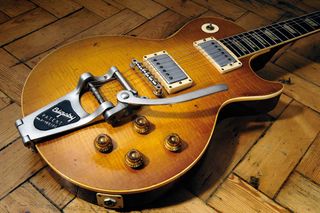
On December 4, with just two days to spare, the Altamont Raceway, in Tracy, 70 miles east of San Francisco, was selected. The festival would open with West Coast groups – Santana, Jefferson Airplane, the Flying Burrito Brothers, the Grateful Dead and Crosby, Stills, Nash & Young – while the Stones served as the closing act.
With memories of Woodstock still fresh, the organizers anticipated a peaceful concert, which is perhaps why no one thought it a bad idea to hire members of the Hells Angels motorcycle club to help out.
The Jefferson Airplane and Grateful Dead had suggested having them on hand, and the Stones concurred. It probably helped that they had enlisted a British group of motorbike fans called the Hells Angels to provide security the previous June at their Hyde Park show, where Mick Taylor made his official debut as a member of the band.
For the promise of $500 in beer, the Hells Angels agreed to keep fans from climbing onto the Altamont’s makeshift stage, which was just one meter high, and provide assistance to attendees, such as giving directions to bathrooms and medical tents.
The concert started out fine, with Santana turning in an inspired set. But as the day progressed, the Angels got drunker, while the young attendees grew more stoned and unruly. The bikers frequently waded into the throng, swinging fists, pool cues and motorcycle chains, to drive back fans or take down flailing, strung-out revelers.
When Jefferson Airplane’s Marty Balin attempted to break up a scuffle, one of the Angels punched the singer, knocking him out. The Grateful Dead had been scheduled to play between CSN&Y and the Stones, but when they arrived and learned what had happened to Balin, they panicked and fled.
The violence was incredible. I thought the show would have been stopped, but hardly anybody wanted to take any notice Keith Richards
By the time the Stones went on, darkness had fallen and some 5,000 fans were swarming the front of the stage. Jagger, who’d been punched in the face by an attendee when he first arrived, implored the crowd to “cool out.”
They began playing “Sympathy for the Devil” but stopped when the Angels launched another skirmish. “The violence was incredible,” Richards recalls. “I thought the show would have been stopped, but hardly anybody wanted to take any notice.”
The Stones continued to play, having little recourse and hoping the performance would keep the crowd from becoming more chaotic. They launched into “Under My Thumb,” but as Jagger began singing, another fight broke out.
A young man in a lime-green suit was seen tangling with some Hells Angels, when he suddenly pulled a revolver from his jacket. The bikers descended. Hells Angel Alan Passaro reportedly stabbed the man five times with a large knife, while the others stomped him and left him to die.
Attendees carried his limp body to a medical tent, but 18-year-old Meredith Hunter succumbed to his injuries, one of four people who died that day at Altamont.
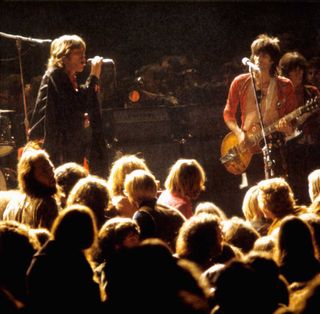
After the shock of Altamont, the Rolling Stones had given little thought to releasing an album from their U.S. jaunt. But in December, shortly after the tour’s conclusion, a bootleg of their troubled November 9 Oakland Coliseum show began making the rounds at head shops and independent record stores.
Titled Live’r Than You’ll Ever Be , it was one of the earliest commercially sold bootleg albums, along with Kum Back , featuring session recordings from the Beatles’ yet-unreleased Let It Be project, and Great White Wonder , offering uncollected recordings of Dylan’s performances from 1961 through his 1967 sessions with the Band.
The Stones’ bootleg sold very well, which may have influenced the group to release a concert record of its own. Ethan Russell, the tour’s trusted photographer, was hired to shoot its cover.
He created a still life consisting of Jagger’s Uncle Sam top hat and various other elements of his stage costume, along with his passport and odds and ends. Prominently positioned on the hat’s brim was a fat white joint. Jagger, still smarting from the band’s drug busts, looked at the photo in disbelief. “Didn’t you shoot any without the joint?” he asked. Russell had not.
In early February, Charlie Watts was dispatched to a section of the M6 motorway in Birmingham, England, along with a donkey and pieces of the Stones’ gear, including Keith Richards’ Ampeg Dan Armstrong guitar and Mick Taylor’s 1958 Les Paul ’Burst.
He was photographed in his white stage clothes, wearing Mick Jagger’s top hat, and leaping into the air while holding the guitars aloft. Shot by David Bailey, the photo was inspired by the line “Jewels and binoculars hang from the head of the mule,” from Dylan’s “Visions of Johanna.”
Altamont – it could only happen to the Stones Keith Richards
On Watts’ T-shirt, an image of a woman’s bare breasts provided a visual reference for the album’s title, itself derived from the Blind Boy Fuller tune “Get Your Ya Yas Out,” though in Fuller’s song, ya yas is a euphemism for ass.
The Stones, as always, had no qualms about pushing the limits. Released on September 4, 1970, Get Yer Ya-Ya’s Out! quickly became a hit, reaching Number One in the U.K. and Number Six in the U.S., where it eventually went Platinum.
Critics praised it, with Rolling Stones ’ Lester Bangs saying, “I have no doubt that it’s the best rock concert ever put on record.”
But for all its success, Get Yer Ya-Ya’s Out! , along with the tour that gave birth to it and the innovations the Rolling Stones brought to rock and roll’s live music scene, lie in the shadow of what Keith Richards called “the terrible murder going on in front of us.”“Altamont,” he said in 1971. “It could only happen to the Stones.”
Get The Pick Newsletter
All the latest guitar news, interviews, lessons, reviews, deals and more, direct to your inbox!
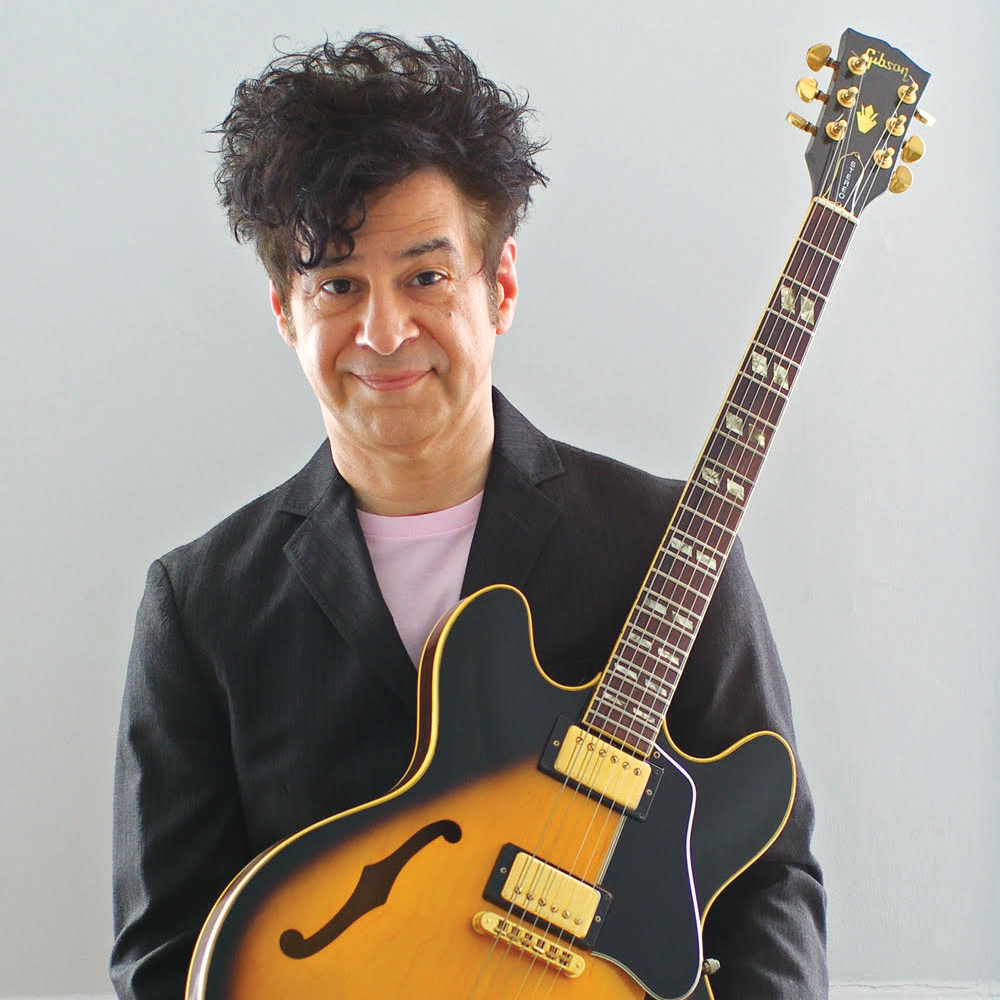
Christopher Scapelliti is editor-in-chief of Guitar Player magazine, the world’s longest-running guitar magazine, founded in 1967. In his extensive career, he has authored in-depth interviews with such guitarists as Pete Townshend, Slash, Billy Corgan, Jack White, Elvis Costello and Todd Rundgren, and audio professionals including Beatles engineers Geoff Emerick and Ken Scott. He is the co-author of Guitar Aficionado: The Collections: The Most Famous, Rare, and Valuable Guitars in the World , a founding editor of Guitar Aficionado magazine, and a former editor with Guitar World , Guitar for the Practicing Musician and Maximum Guitar . Apart from guitars, he maintains a collection of more than 30 vintage analog synthesizers.
“Allan Holdsworth is untouchable, unimpeachable... He is just the total king. I would build a shrine to him”: Meet Max Light, the jazz guitarist who loves John Coltrane, Miles Davis, and Meshuggah in equal measure
“Many young guitarists get discouraged because the comments sections on all platforms are somehow even more toxic than they were five or 10 years ago”: Slowly emerging from a hiatus, Sarah Longfield's ever-impressive playing is “more chill now”
“I was on a mission to find the next big guitar hero. When I heard Yngwie, I knew that he was the guy I was looking for”: How Guitar Player's Spotlight column made Yngwie Malmsteen a guitar hero overnight, and sent neoclassical shred into overdrive
Most Popular
- 2 Santa Cruz Guitars' Richard Hoover explains the science of vintage wood and guitar tone
- 3 John 5's top tips for beginner, and veteran, guitarists
- 4 Expand your arsenal, and channel Lindsey Buckingham and Mark Knopfler, with this lesson in fingerstyle
- 5 Vince Gill on his role in the Eagles, and the wonders of playing with Joe Walsh
The Rolling Stones American Tour 1969
The Rolling Stones ' 1969 Tour of the United States took place in November 1969. With Ike & Tina Turner , Terry Reid , and B.B. King (replaced on some dates by Chuck Berry ) as the supporting acts, [1] rock critic Robert Christgau called it "history's first mythic rock and roll tour", [2] while rock critic Dave Marsh wrote that the tour was "part of rock and roll legend" and one of the "benchmarks of an era." [3] In 2017, Rolling Stone magazine ranked the tour among The 50 Greatest Concerts of the Last 50 Years. [4]
External links
This was the Rolling Stones' first US tour since July 1966, with the absence partly due to drug charges and subsequent complications. [2] Instead of performing in small- and medium-size venues to audiences of screaming girls, the band was playing to sold-out arenas with more mature crowds that were ready to listen to the music. [5] They used a more sophisticated amplification system, and lighting was overseen by Chip Monck . It was Mick Taylor 's first tour with the band; he had replaced Brian Jones that June, shortly before Jones's death, and had only performed one gig (the free concert in Hyde Park ) with them before the tour. [5]
Some rehearsals for this tour occurred in the basement of Stephen Stills ' Laurel Canyon home. [6]
The tour began on 7 November with a warm-up show at Colorado State University , and then proceeded generally west to east, often playing two shows a night. The tour's second stop, at The Forum in Los Angeles, attracted national media attention as the outing's formal opening. [7] Shows sometimes ran past midnight, [7] [8] and the Rolling Stones' performance lasted about 75 minutes. [8] Terry Reid , B.B. King (replaced on some dates by Chuck Berry ), and Ike & Tina Turner were the supporting acts; audiences were typically in their seats for three hours, including long delays between acts, before the Rolling Stones materialized on stage. [5]
On 23 November, the band appeared on The Ed Sullivan Show . "Gimme Shelter" opened the show. The show closed with "Love in Vain" and "Honky Tonk Women." The band mimed to prerecorded tracks and Jagger sang live. The performance was recorded at the CBS studios in Los Angeles and edited into the show to appear like they were in New York.
In his review of the shows on 27 and 28 November at New York City's Madison Square Garden , Francis X. Clines of The New York Times characterized the tour as "the major rock event of the year." [8] Ike & Tina Turner were a fan favorite, and they reportedly upstaged the Rolling Stones. Janis Joplin joined the Turners on stage for an impromptu performance of " Land of 1000 Dances " at one of the Madison Square Garden shows. [1] [8]
Another well-known show from the tour was the second concert in Oakland, California on 9 November, which was captured on Live'r Than You'll Ever Be , one of the first-ever live bootleg recordings .
The final show of the tour as initially planned was on 28 November in New York City, but 30 November in West Palm Beach, Florida was added as a gesture to the organiser. The band also organised and headlined the free concert at Altamont on 6 December, which was tacked on at the end of the tour as a response to the high ticket prices of the tour itself. [9]
Tour manager Sam Cutler introduced the Rolling Stones as "the greatest rock and roll band in the world", a title he had first bestowed upon them at their concert in London's Hyde Park the previous July. [10] The tour set lists were derived mostly from 1968's Beggars Banquet album and the forthcoming Let It Bleed . The performance itself featured the Stones showmanship that would become familiar: Charlie Watts businesslike drumming leavened by an occasional wry smile, Bill Wyman 's undertaker persona on bass, the guitar interplay of Mick Taylor with Keith Richards , and most of all Mick Jagger 's prancing, strutting, leering and preening in front of the crowd. [5] [8] "Ah think I've busted a button on my trousers, I hope they don't fall down" he teased the audience. "You don't want my trousers to fall down, now do ya?" [11] At one point in some shows, Jagger motioned for the audience to rush past ushers to the edge of the stage; [7] of the group's reaction to the crowd's fervor, a spokesman said, "They loved it." [7]
The US was in political turmoil at the time, and some militant groups tried to portray the tour as a call for radical political action, especially in light of the Rolling Stones' 1968 track " Street Fighting Man ". [12] The Rolling Stones themselves had no such interest, and while on tour Mick Jagger publicly rebuffed a request for support from the Black Panthers . [12] Stones media appearances during the tour featured typical banter of the time on other issues; while other members of the group affected boredom, Jagger gave non-sequitur responses to cultural questions, [8] and said of New York, "It's great. It changes. It explodes." [8]
The tour sold over $1 million worth of tickets, [8] with ticket prices ranging from $3.00 to $8.00. [7] [8] This tour represented a new financial model for rock acts pioneered by Ronnie Schneider , the sole producer and financial manager of the tour. Schneider was the nephew of Allen Klein , who had been recently fired by Keith Richards and Sam Cutler. [13]
Neither Schneider nor the Stones had any money at the time to fund this endeavor so Schneider had to come up with a new business model and that meant the band getting a piece of the gross box office and demanding a 50% advance, which funded the shows. [ citation needed ]
Schneider's role involved securing box office receipts on behalf of the band. In this way, the band itself (and Schneider, whose interests were aligned with those of the band) was in control of all the money related to a tour. On behalf of the Rolling Stones, Schneider centralized the control, ownership and management of ancillary rights, licensing and the marketing of posters, T shirts , programs and other concert related materials—-vastly improving the group's revenue base while touring. Many other bands followed suit throughout the 1970s.
The 1970 concert album Get Yer Ya-Ya's Out! , mostly based on the Madison Square Garden shows, documented the tour, as did the Maysles brothers ' 1970 documentary Gimme Shelter which, while mostly known for its filming of Altamont, also contains substantial footage of the band's performance during the tour at Madison Square Garden. Gimme Shelter also captures Jagger's famous response to a press-conference question about whether he was "any more satisfied now": "Financially dissatisfied, sexually satisfied, philosophically trying." [8]
The Rolling Stones
- Mick Jagger – lead vocals , harmonica
- Keith Richards – guitar , backing vocals
- Mick Taylor – guitar
- Bill Wyman – bass
- Charlie Watts – drums
Additional musicians
- Ian Stewart – piano
Ike & Tina Turner Revue
- Tina Turner
- The Ikettes : Esther Jones , Pat Powdrill , Claudia Lenner
- The Kings of Rhythm
A typical set list for the tour included the following, although there were substitutions (note the presence of " Gimme Shelter " on Live'r Than You'll Ever Be and " Brown Sugar " was performed at Altamont), variations and order switches throughout the tour.
All songs by Mick Jagger and Keith Richards , except where noted.
- " Jumpin' Jack Flash "
- " Carol " ( Chuck Berry )
- " Sympathy for the Devil "
- " Stray Cat Blues "
- " Love in Vain " ( Robert Johnson )
- "Prodigal Son" ( Robert Wilkins )
- " You Gotta Move " ( Fred McDowell / Rev. Gary Davis )
- " Under My Thumb "
- " I'm Free "
- " Midnight Rambler "
- " Live with Me "
- " Little Queenie " (Berry)
- " (I Can't Get No) Satisfaction "
- " Honky Tonk Women "
- " Street Fighting Man "
Note: The final scheduled date of the tour was Boston, 29 November 1969. The West Palm Beach International Music and Arts Festival on 30 November and the Altamont Free Concert on 6 December were planned as separate events and added while the tour was in progress. A further four dates were completed in London, United Kingdom during December 1969; these were also separate events to the main tour.
Related Research Articles

The Rolling Stones are an English rock band formed in London in 1962. Active across seven decades, they are one of the most popular and enduring bands of the rock era. In the early 1960s, the band pioneered the gritty, rhythmically driven sound that came to define hard rock. Their first stable line-up consisted of vocalist Mick Jagger, guitarist Keith Richards, multi-instrumentalist Brian Jones, bassist Bill Wyman, and drummer Charlie Watts. During their early years, Jones was the primary leader of the band. After Andrew Loog Oldham became the group's manager in 1963, he encouraged them to write their own songs. Jagger and Richards became the band's songwriters and primary creative forces, alienating Jones who developed a drug addiction that, by 1968, interfered with his ability to contribute meaningfully.
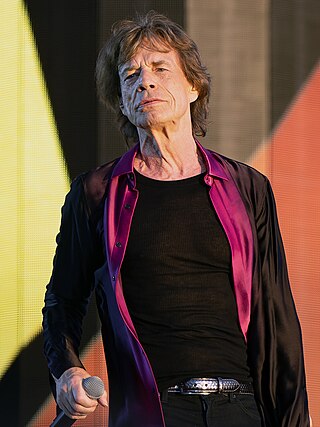
Sir Michael Philip Jagger is an English singer, songwriter, actor, filmmaker, and dancer. He is the frontman and one of the founder members of the rock band the Rolling Stones. Jagger has written most of the band's songs alongside lead guitarist Keith Richards; their songwriting partnership is one of the most successful in history, and they continue to collaborate musically. His career has spanned over six decades, and he has been widely described as one of the most popular and influential frontmen in the history of rock music. His distinctive voice and energetic live performances, along with Richards' guitar style, have been the Rolling Stones' trademark throughout the band's career. Jagger gained notoriety for his romantic involvements and illicit drug use, and has often been portrayed as a countercultural figure.

Ike & Tina Turner were an American musical duo consisting of husband and wife Ike Turner and Tina Turner. From 1960 to 1976, they performed live as the Ike & Tina Turner Revue , supported by Ike Turner's band the Kings of Rhythm and backing vocalists called the Ikettes. The Ike & Tina Turner Revue was regarded as "one of the most potent live acts on the R&B circuit."
The Altamont Speedway Free Festival was a counterculture rock concert in the United States, held on Saturday, December 6, 1969, at the Altamont Speedway outside of Tracy, California. Approximately 300,000 attended the concert, and some anticipated that it would be a "Woodstock West". The Woodstock festival had been held in Bethel, New York, in mid-August, almost four months earlier.
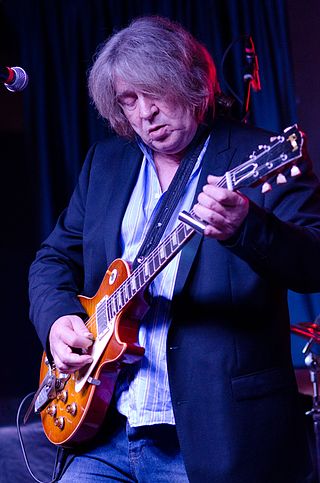
Michael Kevin Taylor is an English guitarist, best known as a former member of John Mayall's Bluesbreakers (1967–1969) and the Rolling Stones (1969–1974). As a member of the Stones, he appeared on Let It Bleed (1969), Get Yer Ya-Ya's Out! The Rolling Stones in Concert (1970), Sticky Fingers (1971), Exile on Main St. (1972), Goats Head Soup (1973) and It's Only Rock 'n Roll (1974).
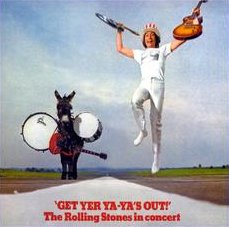
Get Yer Ya-Ya's Out!: The Rolling Stones in Concert is the second live album by the Rolling Stones, released on 4 September 1970 on Decca Records in the UK and on London Records in the US. It was recorded in New York City and Baltimore in November 1969, just before the release of Let It Bleed . It is the first live album to reach number 1 in the UK. It was reported to have been issued in response to the well known bootleg Live'r Than You'll Ever Be . This was also the band's final release under the Decca record label and not under their own label Rolling Stones Records.

" Honky Tonk Women " is a song by the English rock band the Rolling Stones. It was released as a non-album single on 4 July 1969 in the United Kingdom, and a week later in the United States. It topped the charts in both nations. The song was on Rolling Stone ' s 500 Greatest Songs of All Time list, and was inducted into the Grammy Hall of Fame.
Meredith Curly Hunter Jr. was an American man who was killed at the 1969 Altamont Free Concert. During the performance by the Rolling Stones, Hunter approached the stage, and was violently driven off by members of the Hells Angels Motorcycle Club who had agreed to prevent members of the audience from mounting the stage. He subsequently returned to the stage area, drew a revolver, and was stabbed and beaten to death by Hells Angel Alan Passaro.

Gimme Shelter is a 1970 American documentary film directed by Albert and David Maysles and Charlotte Zwerin chronicling the last weeks of The Rolling Stones' 1969 US tour which culminated in the disastrous Altamont Free Concert and the killing of Meredith Hunter. The film is named after "Gimme Shelter", the lead track from the group's 1969 album Let It Bleed . Gimme Shelter was screened out of competition as the opening film of the 1971 Cannes Film Festival.
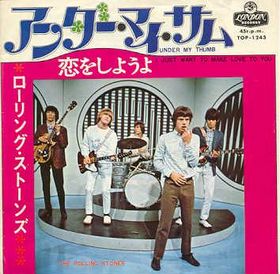
" Under My Thumb " is a song recorded by the English rock band the Rolling Stones. Written by Mick Jagger and Keith Richards, "Under My Thumb" features a marimba played by Brian Jones. Although it was never released as a single in English-speaking countries, it is one of the band's more popular songs from the late 1960s and appears on several best-of compilations, such as Hot Rocks 1964–1971 . It was included as the fourth track on both the American and United Kingdom versions of the band's 1966 studio album Aftermath .
" Gimme Shelter " is a song by English rock band the Rolling Stones. It is the opening track on their 1969 album Let It Bleed . The song covers the brutal realities of war, including murder, rape and fear. It features prominent guest vocals by American singer Merry Clayton.
" Midnight Rambler " is a song by English rock band The Rolling Stones, released on their 1969 album Let It Bleed . The song is a loose biography of Albert DeSalvo, who confessed to being the Boston Strangler.

" It's Only Rock 'n Roll (But I Like It) " is the lead single from English rock band the Rolling Stones' 1974 album It's Only Rock 'n Roll . Writing is credited to Mick Jagger and Keith Richards and the single reached the top ten in the UK charts and top 20 in the United States.

The Rolling Stones American Tour 1972 , also known as the "Stones Touring Party", shortened to S.T.P., was a much-publicized and much-written-about concert tour of the United States and Canada in June and July 1972 by The Rolling Stones. Constituting the band's first performances in the United States following the Altamont Free Concert in December 1969, critic Dave Marsh would later write that the tour was "part of rock and roll legend" and one of the "benchmarks of an era."

The Rolling Stones' Steel Wheels Tour was a concert tour which was launched in North America in August 1989 to promote the band's album Steel Wheels ; it continued to Japan in February 1990, with ten shows at the Tokyo Dome. The European leg of the tour, which featured a different stage and logo, was called the Urban Jungle Tour ; it ran from May to August 1990. These would be the last live concerts for the band with original member Bill Wyman on bass guitar. This tour would also be the longest the band had ever done up to that point, playing over twice as many shows as their standard tour length from the 1960s and 1970s.
The Rolling Stones' US Tour 1978 was a concert tour of the United States that took place during June and July 1978, immediately following the release of the group's 1978 album Some Girls . Like the 1972 and 1975 U.S. tours, Bill Graham was the tour promoter. One opening act was Peter Tosh, who was sometimes joined by Mick Jagger for their duet "Don't Look Back". The Outlaws backed up Peter Tosh. Another act opening that day was Etta James, famous for her classic song “At Last”.

The Rolling Stones' American Tour 1981 was a concert tour of stadiums and arenas in the United States to promote the album Tattoo You . It was the largest grossing tour of 1981 with $50 million in ticket sales. Roughly 2,5 million concert goers attended the concerts, setting various ticket sales records. The 5 December show in New Orleans set an indoor concert attendance record which stood for 33 years.
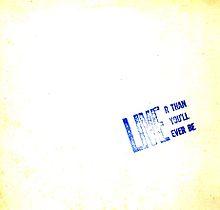
Live'r Than You'll Ever Be is a bootleg recording of the Rolling Stones' concert in Oakland, California, from 9 November 1969. It was one of the first live rock music bootlegs and was made notorious as a document of their 1969 tour of the United States. The popularity of the bootleg forced the Stones' labels Decca Records in the UK, and London Records in the US, to release the live album Get Yer Ya-Ya's Out! The Rolling Stones in Concert in 1970. Live'r is also one of the earliest commercial bootleg recordings in rock history, released in December 1969, just two months after the Beatles' Kum Back and five months after Bob Dylan's Great White Wonder . Like the two earlier records, Live'r ' s outer sleeve is plain white, with its name stamped on in ink.

Ronald Schneider is best known for being the business presence at the center of pivotal 1960s events including the Altamont Free Concert, the dissolution of The Beatles and the reorganization of their business arm, Apple Corps. Schneider managed the early US tours of The Rolling Stones while simultaneously dealing with the financial affairs of some of the biggest names in Rock and Roll history including the Stones, The Beatles, Neil Sedaka, Sam Cooke, Nancy Wilson, Bobby Vinton, Herman’s Hermits and the Shirelles.
- 1 2 "The Rolling Stones, Ike & Tina, B.B. King, Terry Reid" (PDF) . Cash Box : 44. 6 December 1969.
- 1 2 Robert Christgau, "The Rolling Stones", entry in The Rolling Stone History of Rock & Roll , Random House , 1980. pp. 198–199.
- ↑ Marsh, Dave (1987). Glory Days: Bruce Springsteen in the 1980s . Pantheon Books . ISBN 0-394-54668-7 . p. 15.
- ↑ "The 50 Greatest Concerts of the Last 50 Years" . Rolling Stone . 12 June 2017.
- 1 2 3 4 Mike Jahn (28 November 1969). "The Rolling Stones Are Still Exciting" . The New York Times .
- ↑ "Stones rehearse in the basement of Stephen Stills' Lurel Canyon home | Musicians in 2019 | Rolling stones, Like a rolling stone, Rock, roll" . Pinterest . Retrieved 20 September 2019 .
- 1 2 3 4 5 "Rolling Stones Open Tour With West Coast Concert" . Associated Press for The New York Times . 10 November 1969.
- 1 2 3 4 5 6 7 8 9 10 Francis X. Clines (28 November 1969). "16,000 at Madison Square Garden Shout With Joy in Reaction to Sounds of Rolling Stones" . The New York Times .
- ↑ Stephen Davis. Old Gods Almost Dead. New York: Broadway Books , 2001, ISBN 0-7679-0313-7 , p. 307.
- ↑ The Rolling Stones (1969). The Stones in the Park (DVD released 2006). Network Studios.
- ↑ Get Yer Ya-Ya's Out! The Rolling Stones in Concert (LP). Decca Records . 1970.
- 1 2 Martin, Linda; Kerry Segrave (1993). Anti-rock: The Opposition to Rock 'n' Roll . Da Capo Press . ISBN 0-306-80502-2 . pp. 160–161.
- ↑ Cutler, Sam. "You Can't Always Get What You Want: My Life with the Rolling Stones and other Wonderful Reprobates". Heinemann. 2008. ISBN 9781741666090
- ↑ Rusten, Ian M. (2018). The Rolling Stones in Concert, 1962–1982: A Show-by-Show History . McFarland. ISBN 978-1-4766-3443-2 .
- 1 2 Sessa, Sam (27 November 2009). "Rolling Stones in Baltimore -- 40 years later" . The Baltimore Sun . Retrieved 26 February 2021 .
- 'Rocks Off' 1969 tour setlists
- 'Frayed' 1969 tour pages
- Discography
- Club Imperial
- Club Manhattan
- Bolic Sound
- Prann Records
- Sony Records
- Teena Records
- Sonja Records
- Innis Records
- What's Love Got to Do with It

- Additional Artists
- Notable Equipment
Search form
You are here, the rolling stones american tour 1969, the rolling stones.
- Read more about The Rolling Stones
Altamont Free Concert
- Read more about Altamont Free Concert
- Statistics Stats
- You are here:
- Rolling Stones, The
- November 8, 1969 Setlist
The Rolling Stones Setlist at The Forum, Inglewood, CA, USA
- Edit setlist songs
- Edit venue & date
Edit set times
- Add to festival
- Report setlist
Tour: Let It Bleed Tour statistics Add setlist
- Jumpin' Jack Flash Play Video
- Carol ( Chuck Berry cover) Play Video
- Sympathy for the Devil Play Video
- Stray Cat Blues Play Video
- Prodigal Son ( Robert Wilkins cover) Play Video
- You Gotta Move ( [traditional] cover) ( Live debut ) Play Video
- Love in Vain Blues ( Robert Johnson cover) Play Video
- I'm Free Play Video
- Under My Thumb Play Video
- Midnight Rambler Play Video
- Live With Me Play Video
- Little Queenie ( Chuck Berry cover) Play Video
- (I Can't Get No) Satisfaction Play Video
- Honky Tonk Women Play Video
- Street Fighting Man Play Video
Note: 2nd Show on this day
Edits and Comments
30 activities (last edit by hjnintendofan , 28 Apr 2024, 02:26 Etc/UTC )
Songs on Albums
- Carol by Chuck Berry
- Little Queenie by Chuck Berry
- Love in Vain Blues by Robert Johnson
- Prodigal Son by Robert Wilkins
- You Gotta Move by [traditional]
- Stray Cat Blues
- Street Fighting Man
- Sympathy for the Devil
- Live With Me
- Midnight Rambler
- (I Can't Get No) Satisfaction
- I'm Free
- Honky Tonk Women
- Jumpin' Jack Flash
- Under My Thumb
Complete Album stats
More from The Rolling Stones
- More Setlists
- Artist Statistics
- Add setlist
Related News
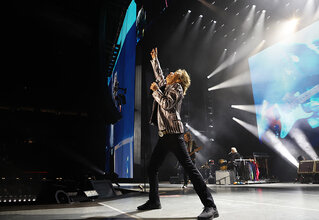
Rolling Stones Kick Off Tour with a Classic Never Performed in US
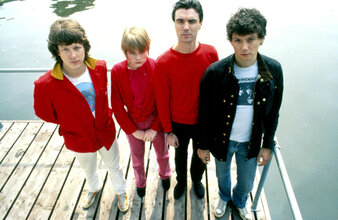
Five Live Pieces of Vinyl to Snatch Up on Record Store Day
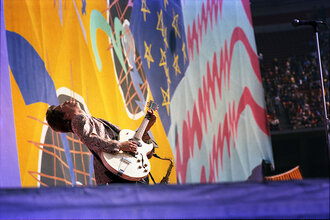
Setlist History: George Thorogood Plays 50 U.S. States in 50 Days
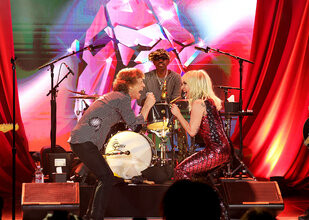
Rolling Stones Debut New Songs with Lady Gaga in Surprise Show
- The Rolling Stones Add time Add time
- B.B. King Add time Add time
- Terry Reid Add time Add time
- Ike & Tina Turner Add time Add time
- The Rolling Stones This Setlist Start time: 4:00 AM 4:00 AM
The Rolling Stones Gig Timeline
- Jul 05 1969 The Stones in the Park London, England Add time Add time
- Nov 07 1969 Moby Gym, Colorado State University Fort Collins, CO, USA Add time Add time
- Nov 08 1969 The Forum This Setlist Inglewood, CA, USA Start time: 4:00 AM 4:00 AM
- Nov 08 1969 The Forum Inglewood, CA, USA Add time Add time
- Nov 09 1969 Oakland-Alameda County Coliseum Arena Oakland, CA, USA Add time Add time
4 people were there
- stephenhuerta
- Tattoowayne
Share or embed this setlist
Use this setlist for your event review and get all updates automatically!
<div style="text-align: center;" class="setlistImage"><a href="https://www.setlist.fm/setlist/the-rolling-stones/1969/the-forum-inglewood-ca-23d6f807.html" title="The Rolling Stones Setlist The Forum, Inglewood, CA, USA 1969, Let It Bleed" target="_blank"><img src="https://www.setlist.fm/widgets/setlist-image-v1?id=23d6f807" alt="The Rolling Stones Setlist The Forum, Inglewood, CA, USA 1969, Let It Bleed" style="border: 0;" /></a> <div><a href="https://www.setlist.fm/edit?setlist=23d6f807&step=song">Edit this setlist</a> | <a href="https://www.setlist.fm/setlists/the-rolling-stones-bd6ad22.html">More The Rolling Stones setlists</a></div></div>
Last.fm Event Review
[url=https://www.setlist.fm/setlist/the-rolling-stones/1969/the-forum-inglewood-ca-23d6f807.html][img]https://www.setlist.fm/widgets/setlist-image-v1?id=23d6f807[/img][/url] [url=https://www.setlist.fm/edit?setlist=23d6f807&step=song]Edit this setlist[/url] | [url=https://www.setlist.fm/setlists/the-rolling-stones-bd6ad22.html]More The Rolling Stones setlists[/url]
Tour Update
Marquee memories: brainstory.
- May 14, 2024
- May 13, 2024
- May 12, 2024
- May 11, 2024
- May 10, 2024
- May 9, 2024
- FAQ | Help | About
- Terms of Service
- Ad Choices | Privacy Policy
- Feature requests
- Songtexte.com
“Let It Bleed”: Behind the Rolling Stones’ 1969 U.S. Tour
By Rolling Stone
Rolling Stone
Courtesy of Let it Bleed , the book, text and photographs by Ethan Russell. Available from Rhino .
Ethan Russell: Let It Bleed: Breakfast

Courtesy of Let It Bleed , the book, text and photographs by Ethan Russell. Available from Rhino .
Ethan Russell: Let It Bleed: Brian Jones

Ethan Russell: Let It Bleed: Keith

Ethan Russell: Let It Bleed: LA COLISSEUM backstage

Ethan Russell: Let It Bleed: Mick and Chuck

Ethan Russell: Let It Bleed: Mick being touched in Oakland

Ethan Russell: Let It Bleed: Mick Fort Collins

Ethan Russell: Let It Bleed: Mick Keith and Baby

Ethan Russell: Let It Bleed: Mick Portrait (Nov 69)

Ethan Russell: Let It Bleed: on stage 1972

Ethan Russell: Let It Bleed: Rock N Roll Circus

Sean Combs' Accused Drug 'Mule' Strikes Deal in Cocaine Case
- COURTS AND CRIME
- By Cheyenne Roundtree
Nicholas Galitzine Dances All Night to the Best Song Ever in August Moon 'Guard Down' Video
- The Idea of You
- By Larisha Paul
Is a Happy Avett Brothers as Good as a Sad One?
- ALBUM REVIEW
- By David Browne
Kamala Harris' Renaissance Tour Tickets Were on the House Courtesy of Beyoncé
- House of Renaissance
Drake Leads 2024 BET Awards With Seven Nominations
- 2024 BET Awards
- By Daniel Kreps
Most Popular
'mad max' director says 'there's no excuse' for tom hardy and charlize theron's 'fury road' set feud: tom 'had to be coaxed out of his trailer', sam rubin, longtime ktla entertainment reporter and anchor, dies at 64, melania trump confirms her son barron just made a total 180 once again with his future, dj akademiks says he'll take entire industry down if convicted in rape lawsuit, you might also like, john mulaney’s ‘everybody’s in l.a.’ moved to emmys talk series category to face late night hosts (exclusive), gwen stefani favors feathers in laser-cut roberto cavalli jacket for acm awards 2024 red carpet with blake shelton, the best yoga mats for any practice, according to instructors, the state of streaming bundles, under armour plans revamp after dour earnings report.
Rolling Stone is a part of Penske Media Corporation. © 2024 Rolling Stone, LLC. All rights reserved.
Verify it's you
Please log in.
- Led Zeppelin Documentary
- Jagger & Richards Yearly Photos
- Forgotten Frontmen
- 50 Greatest Solo Artists
- Donald Fagen's Steely Dan Regret
- Longest-Lasting Current Lineups

Reliving the Rolling Stones’ 1969 Thanksgiving Concerts
By the waning days of 1969, the Rolling Stones were well on their way to becoming the "Greatest Rock 'n' Roll Band in the World." Hits like “(I Can’t Get No) Satisfaction,” “Get Off My Cloud” and “Paint It, Black” had already made them stars. Amazingly, the group would soar to even grander heights in the ‘70s thanks to seminal albums Sticky Fingers and Exile on Main St. .
With the Stones on the precipice of worldwide domination, they took the stage for three shows at New York's Madison Square Garden on Nov. 27 and 28, 1969. These landmark performances would be immortalized on the live album Get Yer Ya-Ya’s Out! , as well as the documentary Gimme Shelter .
More recently, author Christopher McKittrick has chronicled the intertwining history of the Stones and the Big Apple in the book Can't Give It Away on Seventh Avenue: The Rolling Stones and New York City .
The legendary 1969 Madison Square Garden concerts deservedly received notable attention in the book. In the excerpt below, McKittrick examines the surrounding circumstances, intricate details and historical significance of those performances.
On Sept. 17, ABKCO, Allen Klein’s label, announced that the Stones would tour the United States in November and December for the first time since 1966. Their popularity hadn’t waned at all during their three-year absence. In fact, it had grown. Since then, the Stones had had two No. 1 hits (“Ruby Tuesday” and “Honky Tonk Women”) as well as a No. 3 hit (“Jumpin’ Jack Flash”) and two other Top 40 hits (“Dandelion” and “She’s a Rainbow”). Though the Stones had played a mix of theaters and arena-sized venues on the 1966 tour, they tackled larger venues this time around, with some locations getting both matinee and evening shows. Years later, Richards recalled, “It had gotten to the point by 1969 where to satisfy all our fans in a city, we had to play six or eight shows. We just didn’t have enough nights. So we either had to disappoint people or move up to bigger places.” The tour would include three concerts in two days in Manhattan, and those would be the band’s largest yet in New York City. For the Stones, it showed the surge of popularity the band had experienced over the previous three years. After drawing a crowd of nine thousand to the Forest Hills Stadium in 1966, the Stones were planning to play three shows — one on Thanksgiving, Nov. 27, and two on Nov. 28 — at Madison Square Garden, an arena that had broken ground just four days after the Stones’ first appearance on The Ed Sullivan Show .
The history of Madison Square Garden, which has branded itself “The World’s Most Famous Arena” for decades, tells the story of popular entertainment in New York over the past century and a half. The arena where the Stones played three shows in 1969 — and have played more than a dozen times since — is actually the fourth version of the Garden. Three previous arenas bearing the name — the first two located adjacent to Madison Square Park, hence the name — had been operating in Manhattan since 1879. By the time the fourth Garden opened in February 1968, the arena was an entertainment destination known as the premier sporting complex in the country. The previous Garden, which was located a block west of Times Square on Eighth Avenue between 49th and 50th Streets until the new arena took its place, was Manhattan’s indoor sports hub and was home to the New York Rangers, the New York Knicks, college basketball and dozens of high-profile boxing matches.
Controversially, the site selected for the new Garden was between Seventh and Eighth Avenues from 31st to 33rd Streets, and required the demolition of Pennsylvania Station, which was moved underground and below the Garden. The demolition of the historic railroad station spurned a movement to save New York’s Grand Central Terminal from a similar fate and began a preservation movement for historical buildings, including several historic venues the Stones members would later play with their solo bands. The Stones would take advantage of the historic nature of Grand Central decades later when announcing their 1989 world tour.
It’s hard to find an athlete or a performer who doesn’t hold Madison Square Garden in awe. Countless historical moments, including several involving the Rolling Stones, have happened at the arena. The Garden is celebrated for its superior sound and atmosphere. As rock journalist Al Aronowitz wrote about the arena in his 1972 review of a Stones show, “The structure is built sort of like a trampoline hanging from cables that stretch across the ceiling and the hotter the rock show, the more it bounces.” Many musicians consider headlining the Garden the true measure of “making it.” The new Garden quickly became a popular stop for top rock acts, and since opening it had already hosted several concerts, including Cream on Nov. 2, 1968 (the first rock concert at the Garden), the Doors on Jan. 24, 1969, and Jimi Hendrix on May 18, 1969. The Stones would be the first rock band to perform multiple shows at the arena.
Though the Garden could hold more than 20,000 people for concerts, the Stones capped the capacity between 16,000 and 17,000. While planning the tour, Richards explained to Rolling Stone , “In all the future gigs, we want to keep the audiences as small as possible. We’d rather play to four shows of 5,000 people each, than one mammoth 50,000 sort of number. I think we’re playing at Madison Square Garden in New York, but it will be a reduced audience, because we’re not going to allow them to sell all the seats.”
It was also the first tour on which the Stones played an extended set. In previous tours, the sets had not been much longer than a half hour and ten songs or less, which was a standard length for most touring rock groups at the time. By the end of the '60s that had changed, and groups like Cream were playing an hour to 90 minutes. The Stones followed suit by playing a fourteen-song set at Hyde Park, and would generally play 13 to 15 songs per concert during the US tour.
Despite the band’s hell-raising reputation, once the tour began with a warm-up show in Fort Collins, Col., on Nov. 7, the Stones had relatively few issues through the New York dates at the end of November. There were some complaints about ticket prices — mostly ranging from $4.50 to $8 — though in the case of New York, that was cheaper than the $5 to $12.50 that was charged for the 1966 Forest Hills concert. However, Bill Graham, who promoted the California shows, was reportedly unhappy with the concerts’ grosses. Nonetheless, Graham worked with the Stones on future tours because he believed in them. In a post-tour interview with Rolling Stone, Graham compared the Rolling Stones to the 1969 “Miracle” New York Mets, a team that had been a perennial loser since its first season in 1962 but that went on to win the World Series in 1969. Graham said, “What I hope the Stones do is turn the whole country on, do what the Mets did for New York, wake ’em up. And I think the Stones can do it. Mick Jagger is the greatest fucking performer in the whole fucking world.”
The Stones also taped performances of “Gimme Shelter,” “Love in Vain” and “Honky Tonk Women” for The Ed Sullivan Show on Nov. 18, and Jagger also taped a short interview. All of these aired on Nov. 23. Unlike with their previous appearances, however, the Stones were recorded in Los Angeles at CBS Television City studios. Sullivan told the Associated Press that he traveled cross-country because “these boys are hot, especially with the younger crowd. They’re on a concert tour, so I decided to come here and tape them. They cost a lot of money, but they’re worth it.” The Ed Sullivan Show had suffered declining ratings over the past several years, and the Stones were a proven draw. Nevertheless, this was the band’s final appearance on Sullivan’s show, which ended its lengthy run in June 1971.
The Stones hosted the only official press conference of the tour at the Rainbow Grill in Rockefeller Center on Nov. 26, just hours before they were to play the Civic Center in Baltimore 200 miles away. The Washington Post set the scene as: “After being submitted to a security check unrivaled at the Pentagon, journalists were given drinks and canapés while a string quartet played Haydn.” In contrast to how the Stones had been depicted in the media for the previous five years, the AP report said that the Stones were “the most polite persons there.” There was pandemonium among the press trying to get their questions in, leading Jagger to ask, “Shall we scream at you like you’re screaming at us?” Jagger was also asked his opinion of New York City, to which he responded, “It’s great. It changes. It explodes.” He was also asked if he had yet felt satisfied, to which he responded, “Financially dissatisfied, sexually satisfied, philosophically trying.” The most notable thing to come out of the press conference was the announcement that the group would be headlining a daylong free concert in Golden Gate Park in San Francisco, though the group also shot down longstanding rumors that they would do a similar free show in Central Park. (“Now is too cold,” Jagger said. “We’ve got to do it outside. And San Francisco is really into that sort of thing.”) Part of the Stones’ motivation for doing a free performance in the U.S. was to fight back against criticism that the ticket prices for the 1969 tour were too high. After 25 minutes of mostly inane questions, the Stones were off to Baltimore.
The day after the Baltimore concert was Thanksgiving, and that night was the Stones’ first-ever performance at Madison Square Garden. While New York is known for the Macy’s Thanksgiving Day Parade, the most anticipated event in Manhattan that day was the Stones concert. Six thousand people had stood in line at the Garden box office to buy tickets when they went on sale on November 6, and both evening performances were sold out (the matinee performance still had “a couple of hundred” empty seats, according to Rolling Stone).
All three Garden shows had the same set list, though the order differed for the first show. Each started with the same four songs: “Jumpin’ Jack Flash,” “Carol,” “Sympathy for the Devil” and “Stray Cat Blues.” They also ended with the same six: “Midnight Rambler,” “Live with Me,” “Little Queenie,” “Satisfaction,” “Honky Tonk Women” and “Street Fighting Man.” For the middle portion, the Stones played “Love in Vain,” “Prodigal Son,” “You Gotta Move” and a medley of “Under My Thumb” and “I’m Free.” The Garden shows were recorded for both a potential live album and by filmmaking brothers Albert and David Maysles for a possible documentary.
In his review of the first show for The New York Times , Mike Jahn praised Jagger, writing that he “snarls and howls in the finest man-woman blues tradition,” and that the concert was “an enthusiastic reading of some of a fine group’s finest material.” However, he complained about the layout of the bill. The Stones did not take the stage until 11PM, three hours after the concert started. Terry Reid opened the show, followed by B.B. King and then Ike and Tina Turner (the Turners were joined by a very inebriated Janis Joplin at the first show for their set-ending “Land of a Thousand Dances”). A second report in The Times by Francis X. Clines noted that that the NYPD wasn’t overly concerned with security because it believed that “the basically middle-class audience had only holiday entertainment in mind.” The AP report was complimentary to the band in general, but seemed turned off by Jagger’s antics and remarked, “The biggest hits with the audience were those songs that put down women: ‘Under My Thumb,’ ‘Satisfaction’ and ‘Honky Tonk Women.’ Teenage girls apparently wouldn’t mind being dominated by Jagger.”
The Garden shows were far more remembered for their musical quality than any onstage scandals. Nine of the 10 tracks on the band’s first live album, Get Yer Ya-Ya’s Out! , which was released the following September, came from these three shows. The original release included “Jumpin’ Jack Flash” and “Honky Tonk Women” from the Nov. 27 show; “Carol,” “Stray Cat Blues,” “Sympathy for the Devil,” “Little Queenie ” and “Street Fighting Man” from the Nov. 28 matinee show; and “Midnight Rambler” and “Live with Me” from the evening show (the tenth track, “Love in Vain,” was recorded at the Nov. 26 Baltimore concert). Jagger and Richards re-recorded some of the vocal tracks in London in January and February 1970, though in 2009 the album was re-released with unaltered bonus tracks, featuring “Under My Thumb” and “I’m Free” from Nov. 27, “Satisfaction” from the Nov. 28 matinee show, and “Prodigal Son” and “You Gotta Move” from the evening show. An accompanying DVD also included footage of the Nov. 27 performances of “Prodigal Son,” “You Gotta Move" and “Satisfaction” and Nov. 28 matinee performances of “Under My Thumb” and “I’m Free.”
Jagger’s attire was much noted for a long red scarf that he wore, which one eager New York fan managed to grab, nearly pulling him off the stage. Jagger also had something of a wardrobe malfunction during one of the Nov. 28 shows, and teased the audience by saying, “I think I’ve busted a button on me trousers and me trousers are going to fall down. You don’t want me trousers to fall down, do you?” The third show ended with five thousand rose petals raining from the ceiling to send the Stones off.
As the NYPD predicted, the shows were without incident aside from scalpers outside charging up to $40 for a pair of tickets that cost $3.50. In fact, the biggest scandal involving the Madison Square Garden shows did not even involve the Stones at all. Gossip columnist Steven A. Brandt, who wrote for Photoplay magazine, attended the Nov. 27 show with several friends, including Ultra Violet, an actress who appeared in several of Andy Warhol’s films. Brandt left the concert early (“The concert was so lively, so opposite himself,” Violet told the Associated Press) and returned to his room at the Hotel Chelsea, the famed 23rd Street building that was a haven for artists, musicians, and writers; at one time or another, Bob Dylan, Janis Joplin, Tom Waits, Patti Smith, Leonard Cohen and Iggy Pop all called it home. Violet called Brandt after the concert, and he told her that he had taken twenty-two pills. She called the Chelsea’s night clerk, who found Brandt on the floor. Medical help was unable to get to Brandt before he died of an overdose.
Nov. 27 was also Jimi Hendrix’s 27th (and notably last) birthday. He attended the show that night and hung out with the group backstage. Interestingly enough, at an after-party for Hendrix’s birthday uptown, a moment between Jagger and Hendrix’s then-girlfriend, Devon Wilson, inspired a lyric to one of Hendrix’s final songs. Jagger had previously been involved with Wilson, and Hendrix had previously tried to steal Marianne Faithfull from Jagger while he was dating her, so there was a level of animosity between the pair. Jagger cut his finger at the party, and while a bandage was sought, Wilson grabbed Jagger’s finger and began sucking it. The moment inspired the lyric “ She drinks her blood from a jagged edge ,” in Hendrix’s song about Wilson, “Dolly Dagger.” The song was not released until October 1971, which was not only after Hendrix’s death but also after Wilson’s. She died on Feb. 19, 1971, after plunging to her death out of a ninth-floor window at the Hotel Chelsea under mysterious circumstances.
Rolling Stones Live Albums Ranked
More from ultimate classic rock.
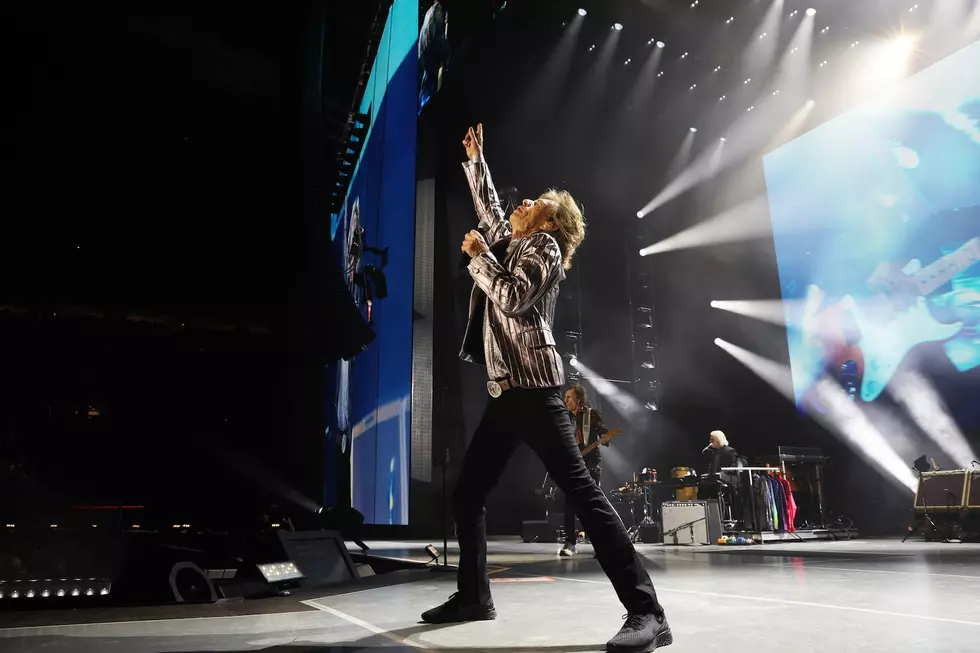

- Latest News
‘All Eyez On Me’: 2Pac’s Poignant And Seminal 1996 Milestone
‘baduizm’: the album that crowned erykah high priestess of neo soul, ‘dummy’: how portishead captured the zeitgeist like no other band, ‘master of puppets’: an album of firsts and lasts for metallica, ‘straight outta compton’: why nwa’s debut album still blows you away, live review: ado slays 70,000 fans with homecoming show at tokyo’s olympic stadium, jimmy buffett vinyl reissue series continues, apple music unveils more ‘100 best albums of all time’ with titles by portishead and more, weezer appear on the kelly clarkson show to celebrate blue album 30th anniversary, afi celebrates 25th anniversary of ‘black sails in the sunset’ with vinyl reissue, liana flores announces debut album ‘flower of the soul’, schoolboy q’s ‘oxymoron’ gets 10th anniversary edition vinyl release, apple music continues ‘100 best albums of all time’ with elton john, lana del rey, and more, katy perry’s ‘roar’ music video hits 4 billion views, hyde park, july 5, 1969: a moment that defined the rolling stones.
The Rolling Stones’ 1969 Hyde Park concert has become the stuff of legend: a gig that helped define the band during a moment of crisis.
Published on
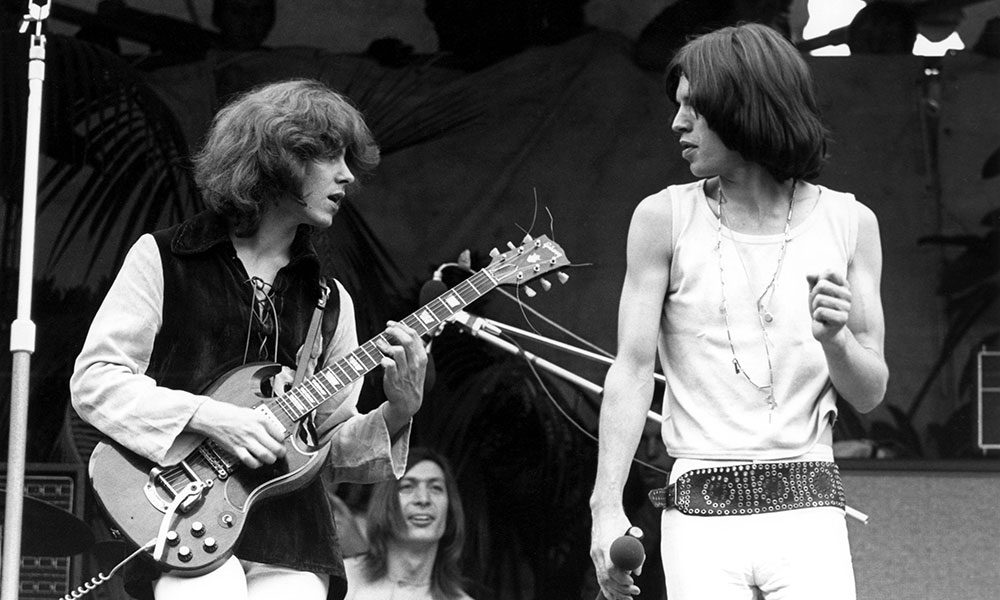
At London’s Hyde Park, on July 5, 1969, at 5:25 PM, there was a moment that has come to define The Rolling Stones .
“The greatest rock and roll band in the world. They’re incredible; let’s hear it for the Stones!”
It was the first time The Rolling Stones had been branded such. Today, of course, that phrase – the greatest rock and roll band in the world – and The Rolling Stones are inseparable.
Calling Cards: How Rory Gallagher’s 70s Albums Built The Legend
57 mother’s day songs: a playlist of classic songs about moms, ‘just one night’: eric clapton thrills tokyo’s budokan.
Sam Cutler was the one who said it. Cutler worked for Blackhill Enterprises, the company that staged the first free concerts in Hyde Park. At the time, he was looking out at an audience later estimated between 250,000 and 500,000 people.
The Rolling Stones’ gig in 1969 was not the first rock concert in London’s famous park. Pink Floyd headlined the first free gig a year before, and several other bands followed, including Eric Clapton and Steve Winwood ’s short-lived Blind Faith in June 1969. (Mick Jagger and Marianne Faithfull both attended.) But The Rolling Stone concert is the one that everyone seems to talk about. Ask anyone of a certain age: “Were you at the Hyde Park concert?” They know exactly what concert you’re referring to.
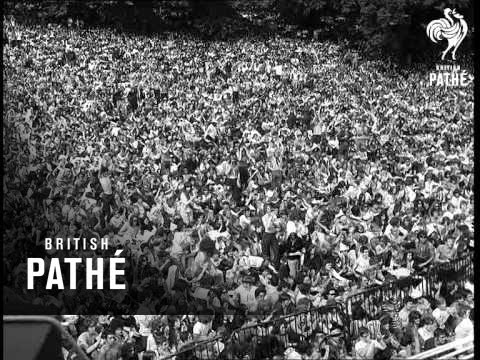
Paying tribute to Brian Jones
There are many things that make that concert both unique and special. It was the band’s first concert in almost two years, and marked the debut of guitarist Mick Taylor. (Taylor had previously been part of John Mayall’s Bluesbreakers and had only joined the group a few months earlier, replacing Brian Jones.) Looming over the entire concert, of course, was Jones’s tragic death in a swimming pool, two days earlier.
The group decided to soldier on, and beautifully paid tribute to Jones. “Alright! Ok now listen,” said Mick. “Will you just cool it for a minute ‘cos I really would like to say something for Brian. I’d really dig it if you would be with us while I do it. I’d like to say a few words that I feel about Brian… I’m going to say something written by Shelley.”
Peace, peace! he is not dead, he doth not sleep -– He hath awakened from the dream of life -– ‘Tis we, who lost in stormy visions, keep With phantoms an unprofitable strife…
The poem was “Adonais” by Percy Bysshe Shelley. And, as Mick finished reciting the poem, Tom Keylock, the band’s road manager released over 3,000 white butterflies, a gesture that cost the band £300, but one that came to define the concert.
One of the other defining features of The Rolling Stones’ Hyde Park concert was Jagger’s attire. The singer was wearing a Michael Fish Greek-inspired voile “dress.” (When the band played Hyde Park in 2013, Mick nodded to it by wearing a blue jacket covered in a white butterfly motif.)
The Rolling Stones concert
The stage for the concert was tiny. “When Blind Faith did it, they set this stage in the middle of the grass, put the drums and amplification on it and everyone turned up and went around it,” Charlie Watts remembered in 2013. “When we did it, we had a Mickey Mouse little stage, a tiny thing on metal scaffolding, drums, a bit of backdrop for Mick with his white dress on, and everybody just came. Now, of course, it’s a proper enclosed area.”
But no matter. The group’s opener, somewhat surprisingly was “I’m Yours and I’m Hers.” The song wasn’t a Stones’ original, but one written by Texan albino blues guitarist Johnny Winter. The tune had featured on his just-released debut Columbia album. Keith Richards had bought it back in June, and it was his suggestion that they opened the show with it. It was the first – and only – time the band has ever performed it on stage.
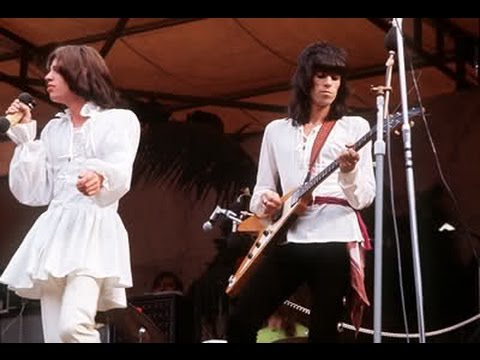
Next up was another first, the first time the Stones ever performed “Jumpin’ Jack Flash” on stage. The crowd knew this one well. The song had topped the charts for a couple of weeks the previous summer. On their tour of the US in the autumn of 1969, it became their usual opener. Don Covay’s “Mercy Mercy” came next and it was another less than obvious choice, given that it was recorded way back in May 1965. Following it, “Stray Cat Blues,” “No Expectations,” and “I’m Free” also got their live debut.
“Down Home Girl” was the oldest number in their set, having been recorded in late 1964 and released on the band’s second British album. From there, they moved on to a very old song: a cover of Robert Johnson’s “Love in Vain” which he had recorded way back in 1937. It was a new song for the band, though. They had recorded it a few months earlier, and would eventually appear on Let It Bleed later in 1969.
“Loving Cup” was a new song from The Glimmer Twins, which the group had been working on in the studio; it finally made it onto Exile on Main St. in 1972. They followed with “ Honky Tonk Women ,” their new single, and next came “Midnight Rambler,” which became the opening track of side two of Let it Bleed . (In some press reports of the Hyde Park concert, it was referred to as “The Boston Gambler.”)
“(I Can’t Get No) Satisfaction” was the only survivor from the Stones’ previous tour in April 1967. “Street Fighting Man” preceded “Sympathy for the Devil,” which were both off Beggars Banquet . During “Sympathy for the Devil,” The Rolling Stones were joined on stage by Ginger Johnson’s African Drummers. (Johnson was a veteran of the London jazz club scene.)
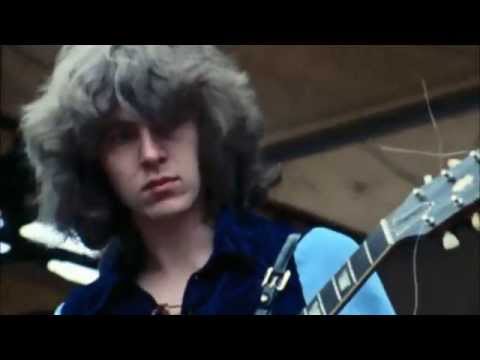
Sam Cutler’s introduction of “the greatest rock and roll band in the world” was spontaneous, but it’s become an entirely appropriate way to describe the group. Cutler used the phrase to introduce them throughout their US tour later in the year, and it can be heard on Get Your Ya Yas Out , the live album recorded on the tour. It reflected just how far they came from their local blues band beginnings. Or their pop heartthrob status, for that matter. As one music paper said in an issue that came out a week after the Hyde Park concert, “99% of the audience came to listen and not (as they might have done five years ago) to scream.” The times were a-changin’…
Listen to more classic live Rolling Stones performances on Spotify .
Mark Jaeger
July 5, 2016 at 3:56 pm
“Neither ‘Stray Cat Blues’ nor ‘No Expectations’ had ever been performed live before…”
Minor point: The Stones did, in fact, perform “No Expectations” (with Brian Jones on slide guitar) in front of a live audience as part of their segment of the abortive “Rock ‘n’ Roll Circus” film in December 1968. As is well known, “Circus” finally saw commercial release in 1996.
https://www.youtube.com/watch?v=9KZsvbR3Cnw
Steve Rocovitz
July 5, 2016 at 5:30 pm
When I go see them in Las Vegas in Oct.it will be my 13th or 14th time l’ve seen them,1972 Long Beach Ca. was the 1st,they were great then and they were great every time I’ ve seen them,people ask me why I go see them every time they are around,my answer is I love Rock&Roll,and they are the worlds greatest Rock&Roll Band and always will be!
February 24, 2021 at 7:27 pm
I wanted to love this concert film but truth be told, it’s not good.
July 31, 2021 at 8:08 pm
Their concerts have never let me down from the first time I saw them live in Hyde Park in ’69.
July 5, 2023 at 7:37 pm
painful watching Mick Taylor trying to remember how to play his guitar. fortunately for all of us and especially the stones, he soon figured it out. He was key to their becoming the worlds ggrnrb
January 4, 2024 at 4:26 pm
They did perform Jumpin Jack Flash , live , initially , at the NME polwinners concert , in 1968 , from what ive read , in the past.
Your email address will not be published. Required fields are marked *
Save my name, email, and website in this browser for the next time I comment.

The Rolling Stones' first Phoenix concert in 1965 was a fever dream: 'So raw and so real'
The Rolling Stones were fast emerging as “the HAIR-apparents to the Beatles’ throne,” as The Arizona Republic put it, by the time they made their first appearance on a Phoenix stage.
It was a Tuesday night, Nov. 30, 1965, and the British Invaders were nearing the end of their fourth North American tour in support of an album called “Out of Our Heads,” as they took the stage of a new multi-purpose arena situated on the north side of the Arizona State Fairgrounds.
Earlier that month, the Stones had spent two weeks at No. 1 on Billboard’s Hot 100. “Get Off of My Cloud” was their second classic hit to top the U.S. charts in 1965. They’d spent four weeks at No. 1 that summer with one of the British Invasion’s most iconic moments, “(I Can’t Get No) Satisfaction.”
The Stones drew 'a screaming mass of 7,500 hysterical teen-agers'
The Stones arrived for their performance in an armored car a local bank supplied for the occasion.
Need a break? Play the USA TODAY Daily Crossword Puzzle.
“The new fairground coliseum became a screaming mass of 7,500 hysterical teen-agers,” The Republic’s Pete Marinovich reported.
“Ridiculous? Remember Sinatra? Remember the fainting, screaming girls willing to be trampled into the hospital for just one touch of the skinny singing sensation? That was another time, another place, but what’s the difference?”
Cindy Smith Dunaway, then 16, was among those screaming girls.
She attended the show with some friends and her brother, Neal Smith, who would go on to be inducted to the Rock and Roll Hall of Fame as a member of a group called Alice Cooper alongside Cindy’s future husband, Dennis Dunaway.

'My girlfriends and I were crying so much. It was like a dream come true'
“My girlfriends and I were crying so much because we couldn't believe we were actually finally seeing the Stones,” she says.
“I mean, it was really one of those moments like in 'Hard Days Night,' where the girls were crying and screaming because we just loved them so much and thought they were so cool. I loved the Beatles, but I was always a bigger Stones fan.”
The concert itself was “amazing,” she says.
“We couldn't believe they were actually there on stage in front of us. It was like a dream come true. And it was pandemonium. We were all like, ‘Oh, my God. We're here. And they're here.’”
And Alice Cooper was there
Alice Cooper remembers it well. He was 17 and still attending Cortez High School, where his classmates knew him as Vince Furnier.
“There was no lights, no special effects, it was these five guys standing sort of like they would be at a bar,” he says.
“And they were the Rolling Stones. Which that was all you had to know. It was at that time when the Beatles were still the greatest, but here comes the Stones, which is like, ‘Oh my gosh, this changes everything.’ They were the people’s band, the band every kid on the street could relate to.”
Cooper still thinks of Mick Jagger as the prototype of what it even means to be the singer in a rock ‘n’ roll band.
“Every lead singer on this planet owes everything to him,” he says. “Think of it. Before that, bands were a unit. Mick Jagger broke away from all that and did his little James Brown and his Mick Jagger rooster. He created his own character that is still the best in the business.”
And that was very much the Jagger he saw in Phoenix that night.
“It was so raw and so real,” he says. “It was like seeing them in a giant club. It was really exciting, the fact that you got to see them when they were the young, nasty Rolling Stones. The music was nasty, the look was nasty, the attitude was nasty and that just made it perfect.”
The local fan club president gave Mick Jagger a big wooden key to the city
Marianne Gilbert was 13 at the time. She loved the Rolling Stones enough to be co-president of the local Stones fan club.
“I walked around downtown Phoenix asking people to sign a petition to bring them to Phoenix,” she recalls. “Most people didn’t even know who they were yet. Embarrassingly, I had a roll of adding machine tape and I used that for my petition. There were thousands of names collected over many months, and it was sent to their official fan club in London.”
It seemed to take “forever” for the Stones to make their way to Phoenix, Gilbert says. But one day, KRIZ Boss Radio announced that they were bringing them to town.
Tickets were $4.50, tax included.
The concert was originally booked for Phoenix Union High School’s Montgomery Stadium (near where Arizona Center now stands) but moved to the just-opened Veterans Memorial Coliseum, where Phoenix police were out in force, should all that adulation boil over.
“If all the policemen had bought tickets, it would have been a sellout,” Marinovich quipped in The Republic. “A hundred men in blue threw a human barricade around a state eight feet off the floor, patrolled the aisles, the exits and the driveways leading to the rear, where ‘the messiahs’ would enter.”
The audience began arriving at 4 in the afternoon.
Gilbert and her friends skipped school the day of the show and took a taxi to the Executive House in Scottsdale, where the Stones were staying, to present them with a big wooden key to the city her mother had made and a large cardboard “Welcome to Phoenix Rolling Stones - We Love You” sign.
They were about to give up and head to the concert when she saw Jagger standing in the window of the coffee shop blowing kisses at them.
“Charlie Watts was with him in a booth, and they were getting ready to eat,” she recalls. “We very awkwardly presented them with the key that we had been carrying everywhere with us. It was heavy, and I have no doubt that they most likely left it at the coffee shop when they were finished eating. I’m sure it didn’t mean anything to them.”
KRIZ left special tickets at the box office for Gilbert and her friends.
“We didn’t really believe we had special tickets, so we ran down to the stage like everyone else,” she says.
'We watched the show of a lifetime'
“I broke the heel off my shoe and my purse strap broke as I ran. At that time, no one in Phoenix had shoulder strap purses, but they were big in England.”
It wasn’t until the usher showed them to their seats that Gilbert realized she was front-row center for the Rolling Stones.
“I had the now-tattered sign I’d been carrying all day, and put it in front of me,” she says. “And from there, we watched the show of a lifetime.”
She remembers screaming a lot “like a typical 13-year-old” and how special it felt to see the Rolling Stones in person.
“Brian Jones wore a pair of green plaid pants and a turtleneck shirt,” she says. “Later, I bought some green plaid fabric and my mom made me some pants like his.”
Alice Cooper bassist Dennis Dunaway said they were 'the most exciting band we'd ever seen'
Three acts performed before the Stones: The Vibrations, the Rockin’ Ramrods and Patti LaBelle and her Blue Belles. Pat McMahon of “The Wallace and Ladmo Show” introduced the Stones.
Alice Cooper bassist Dennis Dunaway was there with guitarist Glen Buxton. At the time, they were both in the Spiders, a group that formed at Cortez High School (as the Earwigs) with Cooper on lead vocals.
“Patti LaBelle and the Blue Belles were so good,” Dunaway recalls.
“We thought they were amazing. It seemed like an hour before the Stones finally came out. They kept the crowd waiting forever. I was thinking, 'Well, either they're doing interviews or they want to wait until the excitement over Patti LaBelle and the Blue Belles dies down before they hit the stage.'"
Dunaway recalls “just this explosion of excitement” when the Stones took the stage. “And a very short set. I mean, half an hour maybe. But you didn't care because you saw the Stones. They were the most exciting band we'd ever seen.”
When Cindy Smith Dunaway wrote about it in her diary after the concert, she wrote that they did eight songs.
A setlist for the tour on Wikipedia.com says they would’ve played “She Said Yeah,” “Hitch Hike,” “Heart of Stone,” “Mercy, Mercy,” “That’s How Strong My Love Is,” “Play With Fire,” “The Last Time,” “Good Times,” “Oh Baby,” “Get Off of My Cloud,” “I’m Moving On” and “(I Can’t Get No) Satisfaction.”
Regardless of what songs they played, the screaming nearly drowned them out.
It was hard to hear the Rolling Stones over the crowd
“Even though it was this giant coliseum building, PA systems were just terrible in those days,” Dunaway says. “They were more for someone to announce the license plate number of a car that needed to be moved in the parking lot. So it was pretty much just screaming. You could distinguish what the songs were, but it was more of just this unbelievable excitement and screaming than actually listening to what songs they were playing.”
Dunaway recalls the Stones’ performance being very much like he’d seen them do in “T.A.M.I. Show,” a legendary concert film released in 1964 that featured a mix of rock and R&B stars.
“Brian Jones looked the coolest,” he says. And Jagger brought his A-game to the coliseum as a frontman.
“He was all over the stage, like you would imagine,” Dunaway says.
“They had already done the T.A.M.I. Show, where they had to follow James Brown. They were up upstairs watching his performance before they went on. And according to legend, that was the first time Jagger started jumping around the stage.”
'It seemed like everyone we knew was there'
Skip Ladd was there with future Alice Cooper drummer Neal Smith. They were bandmates in a high school surf band called the Laser Beats.
“I ditched school that day to be the first in line,” Ladd says. “I brought a portable battery-operated record player to play ‘12 X 5’ while waiting."
Dunaway says he and Buxton talked their way into the concert without buying tickets. They showed up early with empty cardboard guitar cases and knocked until somebody opened the door.
“We told him we were the Rolling Stones and showed him our guitar cases,” Dunaway says. “Plus we had long hair. And he let us in. We ditched the cases under the bleachers and laid low until they let the paying crowd in.”
There were a lot of young musicians in the coliseum taking notes that night.
“It seemed like everyone we knew was there,” Dunaway says. “All the Phoenix bands. All the guys in the Tubes. Mike McFadden. The guys from P-Nut Butter. Everybody that was old enough for their parents to allow them to go to a concert.”
A lot of parents did not want their kids going anywhere near the Rolling Stones in 1965.
“The Stones were pretty controversial,” Dunaway says. “They were the bad boys of rock. First, people thought the Beatles were a bad influence on the youth. Then when the Stones came out, all of a sudden the Beatles looked squeaky clean.”
Alice Cooper drummer Neal Smith: One of the top live shows he's seen
"The Rolling Stones climbed out of the back of an armored truck to go onstage! Cool entrance," Ladd recalls. "Brian Jones was with them, perfect blonde bangs. Keith Richards had his new Fuzz Tone. He’d step on it and get this big grin on his face, turn towards the amp for controlled feedback, then turn back on ‘Satisfaction.’ Girls were screaming and didn’t want to leave, lost control! Mick Jagger had most of the girls going crazy. Bill Wyman was like the anchor on stage synced up with Charlie Watts.”
Smith’s memories of that day are mostly focused on the member of the Stones whose long blonde hair inspired him to grow his own hair even longer.
“I was such a Brian Jones fan,” Smith says. “To me, he was the No. 1 guy in the Stones. As I recall, in that show, he had on tight green jeans, a long-sleeve green turtleneck shirt through his sweater and pink bedroom slippers. I just thought that was so (expletive) outrageous. I was like, 'You gotta be kidding me.’”
Smith loved their whole bad boys of rock ‘n’ roll image. “Compared to everything else in those days, the Beatles were pretty outrageous,” he says. “But the Stones were more uncouth, unkempt."
The crowd reaction also left a huge impression on Smith. This was his second concert, having seen the Beach Boys at the Fairgrounds in the summer of ‘64.
“The girls are going crazy, screaming all around me,” he says. “So it's all starting to sink in. The screaming was so loud, the music was almost inaudible. It was just the whole experience. To see them up there playing and hearing more screaming than music. That was probably one of the top five live shows I ever saw in my life.”
'You wouldn't think that they would come to Arizona, but they did'
Smith’s sister Cindy and her friends also hit the Executive House in the hope of meeting the Stones when the concert was over. At one point, she hid in the closet of one of the rooms where the Stones were believed to be staying, having entered the room through a sliding glass door.
“I was like, 'Well, this is awkward,’” she says.
“And then at one point I heard everybody starting to come down the hall. And I just I got too scared. I was like, 'Oh my God, what if they think I'm here for some other reason?' So I was like, I'm not staying in here.' I ran out of the room. And then we all we all went home.”
The next morning, Cindy and some of her friends ditched school and returned to the Executive House to try again. This time, they saw Jagger playing golf and befriended a maid who gave her the Do Not Disturb sign and a sheet from Jagger’s hotel room.
“I was like, ‘Oh my God,’” she says.
“That sheet stayed in my mom's cedar chest for years and years. I never washed it. Finally, my mom was like, 'We gotta wash this.' But anyway, that was my adventure. And I don't think we ever got caught for ditching, which is the amazing part.”
It was the perfect ending to a life-changing experience.
“It was one of those magical moments when you got to see one of your fave bands in the whole world,” Cindy says. “And you wouldn't think that they would come to Arizona, but they did, which was amazing.”
The Rolling Stones will perform at State Farm Stadium on Tuesday, May 7. It's their third time at the Stadium.
Rolling Stones 2024 tour at State Farm Stadium in Glendale
When: 8 p.m. Tuesday, May 7.
Where: State Farm Stadium, 1 Cardinals Way, Glendale.
Admission: $63 and up.
Details: 800-745-3000, SeatGeek.com .
Reach the reporter at [email protected] or 602-444-4495. Follow him on X (formerly Twitter) @EdMasley .
Support local journalism. Subscribe to azcentral.com today.

Rolling Stones rock Seattle's Lumen Field in legendary return after 5 years
F or the first time in five years, The Rolling Stones returned to Seattle to perform inside Lumen Field to a crowd full of rock and roll fans.
The stones are iconic. A lot of us travel to see them because they are just that band," Tim Taylor said. "Here we are in 2024, and the Rolling Stones are still coming to Seattle. I go to every show.
Fans from around the country paid tribute to what many called the greatest rock and roll band of all time.
Some fans celebrate birthdays, anniversaries, and just the concert in itself.
I waited until I was 72 years old to finally see the Stones," John Sherman said. "Mic Jagger is an inspiration. Eighty years old, and he can just move right! So if I last that long, I will be happy.
Fan favorite, Mick Jagger, rocked the stage for hours at the age of 80. A feat many in attendance said was impressive and legendary.
"I have seen them many times, and the guy is almost 81. Tell me anyone who is 81 who can move like him," another fan said.
The Rolling Stones also brought a big boost to the local economy, with fans filling downtown hotels and restaurants, helping boost local tourism.

Time is still on Mick Jagger's side as the Rolling Stones thrash State Farm Stadium
Could there be a human being better suited to performing “Time Is on My Side” in 2024 than Mick Jagger at 80?
To be clear, the Rolling Stones did not include that gospel-flavored classic in the set they played at State Farm Stadium in Glendale on Tuesday, May 7.
But watching Jagger do what Jagger does for nearly two hours in metro Phoenix so soon after seeing those videos of him leading the Stones through “Time Is on My Side” just five days earlier as a duet with the amazing Irma Thomas, who also sounded great at age 83, at the New Orleans Jazz & Heritage Festival?
You couldn’t help but marvel at the age-defying essence of what Jagger brings to a performance .
'So raw': The Rolling Stones' first Phoenix concert in 1965 was a fever dream
Need a break? Play the USA TODAY Daily Crossword Puzzle.
Mick Jagger was in total command at the Stones' Phoenix concert
It went beyond the sheer perpetual motion of it all. Yes, he rarely stopped moving. And there's a world of singers less than half his age who couldn't hope to match the energy he brought to State Farm Stadium.
But there’s an undeniable agility to what he does, an athleticism and a grace that invites you to imagine Mikhail Baryshnikov raised by a family of overcaffeinated roosters.
That side-to-side motion he does with his feet? The graceful swiveling of those hips that have been swiveling since the very early ‘60s? The youthful exuberance with which he glides and struts and sometimes even runs across a massive stage?
There was even a magical moment in the encore as the Stones were bringing “(I Can’t Get No) Satisfaction” to a fevered pitch that he dropped to his knees as though he might channeling a young James Brown — at 80.
He got so into it on "Satisfaction," Keith Richards couldn't stop grinning.
The man was in total command of the stage from the time his bandmates found their footing after staggering into a looser-limbed-than-usual “Start Me Up” to the glorious pileup of iconic hits that brought their set to a breathless climax through the encore-closing “(I Can’t Get No) Satisfaction.”
Rolling Stones setlist: Every song they sang in Phoenix on the 2024 Hackney Diamonds Tour
The Rolling Stones thrive on rawness and reckless abandon
By the second song, “It’s Only Rock ‘N Roll (But I Like It),” the Rolling Stones were firing on all cylinders.
It wasn’t always pretty. And it damn sure wasn’t perfect. But the Rolling Stones have done as much as anyone to help define a rock ‘n’ roll aesthetic that thrives on the rawness and reckless abandon at the heart of what they do.
This is especially true of the guitars.
Founding member Richards and kindred spirit Ronnie Wood, who started playing with the Stones while still a member of the Faces in 1975, are essentially flip sides of the same Chuck Berry 45. They spent the night dialing up some of the raunchiest guitar sounds you could ever hope to hear, the volume just too loud enough.
Their guitar work was scrappy and soulful and ragged and real and all those other underrated qualities that make for an exciting night of rock 'n' roll, the kind of night the Rolling Stones have always been so brilliant at delivering.
And it was to great to see them having such a good time, Richards grinning ear to ear in his red knit cap and Wood engaging in the sort of loopy onstage antics that made him such a perfect onstage foil for Richards when he joined the fold back in the '70s.
Here's the Rolling Stones 2024 lineup
This was Rolling Stones’ first time in metro Phoenix since the loss of founding member Charlie Watts, who died in 2021 after encouraging his bandmates to bring in Steve Jordan on drums to finish the No Filter Tour without him when he got too sick to carry on.
Jordan has been touring with them ever since and it’s easy to see why Watts thought he was the right man for the job.
He and Darryl Jones, their touring bassist since Bill Wyman left the group in 1993, are a commanding rhythm section, a point made abundantly clear on a hard-grooving version of “Miss You” that featured a jaw-dropping solo from Jones.
Rounding out their touring band are keyboard player Chuck Leavell; Bernard Fowler on backing vocals and percussion; Matt Clifford on keyboard and the French horn on “You Can’t Always Get What You Want”; saxophonists Karl Denson and Tim Reis; and backing vocalist Chanel Haynes, who joined the fold in 2022 and stepped into the spotlight with her awe-inspiring vocal turn on “Gimme Shelter.”
They’re all extremely talented musicians more than capable of following the Stones through a variety of musical aesthetics, from the classic boogie-woogie groove of “Tumbling Dice” to the disco moves of “Miss You,” the Latin percussion of “Sympathy for the Devil,” the rock ‘n’ roll swagger of “Jumpin’ Jack Flash” and the soulful splendor of “Gimme Shelter” and “You Can’t Always Get What You Want.”
'Hackney Diamonds' is Rolling Stones' 1st new album in nearly 20 years
The Stones are touring in support of “Hackney Diamonds,” their first album of original material in nearly 20 years. A lot of critics have called it their best release since “Tattoo You” in 1981 or even “Some Girls” three years earlier. And it’s easy to hear why those critics would say that.
It’s kind of amazing that a group that’s been around for more than 60 years could still be operating on that level, much less sound so vital.
They only played three songs from “Hackney Diamonds,” but all three more than held their own against the staples fans had come to hear, from the slashing guitar riffs and snarling lead vocals of “Angry” to the disco-flavored “Mess It Up” and the smoldering gospel of “Sweet Sounds of Heaven,” a ballad they boldly held back to open the encore that featured another soulful show of force from Haynes.
“Sweet Sounds of Heaven” also boasted one of Jagger’s strongest vocals of the night. And there were many strong contenders for that title, from the soulful conviction with which he delivered “You Can’t Always Get What You Want” to the excitement he brought to the end of “(I Can’t Get No) Satisfaction.”
He may have flubbed the occasional lyric, and there were some notes he didn’t try to hit. But overall, Jagger’s vocal performance was as age-defying as his movements.
Other highlights ranged from “She’s So Cold,” a song that hadn’t made a setlist since 2019, to Keith Richards taking a turn in the vocal spotlight on “Little T&A” (a song he introduced as “She’s My Little Rock & Roll” after telling the crowd, “It’s good to be here; it’s good to be anywhere”) and “Monkey Man,” which won the online fan vote.
World's greatest rock 'n' roll band? That seems right
It was all great, though. How many bands could even hope to bring a set to a climax by stringing together a series of songs as iconic as “Sympathy for the Devil,” “Honky Tonk Women,” “Miss You,” “Gimme Shelter,” “Paint It, Black” and “Jumpin’ Jack Flash”?
If you want to be known as the world’s greatest rock ‘n’ roll band, that’s one way to do it.
It was after a spirited version of "Tumbling Dice" that Jagger took a moment to address how pleased he was with the welcome the Stones had received from the city of Glendale.
The city renamed a portion of 95th Avenue near the stadium Satisfaction Way and the mayor declared May 7 Ruby Tuesday.
"We’re very honored that you chose to name today Ruby Tuesday, though," he said.
"That is so nice. It’s never happened to us before. Ruby Tuesday. Unfortunately, we’re not gonna be able to play it tonight because we’ve forgotten that one."
As they were nearing the end of their set, after “Honky Tonk Women,” Jagger did some reminiscing.
“My goodness, this is our 11th show in Arizona,” he said. “Isn’t that something? I want to thank you so much for coming back to see us. You know, my favorite show in Arizona was in 1997 when we accidentally set fire to the Sun Devil Stadium.”
Then, after “Miss You,” he told the crowd, “We’re gonna go out to Valley Bar after, OK? So you can join us there.”
Having gone to Valley Bar and hung around until it closed at 2 a.m., I can assure you, he was joking.
By the time they signed off with a raucous thrill ride through an epic “(I Can’t Get No) Satisfaction,” Tuesday night at State Farm Stadium was everything a Stones fan could’ve hoped for, the quintessential rock ‘n’ roll survivors still going strong after 62 years, invigorated by their new music.
Carin Leon and Electric Mud opened for the Rolling Stones
Forty-five minutes before the show was scheduled to begin, a band from San Diego called Electric Mud (the title of a Muddy Waters album) took the stage and delivered a well-received set that often felt like they were channeling the Rolling Stones of an early '70s vintage, especially those Jagger-esque lead vocals.
Two members of Electric Mud — Marc and Matty Hansen — have an aunt named Patti Hansen who's been married to Keith Richards since 1983. That may be how they got the gig, but they turned out to be a perfect fit.
Electric Mud was followed by regional Mexican music star Carin Leon , whose latest effort, “Colmillo de Leche," picked up Best Norteño Album at last year's Latin Grammys.
He wasn't nearly as perfect a fit, but went over surprisingly well on the strength of a powerful performance, fronting a 16-piece band complete with accordion and tuba and wearing black leather pants and matching vest over a black T-shirt, a black cowboy hat completing his look. Highlights of Leon's set included "It Was Always You (Siempre Fuiste Tú)" and Johnny Cash's "Man in Black."
Rolling Stones setlist 2024: Every song they played in Phoenix
Here's every song the Rolling Stones performed at State Farm Stadium in Glendale, AZ .
- “Start Me Up”
- “It's Only Rock 'n' Roll (but I Like It)” (tour debut)
- “She's So Cold”
- “Beast of Burden”
- “Monkey Man” (tour debut; fan-voted song)
- “Mess It Up”
- “Tumbling Dice”
- “You Can't Always Get What You Want” (followed by band introductions)
- “Little T&A” (Keith Richards on lead vocals)
- “Sympathy for the Devil”
- “Honky Tonk Women”
- “Gimme Shelter”
- “Paint It, Black”
- “Jumpin' Jack Flash”
- “Sweet Sounds of Heaven”
- “(I Can't Get No) Satisfaction”
Reach the reporter at [email protected] . Follow him on X (formerly Twitter) @EdMasley and facebook.com/ed.masley
Support local journalism. Subscribe to azcentral.com today.
Too old to rock 'n' roll? Not these bands or their Long Island fans

Ronnie Wood, left, Mick Jagger, and Keith Richards of the Rolling Stones perform during their "Hackney Diamonds" tour on April 28 in Houston. Credit: Amy Harris/Invision/AP/Amy Harris
When the Rolling Stones embarked on their “Tattoo You” stadium tour in 1981, the band (whose key members were all under 40) was perceived as being over the hill and ribbed by the press that the tour should be sponsored by Geritol. Fast forward to 2024, the Stones — Mick Jagger and Keith Richards are 80; Ronnie Wood a spry 76 — are still selling out stadiums, and their new tour, which comes to MetLife Stadium in New Jersey on May 23 and 26, is being sponsored by AARP.
“The Stones are the best rock and roll band that has ever lived, in my opinion. They still sound amazing and remain entertaining,” says Krissy Pangia, 56, of Centerport. “There’s nothing like their staying power. It’s unheard of.”
Jagger and company are not an anomaly. These days, rock stars are living and playing longer while their fans are still coming to see them in droves. It seems that neither side wants the party to end.
Pangia is a hard-core Stones fan who is hitting 10 shows on the band’s 16-city U.S. tour. Her 1969 Chevrolet Camaro convertible is covered in thousands of Stones tongues, with a license plate that reads, “CRZYMAMA” after the band’s 1975 tune and she proudly has two Stones tattoos on her body. Pangia has seen the band more than 40 times, from California to London, always in the general admission pit upfront.

Krissy Pangia, 56, of Centerport, proudly displays her 1969 Chevrolet Camaro convertible covered in Rolling Stones tongues in front of the Memory Motel in Montauk. Credit: Krissy Pangia
On opening night of the new tour in Houston on April 28, Pangia felt the need to be in the crowd and was floored by what she saw.
Get the latest on celebs, TV and more.
By clicking Sign up, you agree to our privacy policy .
“I don’t know what Mick Jagger is made of, but he’s not human,” says Pangia. “He was literally sprinting up and down the catwalk … at 80 years old!”
She brought along her-82 year-old mother, Suzanne Asher, of Northport, who has since become a fan.
“My daughter’s passion for the Stones always kind of puzzled me. But when I got to the concert and felt the vibe, I understood what this whole experience is all about,” says Asher. “I found Mick Jagger inspiring. In fact, I now push myself to exercise because after seeing Mick move like that, there’s no reason I can’t.”
“These are our heroes from the '60s and '70s that we grew up with and we don’t want them to go away,” says regular concert attendee Tom Hessemer, 62, of North Merrick. “I think the performance quality is still there. No one has let me down yet.”
POWER OF THE STAGE

Nancy Wilson of Heart: "On stage I feel ageless." Credit: WireImage/Al Pereira
As these musicians age, there must be something beyond compensation that makes them refuse to pack it in.
“On stage I feel ageless. It’s an elevated experience with the sound, the lights and the energy coming from the audience,” says Nancy Wilson, 70, guitarist-vocalist of Heart, who is playing Madison Square Garden on Oct. 21. “Time stands still. You are larger than life. It’s what all the travel and hassle is for. We get paid to travel, but the payoff is the joy to create magic on stage and share it with your fans.”
Chicago's trombone player, James Pankow, 76, whose band comes to Northwell Health at Jones Beach Theater on July 28, adds: “I feel 20 years old every time I step on stage. I can’t even describe the energy rush you get when you hear that roar of approval. You feel like King Kong.”
ENERGY EXCHANGE

Kevin Cronin, of REO Speedwagon, on the relationship between band and fan: "It’s an interconnection that’s similar to cheering on your favorite team.” Credit: Invision/AP/Robert E. Klein
Just like the artists, the audience is addicted to the concert energy. Throughout each show there’s an exchange between the band and the fans.
“When we come out on stage, it’s a give-and-take proposition. We give to them and they give back to us. We toss it back twofold, they toss it back threefold,” says guitarist Rickey Medlocke, 74, from Lynyrd Skynyrd, who hits Jones Beach on Aug. 22. “By the end of the night, your adrenaline is at an all-time high.”
“The better the energy of the audience, the better the concert is,” says Mitchell Katz, 57, of Lindenhurst, who follows Jethro Tull, the Steve Miller Band and Yes. “The audience helps the band make the actual event.”
Kevin Cronin, 72, lead singer-guitarist of REO Speedwagon, who is coming to Jones Beach on July 27, adds: “When you go see a band play, it’s like sitting around the campfire with peers that you have something in common with. It’s an interconnection that’s similar to cheering on your favorite team.”
Neil Berliner, who grew up in Bellmore, is a regular concert attendee who embraces the live music atmosphere.
“I enjoy being around people who like the music that I like,” says Berliner, 68. “We all recognize the same songs at the same time. It’s a shared community.”
FAN DEDICATION
When it comes to legacy artists like the Stones, Lynyrd Skynyrd and Chicago, fans have a tendency to see them whenever they come to town. But what keeps the audiences returning time after time?
“You always know the classic bands are going to give you a good set list and a full show,” says avid concertgoer Paul Esposito, 55, of Wantagh, who likes The Who, U2, Depeche Mode, Pearl Jam and Metallica. “Plus, you never know when it’s going to be the last time.”
Hessemer makes catching Bruce Springsteen on every tour a priority. He says The Boss is always worth the investment.
“You’ll never be disappointed at a Springsteen show because he’ll give you the classics as well as some rare nuggets,” says Hessemer. “Bruce is not on Autopilot. He mixes it up night after night to keep it fresh.”
WHAT GENERATION GAP?

Mike Love, of The Beach Boys: “We have fans bringing their children and even their elderly parents to our shows." Credit: Invision/AP/Amy Harris
Many bands benefit from their original fans passing on the tradition to their own children because they want to share what they grew up listening to.
“We have fans bringing their children and even their elderly parents to our shows. It’s rare when multiple generations can agree on a particular act,” says singer Mike Love, 83,of the Beach Boys, who will return to Jones Beach on Aug. 8. “We are lucky that what we started six decades ago is still popular with millions of people.”
Ilysse Blatt-Stojek, 45, of Holtsville, has been going to Beach Boys concerts since she was in diapers. These days whenever the group comes to Long Island, she and her mother, Arlene Blatt, 79, of Coram, can be found in the first few rows.
“My mom wants to be able to see every gray hair and wrinkle on their faces,” says Blatt-Stojek. “No matter what they are singing about, their positive energy is always there.”
Blatt adds, “I love that California sound. They have been my favorite group since 1963 when they first came out with ‘Surfin’ U.S.A.’ Their music puts me in a great frame of mind. If I could be on the stage with them, I would be.”
Jeff Bloch, of Sayville, introduced his daughter Talia, 20, and son Sam, 16, to the music of the Grateful Dead via annual shows by Dead & Co. at Citi Field.
“I love that it’s such a community,” says Bloch, 54. “When I’m in the parking lot at a Dead show it’s very nostalgic because I think back to my college days and it’s extra trippy to have my kids there.”
SENTIMENTAL ATTACHMENT
What keeps fans so dedicated to these icons is not about sheer adoration but rather their emotional attachment to the material.
“These artists are responsible for some of the most classic rock songs ever created,” says concert promoter Larry Vaughn, 81, of Bethpage, who brought The Police to Shea Stadium in 1983 and Pink Floyd to Nassau Coliseum in 1980. “The audience has grown up with that music from their early teens and it touched their soul so much that they continue to buy tickets to see them perform live as long as they can.”
Berliner says, “The songs bring you back to when you first heard them. It reminds people of what was going on in their lives when the music was actually made.”
The Yes song “Changes” holds a special place in Katz’s heart because of the concert memory he has attached to it. “I saw Yes on the "90125" tour and they were playing ‘Changes.’ When the lights came on, the person behind me wound up being my wife of 30 years,” he says.
Bands often hear about these emotional ties whenever they come face-to-face with fans at preshow meet-and-greet sessions.
“A guy will come up to me and say, ‘My wife and I fell in love to this song’ or ‘I danced with my daughter at her wedding to that song,’ ” says Pankow. “I hear those stories every night and it’s priceless. We could only be extremely grateful for how our music has been embraced by so many people.”
STAYING IN SHAPE

Ruth Pointer: "I’m meticulous about my food, eating only vegetables, proteins and fruits, no carbs or sugars.” Credit: Mike Sayles
Traveling from city to city putting on a show is not an easy feat. While it might seem glamorous from the outside, it takes a lot of preparation especially at an advanced age.
“These artists are all living longer because they are taking care of themselves better than they have in the past,” says concert promoter Ron Delsener, 87, of East Hampton, who started the concert series at Jones Beach more than 40 years ago. “They are all working out, eating better, not smoking or doing anything else.”
Ruth Pointer, 78, of the Pointer Sisters, is in training as she gears up to play Jones Beach on July 25.
“I stay sharp and in practice,” says Pointer. “I exercise three days a week with a treadmill, free weights, crunches and yoga stretches. Plus, I’m meticulous about my food, eating only vegetables, proteins and fruits, no carbs or sugars.”

Judy Collins: "I’m blessed to have the DNA of my grandparents, who lived until 104." Credit: Getty Images for Tribeca Festival/Jamie McCarthy
Singer-songwriter Judy Collins, 85, plays over 100 dates a year including her upcoming July 12 gig at The Suffolk in Riverhead.
“Exercising, eating right, getting plenty of sleep and practicing are essential on the road,” she says. “Another key thing is to keep people laughing. Plus, I’m blessed to have the DNA of my grandparents, who lived until 104.”
Love has found practicing transcendental meditation, or TM, has helped him tremendously while enduring the rigors of the road.
“TM allows the mind to go to a deeper level and your body corresponds to a deeply restful and relaxing mode that re-energizes you,” he says. “You are getting rid of the negativity that happens during the day and become rejuvenated.”
BAND MEMBER SHUFFLE
One of the casualties from being a legacy band is the loss of members. The Stones had to fill the seat behind the drum kit with Steve Jordan when original drummer Charlie Watts died in 2021. Lynyrd Skynyrd dealt with a similar situation when founding guitarist Gary Rossington died in 2023; the group brought in axman Damon Johnson from Brother Cane.
“When Gary passed away, we were at a crossroads,” says Medlocke. “It was always his wish for the band name and the music to not fade away after he was gone. Our goal is to keep his wishes intact.”
Pointer found herself being the only sister left after her siblings, Anita, Bonnie and June, were all gone. Keeping it in the family, she brought her daughter Issa and granddaughter Sadako into the group.
“When I look to either side and see them, I say to myself, ‘Am I in a dream? Is this really happening?’ ” says Pointer. “They both give me energy. I don’t do as many moves as I used to. I know what my knees can and can’t do. But I step back and let them have at it.”
Other groups added members like the Doobie Brothers, who will play Madison Square Garden on Aug. 7. They have brought former Doobie Michael McDonald back into the fold.
“It’s been great having Michael on board. People love him and he’s fun to work with,” says singer-guitarist Tom Johnston, 75. “I think we can pull better having Mike in there with his songs. It gives a much wider range of what the band is capable of doing.”
William King, 75, the last original member of the Commodores, who will play at Jones Beach on July 25, is recruiting family members of the founders to join the group.
“Our kids have been around this music since they were born. Some of them traveled on the road with us for years,” says King. “They knew the songs backwards and forwards before they even stepped foot on stage. In fact, they were singing better than we were because they grew up around all of this.”
DON’T STOP US NOW

Carlos Santana: “When you play music fully present and lucid then you are going to be relevant for the next 50 to 100 years." Credit: Newsday/J. Conrad Williams Jr.
The word “retirement” is not in these acts’ vocabulary. It appears the overall sentiment is to drive the car until the wheels fall off.
“I just love to play,” says Medlocke. “When I have time off, I get very antsy and bored. I need to be on stage.”
Vocalist-singer Billy F. Gibbons, 74, from ZZ Top, who comes to Jones Beach on Aug. 22, adds: “The roadshow is what we do and it’s what we relish keeping going. We’re having a grand time and each night on deck steps up the learning platform. And then, it's do what? Stay home with a TV? It’s that secret sauce that ZZ Top is imbued with thrilling to the marrow.”
Pointer admits to having notions of stopping, but then has second thoughts.
“I’m not that girl who wants to sit around the house,” she says. “I don’t garden, ya know.”
Carlos Santana, 76, who plays Jones Beach on July 21, has no plans to slow down, either. “When you play music fully present and lucid then you are going to be relevant for the next 50 to 100 years,” he says. “People are like flowers, music is the water, I’m a hose and they are all thirsty.”
The 2024 summer concert season at Jones Beach will open with a trio of senior citizens as Robert Plant, 75, Bob Dylan, 82 and Willie Nelson, 91, headline the Outlaw Music Festival on June 29.
“I am thrilled to get back on the road again with my family and friends playing the music we love for the fans we love,” said Nelson at the announcement of the tour, which runs for 25 dates from June through September.
In fact, Dylan has been playing nonstop on his “Rough and Rowdy Ways Tour” clocking in 24 gigs already in 2024.
“I think Bob Dylan will go until he dies, like B.B. King,” says Berliner. “His life is on the road. Plus, he keeps pumping out good music.”
WHEN DOES IT END?

Earth Wind and Fire lead singer Philip Bailey: "This is who we are and what we do." Credit: Newsday/J. Conrad Williams Jr.
But the question remains … how long can you go? This seems to be a dilemma that artists don’t want to face.
“When do painters put down their brush? This is who we are and what we do,” says Philip Bailey, 73, lead singer of Earth, Wind & Fire, who will perform at Jones Beach on July 28. “This is something that we enjoy doing. As long as we have strength, we will always play music because music is a celebration of life.”
Johnston adds, “There’s no way to know the end because there are so many factors that can come into play. We take it as it comes, do the best we can and enjoy the ride.”
However, Pankow declares performance quality is his deciding factor.
“When the day comes where we can’t kill it, we’re going to hang it up,” he says. “I’m not going to go out there and be an oldies but goodies act going through the motions. But I don’t see us stopping anytime soon.”

David J. Criblez is a reporter for Newsday's exploreLI, covering entertainment-related events from local music to stand-up comedy to festivals.
Most Popular
Top stories.
- Work & Careers
- Life & Arts
Become an FT subscriber
Try unlimited access Only $1 for 4 weeks
Then $75 per month. Complete digital access to quality FT journalism on any device. Cancel anytime during your trial.
- Global news & analysis
- Expert opinion
- Special features
- FirstFT newsletter
- Videos & Podcasts
- Android & iOS app
- FT Edit app
- 10 gift articles per month
Explore more offers.
Standard digital.
- FT Digital Edition
Premium Digital
Print + premium digital, ft professional, weekend print + standard digital, weekend print + premium digital.
Essential digital access to quality FT journalism on any device. Pay a year upfront and save 20%.
- Global news & analysis
- Exclusive FT analysis
- FT App on Android & iOS
- FirstFT: the day's biggest stories
- 20+ curated newsletters
- Follow topics & set alerts with myFT
- FT Videos & Podcasts
- 20 monthly gift articles to share
- Lex: FT's flagship investment column
- 15+ Premium newsletters by leading experts
- FT Digital Edition: our digitised print edition
- Weekday Print Edition
- Videos & Podcasts
- Premium newsletters
- 10 additional gift articles per month
- FT Weekend Print delivery
- Everything in Standard Digital
- Everything in Premium Digital
Complete digital access to quality FT journalism with expert analysis from industry leaders. Pay a year upfront and save 20%.
- 10 monthly gift articles to share
- Everything in Print
- Make and share highlights
- FT Workspace
- Markets data widget
- Subscription Manager
- Workflow integrations
- Occasional readers go free
- Volume discount
Terms & Conditions apply
Explore our full range of subscriptions.
Why the ft.
See why over a million readers pay to read the Financial Times.
International Edition
Appreciation: Sax great David Sanborn dead at 78. ‘I think people relate to a lyrical humanness in my playing,’ he said
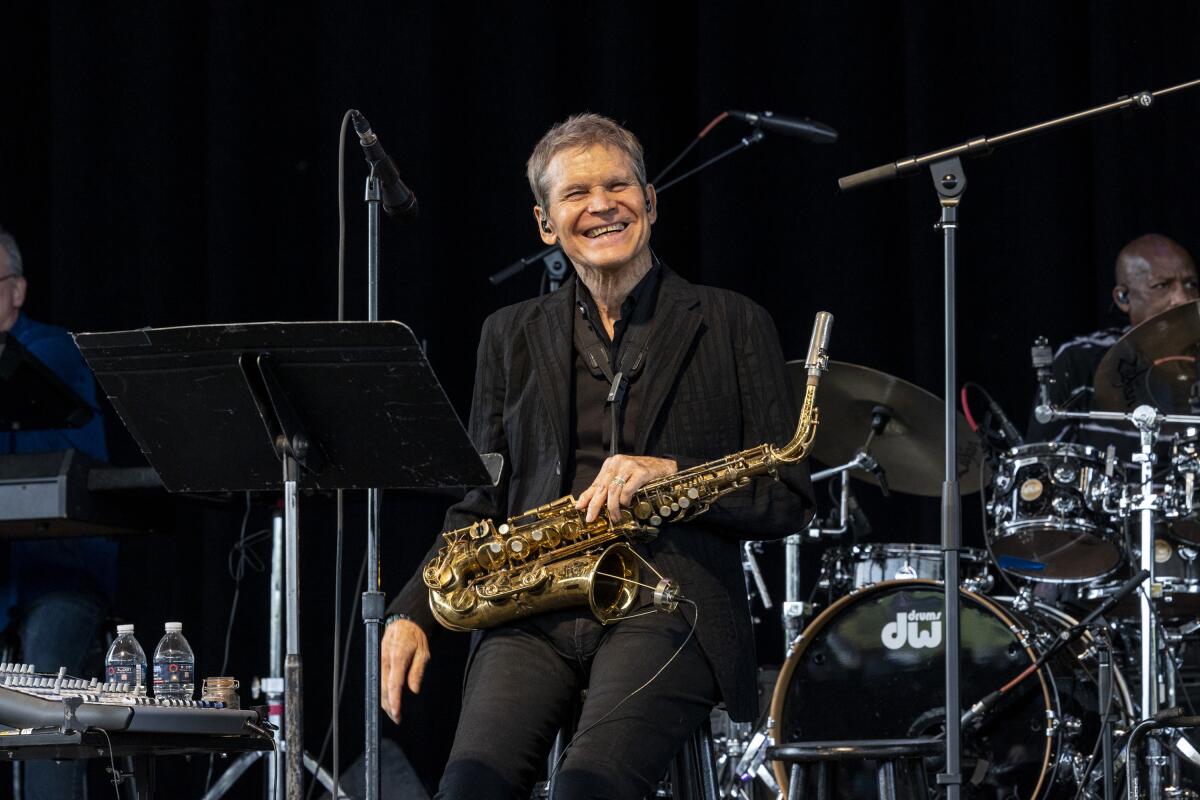
The alto sax great was a solo star with six Grammy wins. A much in-demand studio musician, he collaborated with Stevie Wonder, David Bowie, James Brown, the Rolling Stones, Linda Ronstadt, Bruce Springsteen and many more
- Show more sharing options
- Copy Link URL Copied!
David Sanborn, one of the most popular and influential saxophonists of the past 50 years, died Sunday after an extended battle with prostate cancer. He was 78 and had performed as recently as January. His death was announced on his social media sites: “Mr. Sanborn passed Sunday afternoon, May 12th, after an extended battle with prostate cancer with complications.”
Sanborn performed dozens of times in San Diego over the years. He was a favorite with audiences at Humpheys Concerts by the Bay, where he rivaled B.B. King and America as one of the venue’s most frequent and popular performers.
Sanborn’s solo career ignited in the 1980s, but — both before and after that time — his versatility made him one of the most in-demand alto saxophonists in a multitude of genres. His many collaborators ranged from Stevie Wonder, David Bowie, the Rolling Stones, James Brown and Linda Ronstadt to Roger Waters, Bruce Springsteen, Todd Rundgren and such jazz such jazz greats as Gil Evans, Charlie Haden, Jack DeJohnette, Julius Hemphill and Bobby Hutcherson.
“What I do is an amorphous combination of styles that has elements of bebop, R&B and rock,” Sanborn said in a 1985 Union-Tribune interview. “Categorization tends to limit you to specific idioms and that’s not good for your growth.”
A Florida native, Sanborn was born July 30, 1945, in Tampa. He grew up in St. Louis, where — by his middle teens — he was performing in the bands of such blues greats as Little Milton and Albert King.
He attended Northwestern University and the University of Iowa before turning his attention to music full time.
In 1969, at the age of 24, Sanborn performed at the legendary Woodstock festival as a member of the Butterfield Blues Band. In 1972, he toured the nation as a member of Wonder’s band. In 1975, he played in the “Saturday Night Live” house band for the show’s first season. In 1989 and 1990, he hosted the eclectic NBC show, “Night Music,” which saw him play alongside everyone from Al Green, Dizzy Gillespie, Betty Wright and Joe Cocker to Latin salsa master Eddie Palmieri, Boz Scaggs and Puerto Rican cuatro player Yomo Toro.
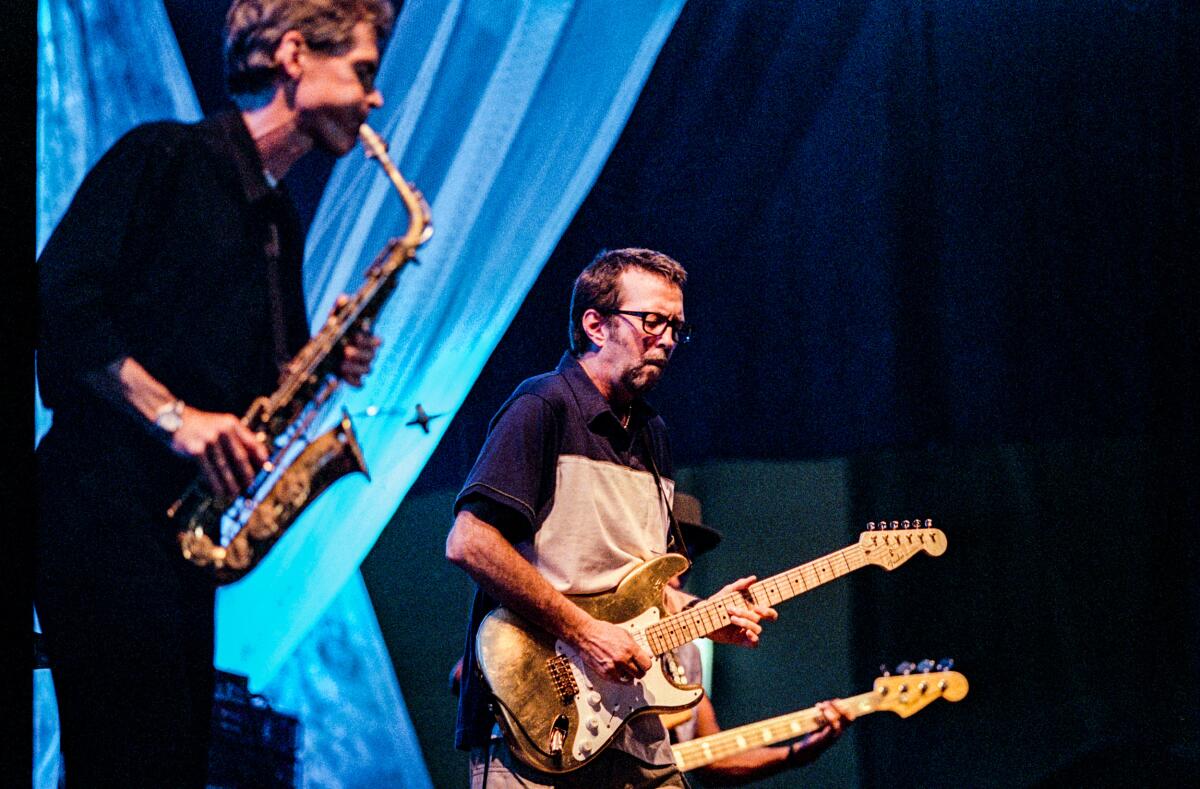
“Nobody wants to take chances anymore, and that’s what this show is about. We take chances, and that’s what people respond to,” Sanborn said in a 1989 U-T interview.
“We’re trying to put on music that you wouldn’t normally see on commercial TV . We want to present an eclectic mix that also gives some historical perspective to the music so that we can give an overview that music is one continuous thread — a tree with a lot of different branches that are all entertaining.”
As a solo artist, Sanborn became a pillar of smooth-jazz in the 1980s. He managed to become one of its biggest stars while rising above the genre’s stifling restrictions and cookie-cutter formulas. The grace and grit be brought to his soulful playing enabled him to consistently shine.
“I play the kind of music that gets me off; it’s really that basic,” Sanborn told the U-T in 1995. “What gets me off are things that appeal to me on a lot of different levels. And the older I get, the more I appreciate different things. Sometimes it’s hard to reconcile all those things into one.”
In a 1996 U-T interview, Sanborn reflected on the most valuable musical lessons he learned from working with his many legendary collaborators. Here are excerpts from that conversation:
Albert King: “Phrasing and time. I was 15 years old, I wasn’t very experienced, and here was a guy who was physically imposing, to say the least, and had such a powerful presence as a musician. I’d been playing only four years, so I felt fortunate to be in his company. He didn’t throw me off the stage! He tolerated me.”
Paul Butterfield: “Again, phrasing, and sound. Paul had the best blues harp sound I’ve heard; I don’t think anyone else has come close. I learned a lot from him, about sound, using the amp, microphone technique and phrasing.”
Q: Didn’t you play the Woodstock festival with Butterfield in 1969?
A: “It was overwhelming. We were on the road, and had done a lot of gigs. Obviously, no one had any notion that we’d be playing at what turned out to be a historic event. After the fact, everyone started writing about it as a watershed event. And it was like, ‘Gee, how about that?’ When in fact, to us, it was a congregation of a half a million people in a muddy field in New York.”
Stevie Wonder: “On just a technical musical level, I learned a lot about phrasing and the way he used grace notes. I really like the way he did that as a player and a singer. Plus, he was probably the most powerful singer I’ve worked with; his talent is just prodigious. What impressed me about him is, after each gig, he’d have all these keyboards brought up to his room and he’d work all night. And he taped everything. His work ethic really inspired me; he never stopped.”
Todd Rundgren: “He’s one of those Wunderkind people who is so talented in so many areas, and so smart. He was the first musician I’d come in contact with who was a master of the (recording) studio, and that was really impressive.”
David Bowie: “I learned a lot about the theatricality of stage performance, and what an important factor that was. Because I had really come from an era of not anti-performance, but that it was not hip (to be theatrical) and that you let the music speak for itself. From Bowie, I learned that it was a valid tool to use, to whatever degree, and that it would in fact enhance the music. And he was a great songwriter and had a tremendous work ethic. He was a fountain of creativity.”
Q: Bowie told me that he really enjoyed the electronic effects you used on your sax when you played with him. How did you like them?
A: “That was imposed on me. We were in the studio, using wah-wah pedals and different kinds of effects. I always felt very intimidated by studio hardware. To be honest, learning the instrument was so hard, and staying on top of it was so time-consuming, that I felt I didn’t have time to do the other stuff.
“I’m not one of those people it comes naturally to; I have to work hard to maintain whatever ability I have. I felt a little intimidated by all the hardware —- it seemed to pull me away from the music.”
Linda Ronstadt: “Linda has a great voice, really powerful. She’s one of those people who’s innately musical. As good as people know she is, she’s even better than that. And she has an innate musicality where she just doesn’t make the wrong choices.”
James Taylor: “James is one of the great songwriters, and so prolific. What’s always been great for me, working with so many singer-songwriters, is a chance to be close to them, and having the opportunity — night after night — to hear them and see the little changes they make. To see how they approach the same songs, and how a melody could go one way or another each night.”
James Brown: “He has been such an influence on me. I was impressed by just how funky he was, where he put the notes, his power as a singer and his time. What I learned most from Stevie, James Brown and Albert King was their time — where they put notes.”
John McLaughlin: “John is just overwhelming, on the technical side and the musical side. He’s got his own take on being funky. He’ll do something that is almost perfect, and then he’ll (mess) it up in a way that’s so interesting and musical, and make it personal.”
Gil Evans: “I learned so much about melody, and the fact that — even in a large ensemble — every part can be the melody. And what’s so great about Gil’s arrangements is that, whatever part you played — even if it was fourth tenor saxophone — you really felt like a part of the music.”
Paul Shaffer: “Paul is just a wealth of musical knowledge. He’s like the encyclopedia of pop music. He seems to know every tune ever written, and has such a quick mind.”
Eric Clapton: “Eric is another one of those people that is just innately musical. All he has to do is play one note, and you know it’s him. I think that’s a mark of a real creative individual.”
Hank Crawford and David Newman: “I think early on Hank was more of an influence. But they both were, because they were both playing sax with Ray (Charles). I think, initially, Hank was more of an influence because there was a certain spareness, elegance and a cry to his sound I picked up on. His ‘From the Heart’ album, which I listened to over and over, was a huge influence.”
Q: Didn’t you use that title for one of your own albums?
A: “Yeah, but it was subconscious.”
Julius Hemphill: “What I liked about Julius was his ecumenical spirit. He was very nonjudgmental about styles, whether classical, rock, funk, jazz or Sousa marches. Whatever he could use to his benefit he would, and that attitude about music had the most profound effect on me.
“All of these people we’ve discussed, the running theme is that they had such a complete musicality. They saw music as a great universe, and not just a little window.
“Of course, people who came a generation before me would say: ‘I’m glad I came up when I did.’ It’s a matter of perspective, and it’s all a continuum. Creativity doesn’t die with a generation. There was a certain kind of openness about styles back then, and people were more willing to cross over. But musicians are always looking to cross over to other idioms. I want to avoid any implication that that time was better than this. It was great, but it was just different.”
Get U-T Arts & Culture on Thursdays
A San Diego insider’s look at what talented artists are bringing to the stage, screen, galleries and more.
You may occasionally receive promotional content from the San Diego Union-Tribune.

More from this Author
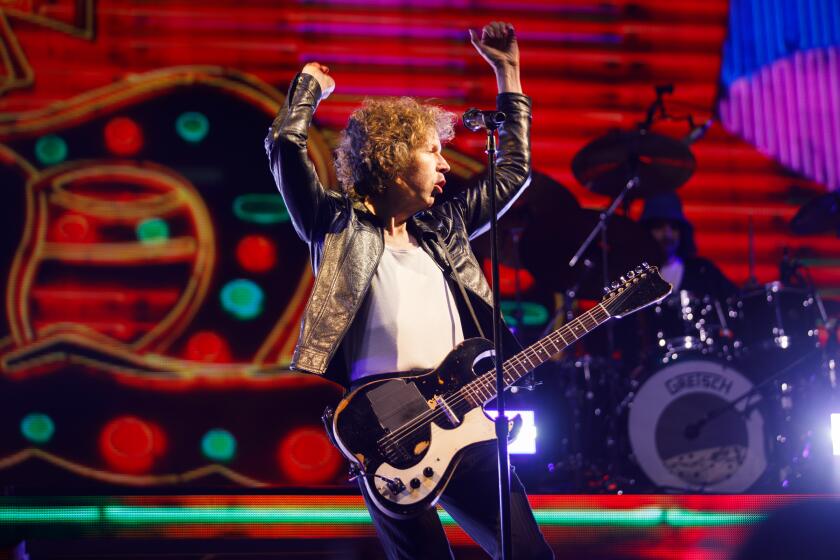
Wonderfront festival concludes with a bang, thanks to The Roots, Beck and Steel Pulse
May 13, 2024
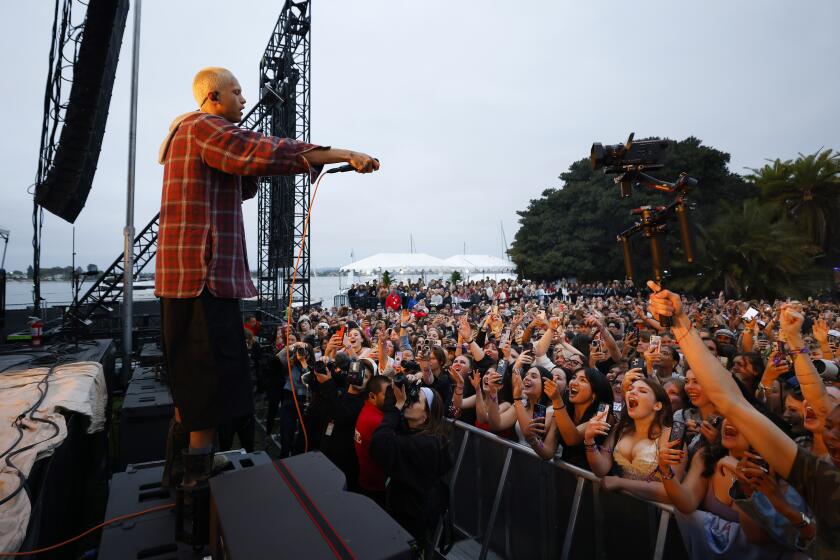
Wonderfront festival delivered the hits Saturday on a night when the San Diego Padres went scoreless
May 12, 2024
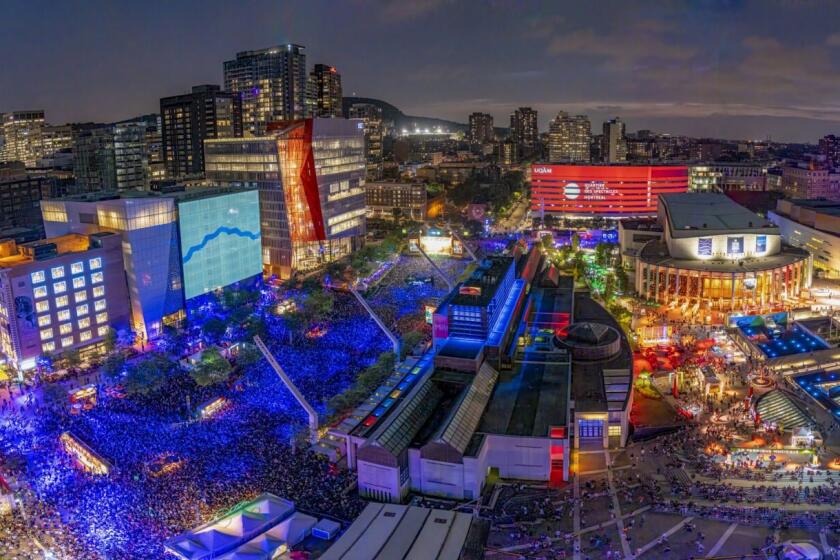
Montreal Jazz Festival a treat for music fans of multiple genres — and a bargain, with 150-plus free concerts
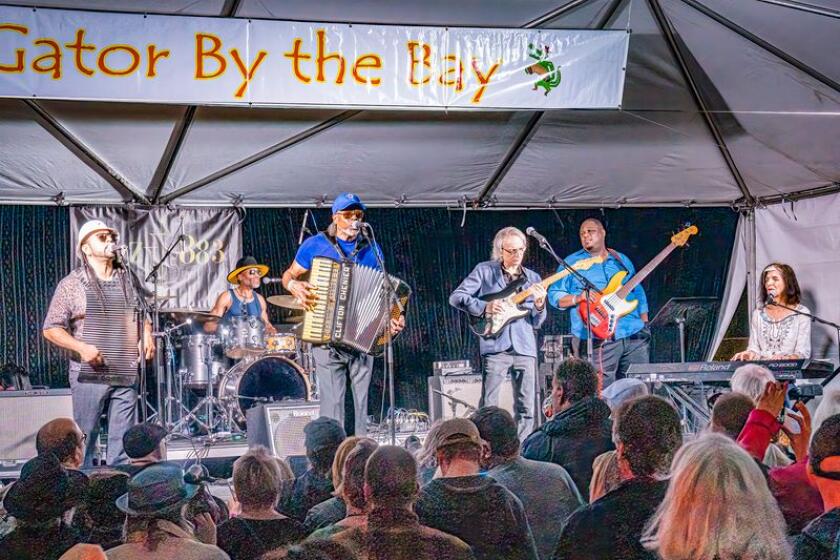
Gator by the Bay’s rousing tribute to zydeco-music giant Clifton Chenier a night to remember
May 11, 2024
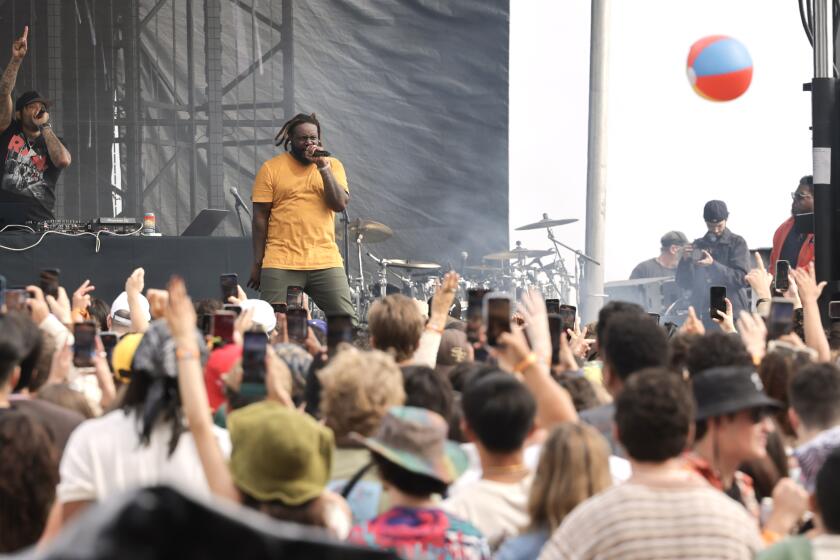
Wonderfront music festival has returned to kick off its next wave
May 10, 2024

This weekend’s three don’t-miss San Diego-area concerts
May 9, 2024
More in this section
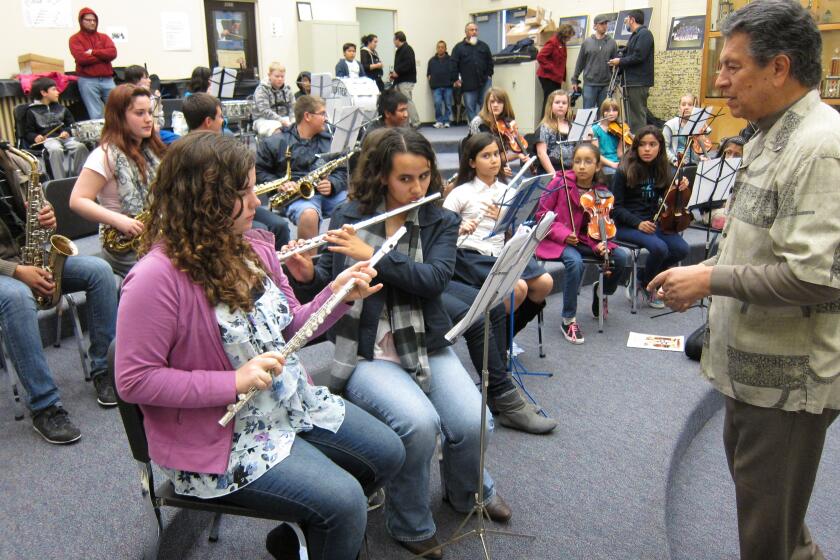
Entertainment
Arts & Culture Newsletter: Free music program for San Diego students hosts spring recital Wednesday
This week, Tanya Tucker in El Cajon, Fiesta Del Sol in Solana Beach, Hitchcock back in local cinemas and more
May 16, 2024

Les Ballets Jazz Montréal sets the music of Leonard Cohen to dance
La Jolla Music Society is presenting the ambitious Canadian dance program at the San Diego Civic Theatre on Wednesday
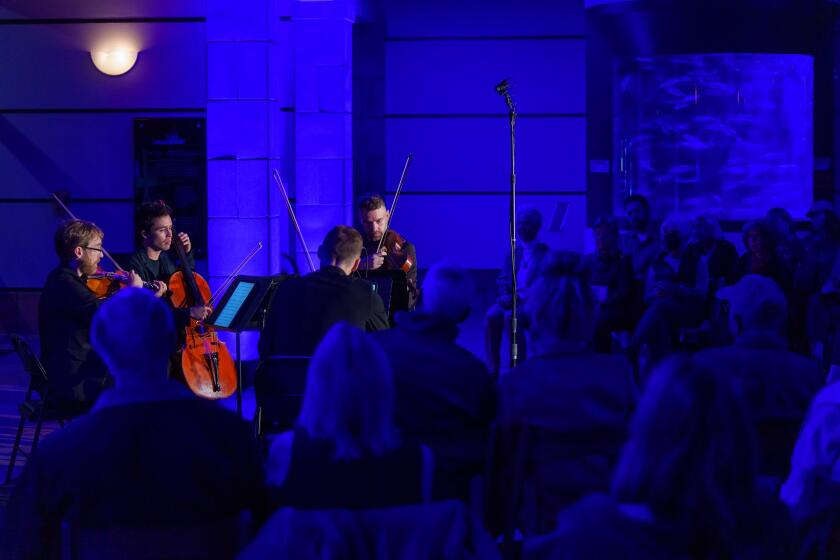
Classical Music
Review: JACK Quartet concert combined 20th century moderns with 21st century eclectics
Last-minute venue change to the Birch Aquarium proved no obstacle to the expert performances
May 8, 2024
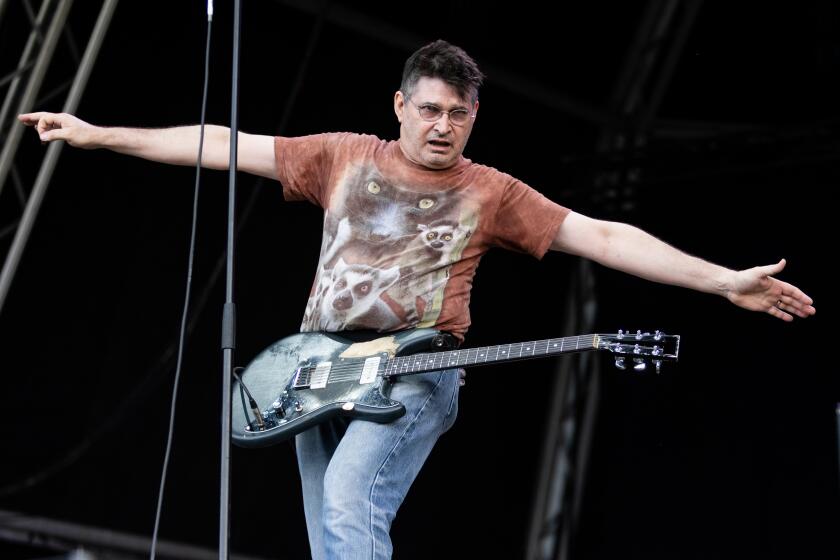
Nation-World
Steve Albini, legendary producer for Nirvana, the Pixies and an alternative rock pioneer, dies at 61
Albini, who was prepping for a tour with his band Shellac, passed away from a heart attack on Tuesday night
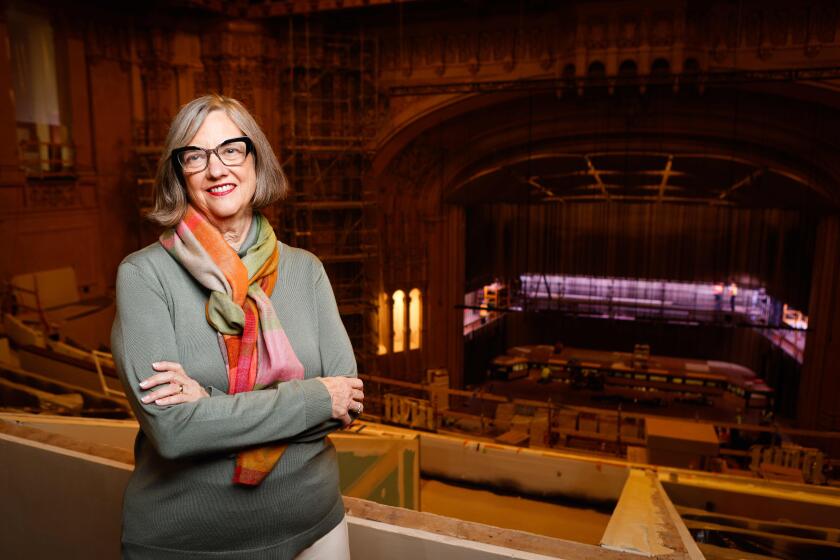
San Diego Symphony announces 2024-25 season at newly renamed concert hall after $125 million redesign
The 95-year-old venue, now named Jacobs Music Center, will boast improved acoustics, a new sound system, a permanent elevated choral terrace at the rear of the reconfigured stage, and much more, while retaining its historical essence.
May 7, 2024
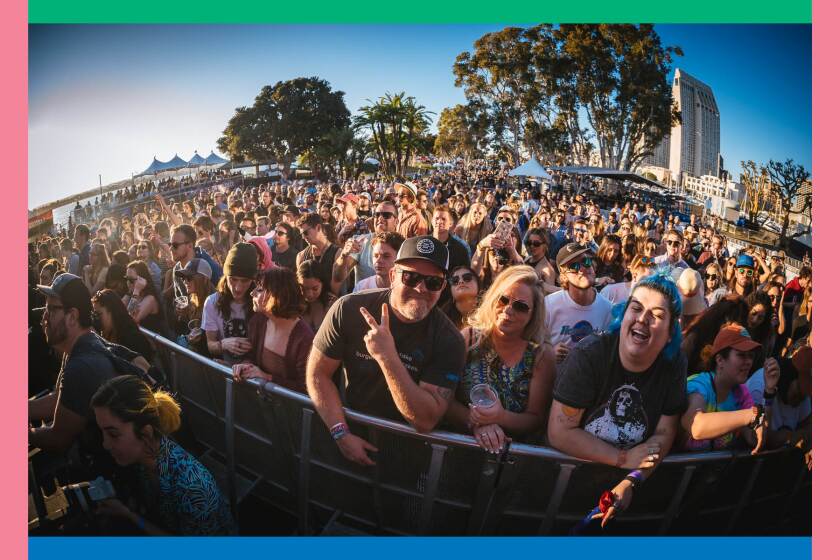
Wonderfront returning to San Diego this week as landscape for music festivals grows increasingly challenging
A record number of festivals have recently been canceled, postponed or gone out of business, while Coachella’s attendance has gone down for the second consecutive year. What does it take to buck the trend? Will Wonderfront’s lineup do the trick with Kaytranada, Beck, Weezer and The Roots?
May 5, 2024

IMAGES
VIDEO
COMMENTS
The Rolling Stones' 1969 Tour of the United States took place in November 1969. With Ike & Tina Turner, Terry Reid, and B.B. King ... This was the Rolling Stones' first US tour since July 1966, with the absence partly due to drug charges and subsequent complications.
Rolling Stones "Storm America" - US Tour 1969. The Stones make a claim for the high ground in 1969 with the Beatles broken-up and a new guitarist in the band whose main purpose is to facilitate touring and live performance which would have otherwise been doubtful with founding member Brian Jones whose ability to freely enter the US (drug busts) and play grueling consecutive nights and two ...
Complete audio of The Rolling Stones Let It Bleed Tour at the International Amphitheater, Chicago, USA (late show). The Rolling Stones American Tour 1969 too...
By Jerry Hopkins. December 22, 1969. British rock band the Rolling Stones after the death of founder member Brian Jones, in 1969. Len Trievnor/Express/Getty. L OS ANGELES — Mid-way through the ...
December 27, 1969. Mick Jagger on the cover of Rolling Stone Baron Wolman. SAN FRANCISCO—All that remained for the Rolling Stones was the big free concert they had vaguely promised since they ...
The Rolling Stones' tour of North America in late 1969 was their first since the summer of 1966 and it was their first anywhere since the spring of 1967.They had of course played the huge free ...
The 1969 American tour saw the Rolling Stones play for an average of 75 minutes each show, with many concerts lasting past midnight. Everything was designed to draw the audience into the act. Monck designed a proscenium stage backlit with lights that changed color to suit the songs' moods, and concealed the speaker towers by draping them in ...
The Rolling Stones' 1969 Tour of the United States took place in November 1969. With Ike & Tina Turner, Terry Reid, and B.B. King (replaced on some dates by Chuck Berry) as the supporting acts, rock critic Robert Christgau called it history's first mythic rock and roll tour, while rock critic Dave M ... The Rolling Stones' US Tour 1978 was a ...
The Rolling Stones American Tour 1969. The Rolling Stones. Read more about The Rolling Stones; The Rolling Stones. Read more about The Rolling Stones; Altamont Free Concert. ... 12/06/1969: The Rolling Stones, Crosby, Stills, Nash & Young, The Flying Burrito Brothers, Jefferson Airplane, Santana:
Audio of The Rolling Stones 1969 US Tour at the Arizona Veterans Memorial Coliseum, Phoenix, USA.The Rolling Stones American Tour 1969 took place in November...
00:00 Midnight Rambler09:15 Satisfaction15:15 Im Free25:33 Brian Jones TRIBUTE28:00 Mariposas 30:35 Jumpin Jack Flash34:14 Country Honk37:30 Love In Vain42:1...
Get the The Rolling Stones Setlist of the concert at The ... CA, USA on November 8, 1969 from the Let It Bleed Tour and other The Rolling Stones Setlists for free on setlist.fm! setlist.fm Add Setlist. Search Clear ... Rolling Stones Kick Off Tour with a Classic Never Performed in US. Apr 30, 2024. Five Live Pieces of Vinyl to Snatch Up on ...
Ethan Russell: Let It Bleed: Mick being touched in Oakland. Courtesy of Let It Bleed, the book, text and photographs by Ethan Russell. Available from Rhino.
The Rolling Stones' stage manager on the 1969 tour, Chip Monck, explained that "the stage was one metre high - 39 inches for us - and [at Sears Point] it was on the top of a hill, so all the audience pressure was back upon them". Because of the short notice for the change of location, the stage could not be changed.
The Rolling Stones - 1969 North American Tour. 680 likes · 8 talking about this. This page is dedicated to the history and music of The Rolling Stones 1969 North American Tour: Nov. 7 - Dec. 6, 1969.
The Rolling Stones concert at Washington-Grizzly Stadium in Missoula, Montana on 4 October 2006. Since forming in 1962, the English rock band the Rolling Stones have performed more than two thousand concerts around the world, becoming one of the world's most popular live music attractions in the process. The Stones' first tour in their home country was in September 1963 and their first ...
The Rolling Stones made multiple appearances on the The Ed Sullivan Show in the 1960s:. On October 25, 1964, the band performed on The Ed Sullivan Show for the first time to promote 12 X 5, which had been released eight days earlier.; On May 2, 1965, The Rolling Stones performed "The Last Time," "Little Rooster," and "Someone to Love," despite Ed Sullivan's reservations about ...
THE ROLLING STONES 1969 US TOUR. Get Your Ya-Yas Out The Legendary Apple Acetate Recorded live at the Madison Square Gardens, New York, November 28th 1969 CD, RS-Apple Promo. Stoneaged Live in San Diego, Sports Arena, November 10th, 1969 CD, World Productions Of Compact Music, Italy, WPOCM 1189 D 043-2.
In a post-tour interview with Rolling Stone, Graham compared the Rolling Stones to the 1969 "Miracle" New York Mets, a team that had been a perennial loser since its first season in 1962 but ...
Richard Havers. Photo: Peter Sanders/Redferns. At London's Hyde Park, on July 5, 1969, at 5:25 PM, there was a moment that has come to define The Rolling Stones. "The greatest rock and roll ...
While The Rolling Stones initially recorded "Wild Horses" in 1969, they wouldn't put out the song until it appeared on 1971's Sticky Fingers due to legal issues. "Wild Horses" was ...
The Rolling Stones drew 7,500 hysterical teenagers, including Alice Cooper, to Veterans Memorial Coliseum in 1965. Fans remember "show of a lifetime."
F or the first time in five years, The Rolling Stones returned to Seattle to perform inside Lumen Field to a crowd full of rock and roll fans.. The stones are iconic. A lot of us travel to see ...
The Rolling Stones' first US tour in June 1964 was "a disaster", according to Wyman. "When we arrived, we didn't have a hit record [there] or anything going for us." ... Cotchford Farm in East Sussex, in 1969. The Rolling Stones Rock and Roll Circus, which originally began as an idea about "the new shape of the rock-and-roll concert tour", was ...
The Rolling Stones' Hot Rocks 1964-1971 is climbing the charts following the beginning of their new Hackney Diamonds Tour across the United States and Canada.
The first Rolling Stones tour with Mick Taylor in late 1969.
But the Rolling Stones have done as much as anyone to help define a rock 'n' roll aesthetic that thrives on the rawness and reckless abandon at the heart of what they do. This is especially ...
Pangia is a hard-core Stones fan, who is hitting 10 shows on the band's 16-city U.S. tour. Her 1969 Chevrolet Camaro convertible is covered in thousands of Stones tongues with a license plate ...
Marlon considers his own response to Catching Fire 's testament to his blazing mother. "The directors found a poignancy and sadness in my mum's inability to be in control of her life, for a ...
The alto sax great was a solo star with six Grammy wins. A much in-demand studio musician, he collaborated with Stevie Wonder, David Bowie, James Brown, the Rolling Stones, Linda Ronstadt, Bruce ...